If you would like a printed copy of any of our back issues, then they can be purchased on Farm Marketplace. You can also download the PDFs or read online from links below.
-
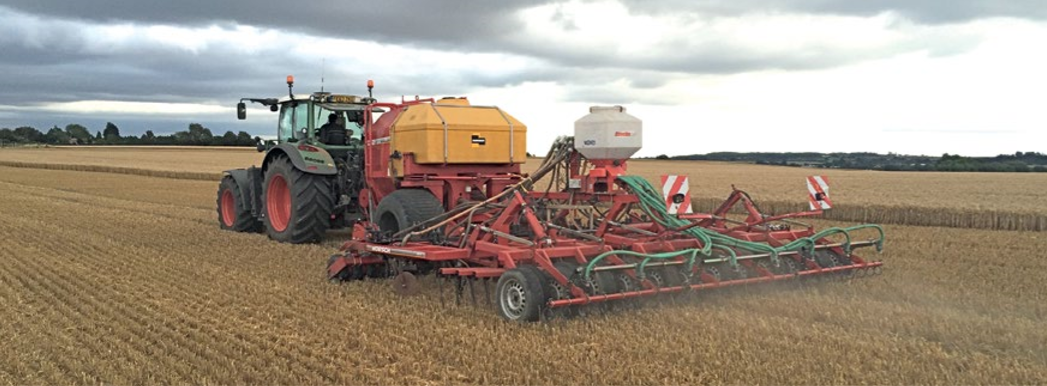
How To Start Drilling For £8K
Clive Bailye’s seed drill of choice is his 6m John Deere 750A , which has been used exclusively for 3-4 seasons. Last year, with an increased acreage, the founder and publisher of this Direct Driller magazine thought a second seed drill was necessary. Having just the one machine was a risk and in a difficult season would mean drilling was delayed. He looked around and found a good condition Horsch CO6 tine drill advertised in Germany.
Words and pictures by Mike Donovan
After delivery he rebuilt the coulters to a narrow profile so as to reduce soil disturbance. He says the tine drill is very useful driling after straw crops such as osr and also through the straw on second crop cereals.
Buying the drill from a German farmer was not particularly complicated, and provided him with a higher spec machine than Horsh sell in the UK. The seed dart tyres are much wider, and the machine is fitted with blockage monitors as well as full width front packers and also a liquid fert application system.
A sheaf of photos were taken, and Clive then asked for some of specific parts to show wear. The deal was done at under £5,000 which Clive says is the market value of these machines which are too large for small farmers to buy. Original owners like to buy new and sell when the machine is still in good condition.
Narrow tines with wear tiles
@Clive knew he wanted to make changes, substituting the Horsch tines and coulters for something far narrower, and has ended up getting his own design of tine made, which has a wear tile made from Ferobide, far harder than tungsten. The drill is on the farm primarily for osr and 2nd crop cereals drilled into chopped straw and the 25cm spacing is okay for these crops.
Comments on Clive’s on-line forum, TFF, said the drill many not be so good with beans, as the slot is a mere 12mm wide. And in barley the spacing may well be too wide as it needs to be thick. Clive points out that the seed pipe can actually be a bit wider than 12mm as it is in the shadow of the point. It would be good to have the option of using it for beans.

Above left: The cheap CO6 is being calibrated ready for its first outing

Above right: The adapted Horsch is being filled by the home built drill logistics trailer with seed and liquid starter fert.
Getting around the German instructions
The Horsch came, of course, with a control box and instructions in German. More on-line discussion revealed that English instructions were available on the Horsch website, and another explained that Horsch was sourcing some of these parts from Agton in Canada anyway. Zealman from New Zealand explained that the button marked with callipers should be held down for around 5 seconds. The menu is where you adjust the tramline sequence, valve layout and row numbers.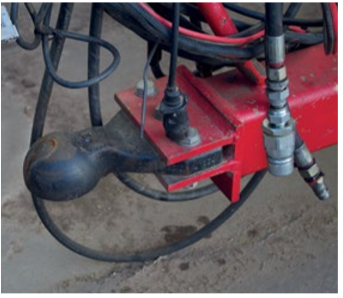
Ball hitch is a continental standard and provides a positive connection between tractor and drill

The Stocks Wizard has a rotor modified for Avadex which otherwise leaks everywhere
A Stocks Wizard is on the back of the drill and used for Avadex. Here again the knowledge of actual farmers is helpful. Alistair Nelson warned that the rotor and the surrounding shroud need to be changed, and he got good advice “from Rick at Stocks”. Clive has the same setup on the 750A and says that the Avadex leaks everywhere unless the modification is made. The drill was acquired and modified in 2016 and the results have been excellent.
The machine went through the residue without many problems and having the second drill has meant more timely planting. Clive has shown that moving into No-Till is not the expensive exercise so many farmers think it might be. The total cost, after modifications which included replacing all tines and coulters, was under £8,000.
Author Mike Donovan writes: we have featured a number of home made direct drills in @Practical Farm Ideas, and are always interested in seeing more. Please contact mike editor@farmideas.co.uk or 07778877514.
-

Why a French farm has turned predominantly to livestock
On a recent BASE-UK trip to France, a visit to Christophe Piou’s farm showed how you don’t have to follow the herd to be successful
By Mike Abram
Surrounded by high value vegetable production and arable farms in the Loire Valley is what is now predominantly a livestock farm.
It wasn’t always that way. When Christophe Piou started farming in 1999 the farm was an arable farm but gradually over the past 20 years livestock have become an increasing part of the farm.
Although from a farming family, prior to 1998, Christophe worked as an accountant for eight years. But after studying agriculture for a year in 1998, he bought a 110ha farm in Saint-Claude-de-Diray, close to Blois to the south of Paris, around 15km away from his father’s 140ha farm, which they ran in partnership.
The two had very different soil types. Christophe’s farm is on sands, so the main concern is drought, although he has access to irrigation. On his father’s farm, which he now runs, the soil is sand overlying clay. Here, excess water particularly in winter is the challenge, as the clay pan underneath stops the water from draining away.

Christophe Piou “The yield potential is very low,” Christophe says. “So we had to cover a large area in order to secure an income, meaning we were also doing another 200ha of contract work.”
Christophe’s accountancy background also meant he approached farming with a financial management perspective. A minimum or zero tillage system was partially adopted, due to the savings in machinery and labour costs, with a trip in 1986 to direct drilling demonstration with his father laying the foundations for the switch.
That was consolidated after meeting Frédéric Thomas, a pioneer in conservation agriculture, in 2001, who farmed around 25km away and was looking for a partner to help on his farm while he was away from home.
“On our first meeting we took a spade around the farm, and it was the first time I’d been around the field with a spade as a farmer,” Christophe admits.

Frédéric Thomas “We discovered a plough pan on which water was sitting at a depth of 25-30cm, and also a power harrow pan. Both were affecting rooting of the winter crops and a good explanation of the low yield potential.”
A comparison with Frédéric’s own farm which at that stage was around five years ahead in using conservation agriculture practices further highlighted to Christophe the obvious difference.
He also used every BASE France trip possible to increase his knowledge base both from the farmers and advisers they visited but also the other people on the trip.
“During the next 10 years we increased our soil organic matter content from 0.8 to 2.5%. We went from zero cover crops to 100% cover crops, from 200kg to 2t/ha of earthworms.
“It was working well economically until around 2007 when the wheat price jumped sky high, expenses followed and then the wheat price crashed, making the economics difficult.”
But the final straw was in 2016, when 200mm of rain in June caused floods in much of the wheat growing land south east of Paris, including the Loire Valley and most of Christophe’s 260ha of crops. “Winter wheat yields were 2t instead of 6t/ha, durum wheat 1t instead of 5t/ha. I lost €200,000 of turnover, and the accountant was not insured.
“Today, I learn, I told myself. If we are able to lose €100,000 in farming, this means if we are smarter, we can make €100,000.”
But it has required a pretty big shift in system. Again, the plan had its roots in an earlier BASE France trip – this time to North and South Dakota in the US, although ironically it was there, he and Frédéric first heard of a French biochemist and farmer, André Voisin, and his theory of rational grazing. Voisin developed in the 1950s what have effectively become the principles for most modern rotational grazing systems.
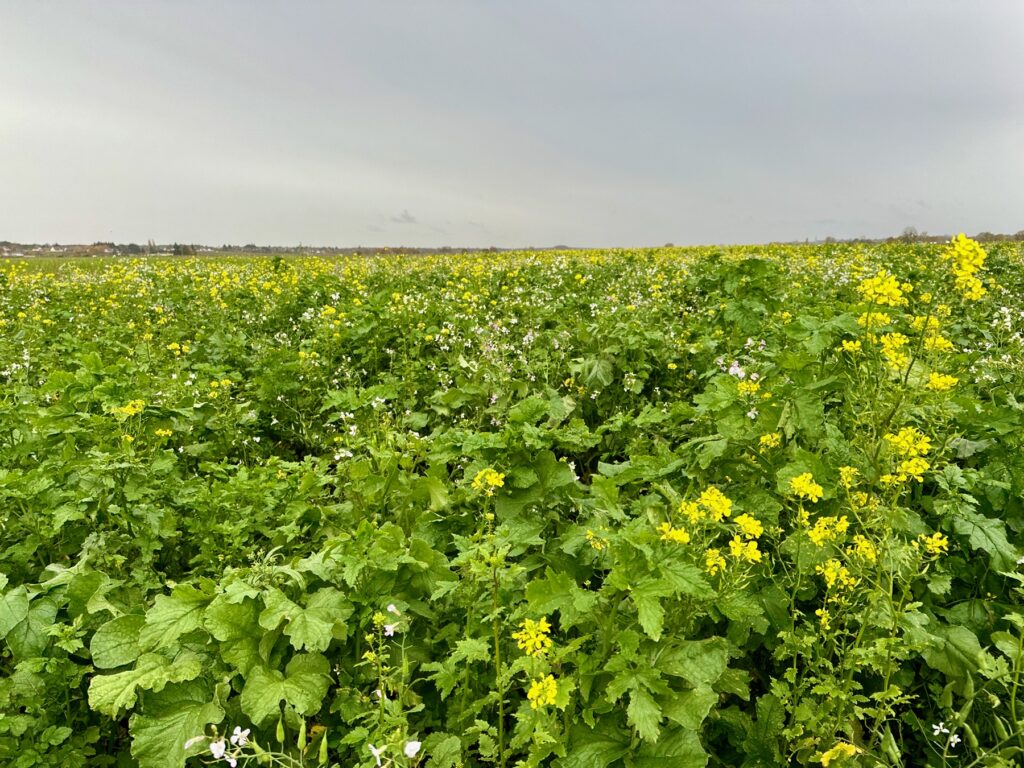
Multi-species cover crop “We had to go all the way to the US to hear about a famous French guy we didn’t know, but some of the farmers knew a lot about him and his teaching about how to get grass and cow working well together.”
It became the moment when Christophe knew he had to bring animals back on the farm as he had lots of food available thanks to the cover crops.
Following that trip he started to look for someone who could manage livestock on his farm, but it took three years until he found someone suitable – Jose, a security guard, who was keen to change careers.
Despite the drawback that Jose knew nothing about sheep, Christophe bought 50 sheep and Frédéric provided 5ha on which to feed the sheep as a one-year trial. It went well and by the time of the 2016 floods Jose had expanded to 150 ewes, plus some of his own land.
The experience gave Christophe the idea that he could develop a system with sheep or cattle outside all year round, which would be more profitable and more resilient. “I went to New Zealand and saw a farm with 400ha with 2000 sheep and some cows, and the farmer was able to make €200,000 net after income tax without any subsidy, and it seemed quite easy. In our system, we have a €100,000 support payment on top.”
From the initial 50 ewes in 2015, he now runs 1400 in total – 400 of which belong to his son, who came back to farm in 2020. “We only grow 100ha of crops out of the 400ha total farmed.”
The sheep enterprise helps organise the rotation. Around 100ha of the farm is growing lucerne, which is grazed from April to the end of October.
“Many people think you cannot graze lucerne because of the risk of bloat,” Frédéric points out. “But when the animals are used to it and when you manage the animals it is possible.”
The drought-tolerance of lucerne with its deep rooting is vital, as summer growth is difficult to achieve in the region with most forage. “Conventional pasture is burned from May to October, but with lucerne, albeit with potentially a little bit of irrigation in the summer, you have production, you have nitrogen, and then organic matter and soil fertility build up.”
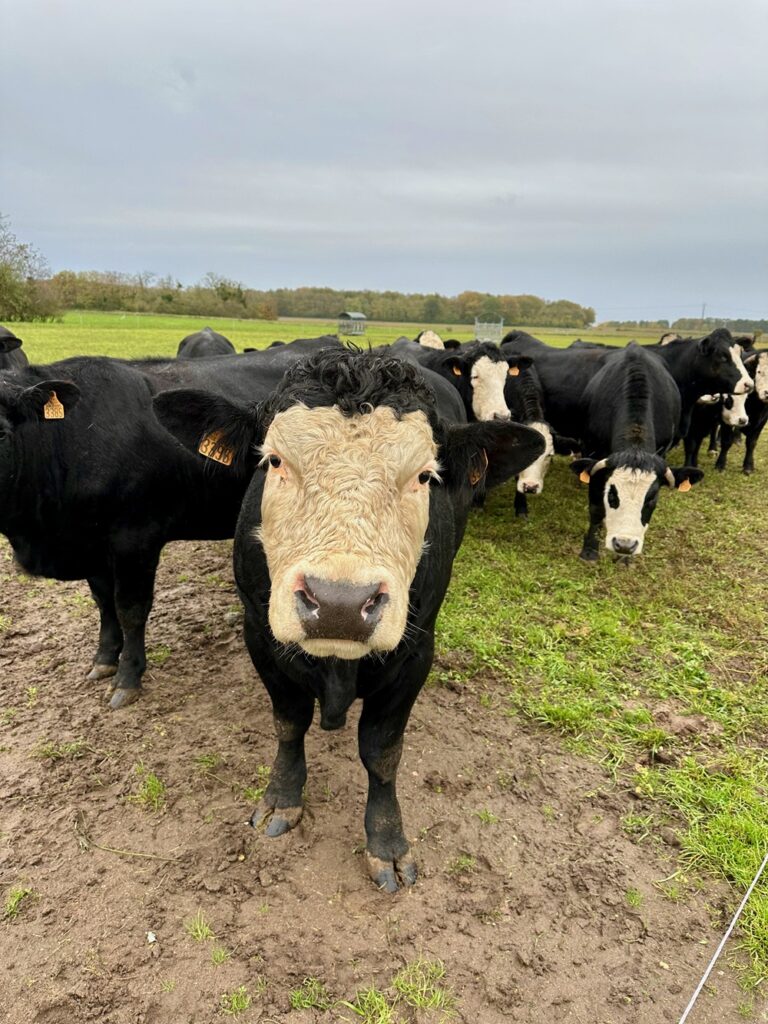
Angus Montbeliarde cross cattle It’s usually in a field for three to five years before it needs replacing, playing an important role in helping to clean up fields when weed problems have arisen, including ryegrass.
“When there is a weed problem instead of trying to grow an arable crop, you grow forage, clean it up and then start again, if you want to,” Christophe explains.
Overwinter the sheep mob-graze multi-species cover crops, typically consisting of species such as chicory, vetch, various radishes, lucerne and plantain. He splits the sheep into mobs of ideally just 50, although some mobs are up to 120. Typically 50 sheep will graze 2,500 sqm in two to three days up to 5,000 sqm in four days before being moved on.
Rotational grazing helps keep the need for wormers to a minimum. “We use no wormers on the ewes. On the young ones after weaning, we use one or two wormers and then analyse the dung to see whether it is necessary.
“It’s a big advantage to keep some crops in the rotation because we can put the lambs where we have had no lambing and lower risk of worms. It’s important after weaning to keep the lamb away from where there was lambing or the mother and lamb were together.”
With around 100 fields in a 25km radius available for grazing, he finds keeping the mob numbers low easier to manage and avoids having to transport groups across the farm. They also keep Christophe’s and his son’s sheep separate.
Some of the outer perimeter of the farm is now fenced, while temporary wire fencing is used elsewhere. Fencing the entire farm is one challenge Christophe is still facing. “We’ve got 10km of fence to put in. The next step will be planting hedges around and inside the farm to bring shade to the animals.”
Neighbouring farms also provide extra grazing Christophe can take advantage of with French farmers having to grow overwintered cover crops following crops such as wheat and barley before a spring crop.
“It’s compulsory by regulation because of nitrates,” Fréderic explains.
Around 25-33% of the captured nitrogen might become available to the following crop, dependent on weather and crop, he adds. “If it is dry in the spring, you might get very little back. If it is wet and warm, you will have more and then the rest will flow in the following years.”
Grazing will increase the speed of that nutrient return, not the amount. “Many people will think they increase the fertility with livestock, but no, you’re just speeding up the return.”
Lambing is outside in September. From the 1,400 ewes he sells 1,400 lambs each year at €100/ lamb net, he says. Remaining lambs are used as replacements and to grow the size of the flock.

Effect of lucerne lay (left) on following crop A more recent addition to the farm is the small herd of 30 Montbéliarde x Aberdeen Angus cattle, again kept permanently outside. Males and females were bought weaned at four months and are fattened for two years before slaughter. All meat, either lamb or beef, is sold direct to butchers or consumers, never to retail.
Christophe’s son also has both meat chickens and laying hens, again kept outside on pasture in mobile hen houses.
The key to Christophe’s system is basing animal production on soil fertility, Frédéric stresses. “One of the biggest mistakes made by many livestock farmers is they are driven too much by the size of the animals and the yield of the meat, but not thinking about the quality of the soil that will produce quality food from quality animals.
“Here, Christophe, thanks to direct drilling, increased the potential of his soil so he can produce a lot more biomass than conventional farmers would do, and then used that soil fertility and quality to change the way he farms animals.”
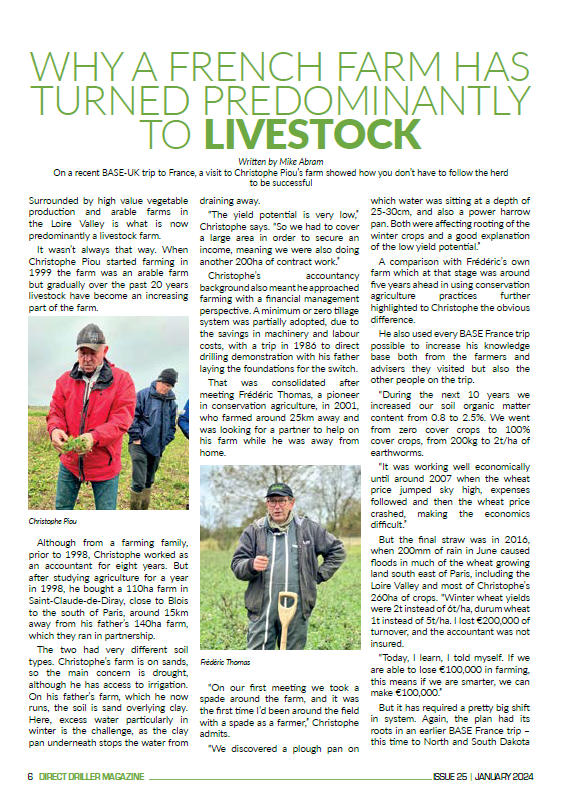
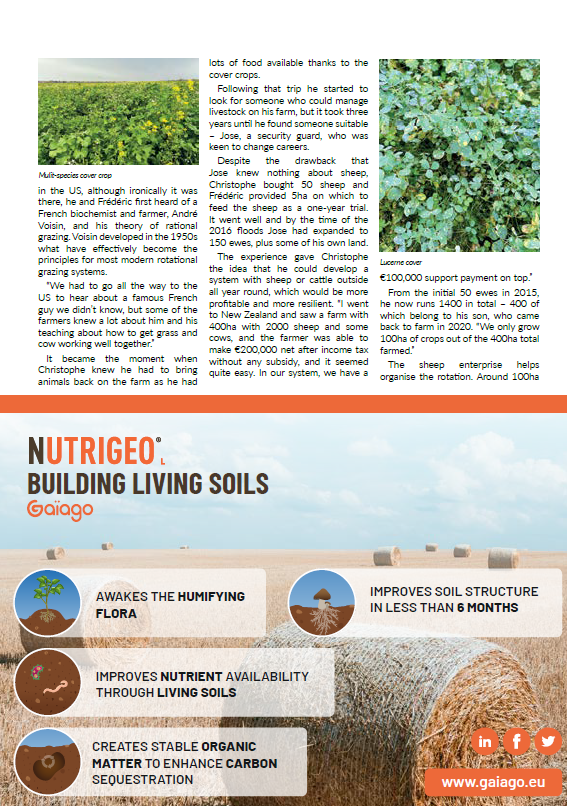

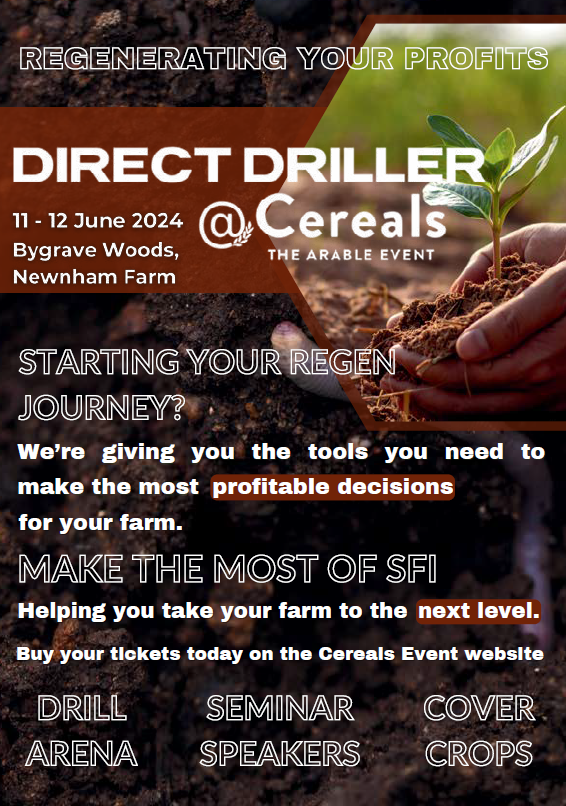
-
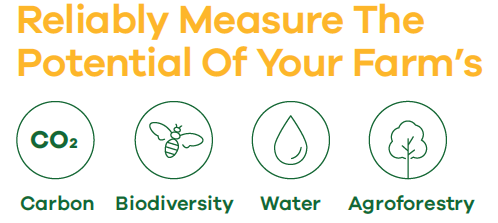
Principles of carbon footprinting 101
Written by Anna Woodley from Trinity AgTech
The concept of natural capital may seem distant and complex. However, it is a collective asset that everyone involved in agriculture should acknowledge and actively manage. From understanding the value of natural capital, to taking credible actions to reduce carbon footprints, farmers and land managers play a pivotal role in shaping a sustainable future. Here are our essential insights for carbon to help guide you on this inevitable journey.
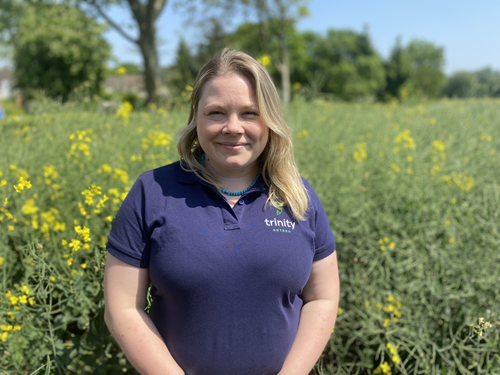
Anna Woodley from Trinity AgTech Calculating a carbon footprint for a farm means assessing the total amount of greenhouse gases produced directly and indirectly from farming activities, usually expressed in equivalent tonnes of carbon dioxide (CO2e).
Carbon dioxide equivalent (CO2e) is a yardstick measurement with a global warming potential of 1. Other gases have their potential expressed as the equivalent amount of carbon dioxide, usually expressed in million tonnes of carbon dioxide equivalents. Methane, for example, has a CO2e 28 times that of carbon dioxide. This means every 1m tonnes of methane released will be equivalent to emissions of 28m tonnes of carbon dioxide.
A carbon footprint calculation considers various sources including:
Direct emissions are emissions produced directly from farming activities. Examples include:
Methane (CH4) from enteric fermentation in ruminant animals. Nitrous oxide (N2O) from manure and fertilised soils.
CO2 from machinery and transport used in farm operations.Indirect emissions are emissions related to the production of goods and services used in farming. Examples include:
Emissions from the production of fertilisers and pesticides. Emissions from electricity used on the farm.
Emissions from the production of purchased feed.Carbon sequestration refers to the process by which farms absorb and store carbon, primarily through plants and soil. Certain farming practices can increase carbon storage, effectively offsetting some of the farm’s emissions.
The purpose of calculating a farm’s carbon footprint is to understand its environmental impact, identify areas for improvement, and implement practices to reduce emissions.
Baseline
The baseline establishes your farm’s annual emissions from current practices, which is crucial as any reductions from this point can generate credits. Incorporating historical management information is essential for realistic and credible reporting with Sandy.
Farmers have the option to input a minimum of one year’s worth of data, but it is advisable to establish a baseline spanning three to five years for more reliable and conservative carbon credit calculations that account for uncertainties.
Components of a farm’s carbon footprint
What is included in a carbon footprint can vary significantly based on the methodologies employed by the carbon footprinting tool and the standards it adheres to. Different tools might consider varied sources of emissions, have unique boundaries of assessment, or use distinct emission factors.
Moreover, the standards or protocols that a tool aligns with, such as the Greenhouse Gas Protocol or ISO 14067, further define the scope and precision of the calculation. Therefore, when evaluating or comparing carbon footprints, it’s essential to understand the underlying methodologies and standards.
Carbon standards
Adhering to rigorous standards in the creation of your carbon calculation, ensures the utmost accuracy and credibility in the assessments. Sandy by Trinity AgTech adheres to the highest standards.
IPCC 2019 Tier 2 and Tier 3 are advanced methods with high data and complexity demands. They’re viewed as more accurate if sufficient data is available.
ISO 14064-2 – quantification, monitoring and reporting of activities intended to cause greenhouse gas emissions reductions or removal enhancements.
ISO 14067 – quantification and reporting of the carbon footprint of a product, and the most comprehensive standard for carbon footprint reporting available.
Greenhouse Gas Protocol Land Sector and Removals Guidance standardises how companies measure and report their land-related GHG emissions and removals to accurately reflect their impact on climate. ISO 14067 provides good alignment with this guidance, and SBTi FLAG.
SBTi FLAG provides a standardised method for land-intensive sectors to set science- based targets, addressing the 22% of global emissions from agriculture, forestry, and other land uses.
PAS 2050 assesses the life cycle greenhouse gas emissions of products and services. While it’s largely been replaced by ISO 14067 and the GHG Protocol, some retailers still reference it.
Greenhouse Gas Protocol Product Standard – designed to understand, quantify, and manage greenhouse gas emissions.
Farmers have a great chance to boost profits and sustainability by delving into the world of carbon and natural capital. However, picking the right software for measuring and managing natural capital can be confusing. Some people liken the voluntary carbon market to the “Wild West” because they believe it lacks clear rules. They argue that the market’s unregulated nature, along with the varying prices and quality of carbon credits, reinforces this idea that there are no set guidelines for the developing carbon and biodiversity markets. But that’s a misconception.
The reality is that several standards exist to bring order and credibility to this field. While carbon reporting criteria can vary, there are international standards that ensure the credibility of carbon footprint reporting methods.
All the previously mentioned standards consider emissions and removals from land management, except for one: PAS 2050. PAS 2050 excludes changes in soil carbon content caused by actions such as farming practices and crop types from greenhouse gas (GHG) emissions assessments. Instead, PAS 2050 standards focus on changes in soil carbon resulting from alterations in land use.
Because PAS 2050 doesn’t consider emissions and removals caused by farming practices, it becomes challenging for agriculture to achieve net-zero emissions, and companies will struggle to meet their Scope 3 emissions targets.
The PAS 2050 guidelines also exclude the carbon that is stored in plants or trees with a lifespan of 20 years or more. These are plants or trees that have a relatively long life, such as fruit trees. This exclusion applies when these long-lived plants or trees are part of a larger product system but are not products themselves. In other words, if the carbon is stored in these plants or trees and they are not the main products being assessed, they are excluded from the carbon footprint calculation.
Carbon footprint definitions
Carbon leakage in farming refers to the unintended consequence where local efforts to reduce carbon emissions might lead to increased emissions elsewhere. For instance, a UK farm might adopt sustainable practices to lessen its carbon footprint, resulting in reduced yields. This decrease can prompt the UK to import more food to meet demand. If these imports come from countries with less sustainable farming practices, the global emissions might simply shift rather than decrease. Additionally, the transportation of imported goods can further contribute to emissions. Thus, while the UK farm’s emissions are reduced, the global output could remain unchanged or even rise due to these displaced production dynamics.
Emissions intensity is calculated by dividing the level of greenhouse gas emissions by the total product, for example t CO2e per tonne.
Global Warming Potential (GWP) and Global Warming Potential* (GWP*) are both metrics that assess the climate effects of greenhouse gases. GWP, developed by the IPCC, measures the heat-trapping ability of different gases compared to CO2 over set periods, like 20, 100, or 500 years. It’s a standard in climate modelling and policy-making.
GWP*, on the other hand, was created to better represent the impacts of short-lived pollutants like methane, which decrease quickly in the atmosphere. Unlike GWP that focuses on cumulative effects, GWP* considers the rate of emission changes, making it ideal for areas with significant methane emissions. In summary, GWP* offers a more detailed perspective for short-lived gases, guiding targeted mitigation strategies.
Scope 1 emissions are direct emissions controlled by the farm, including those from on- farm fuel use, livestock digestion, and manure management. These are distinct from Scope 2 and Scope 3 emissions, which involve indirect sources and activities beyond the farm’s control.
Scope 2 emissions are indirect emissions tied to the farm’s electricity, heat, or steam purchases. For instance, if a farm buys electricity from the grid, the emissions linked to how that electricity was generated (e.g., coal, natural gas, renewables) fall under Scope 2 emissions.
Scope 3 emissions are not directly controlled by the farm but result from its activities. They are diverse and often difficult to measure, including emissions from purchased feed production, product transportation, and the use of items like fertilisers and pesticides.
Sandy provides detail on Scope 1,2 and 3 emissions.
Monetisation
Trinity AgTech remains neutral when it comes to farmers deciding whether to trade carbon credits or not. Our primary goal is to provide farmers with the necessary tools, information, and resources to make informed decisions that align with their unique agricultural practices and goals. We respect the autonomy of farmers, understanding that the choice to engage in carbon credit trading is a complex one, influenced by various factors. Whether a farmer chooses to participate or not, we remain committed to supporting them in their pursuit of sustainable and environmentally responsible farming practices, emphasising that the decision is ultimately theirs to make.
For those who have made the conscious decision to engage in carbon trading, Trinity AgTech’s sister company, Trinity Natural Capital Markets (NCM) can provide a legally sound framework with a commitment to transparency and the exchange of high-quality carbon credits.
Before deciding if carbon credits trading is right for your business, ask yourself – do I know what natural capital assets I have? If I can grow those assets? What are those assets worth? If you can’t answer those questions, you should be measuring a baseline and running a set of natural capital accounts and scenario planning.
Understanding scenario planning
Scenario planning is a dynamic process that involves testing various scenarios or hypotheses regarding a farm’s carbon footprint. It builds upon the baseline data generated during the optimisation stage, where farmers aim to minimise their carbon footprint. Scenario planning takes this a step further by examining what could be achieved if specific parameters, such as management practices, were adjusted.
Natural Capital Valuation standards:
There are multiple standards and frameworks in natural capital valuation, and Trinity AgTech tries to comply with as many of these standards as possible to create a comprehensive solution that’s superior to any single standard. Our approach is rooted in the belief that by integrating multiple standards, we can provide a robust and reliable framework.
United Nations System of Environmental-Economic Accounting (SEEA) provides a framework for integrating economic and environmental data, which Trinity AgTech has adapted for agricultural use in Sandy’s natural capital valuation, making minor language adjustments for farmer accessibility while adhering to global standards.
BSI Natural Capital Accounting for Organizations (BS 8632:2021)is a standard providing guidelines for preparing natural capital accounts, focusing on clear documentation of the accounting process, including scope, data, assumptions, and gaps, to support transparent and informed decisions. It also shapes the output structure, specifying how financial documents like profit and loss accounts and balance sheets should be presented for compliance.
The Taskforce on Nature-related Financial Disclosures (TNFD) provides recommendations for organisations to disclose their interaction with nature, and Sandy’s natural capital valuation adopts TNFD’s definitions for assets like biomass and ecosystems in its valuation schedules.
Sandy’s Natural Capital valuation outputs
Natural Capital asset register
The BS 8632:2021 standard highlights the need for an asset register to list natural assets for valuation. Users choose the valuation’s scope and methods to ensure reliable outcomes. After method selection and timeline establishment, the evaluation yields schedules that offer an initial overview followed by detailed insights.
Profit and loss account
The profit and loss account for a given year displays a business’s net position by recording income and expenses, including the value of services from a farm’s natural assets as defined by the UN SEEA: provisioning, regulating and maintenance, and cultural services, all categorised distinctly to avoid overlap and ensure their combined value is accurate without needing adjustments.
Balance sheet
The balance sheet provides a snapshot of a business’s net worth by detailing what it owns and owes, traditionally focusing on assets rather than flows.
In natural capital accounting, it values assets based on te flows they facilitate, considering long-term effects and costs, like maintaining carbon stocks.
This approach categorises valuations into business and external flows, and accounts for the costs of maintaining natural capital as liabilities, offering a singular valuation of a business’s natural capital worth over time, beyond just short-term profit and loss.
Asset valuation
Asset valuation in natural capital accounting determines net value by deducting liabilities from the value of assets, which are categorised according to the Taskforce on Nature- related Financial Disclosures. It quantifies the flows produced by various natural capital assets on a farm and assesses their specific contributions and ratios.
Risk register
The risk register in natural capital valuation gathers intricate data to highlight potential risks and opportunities related to natural capital, aiming to clarify and boost confidence in the valuation process. It is flexible, allowing users to select relevant risks and spotlight opportunities, like identifying societal benefits not currently monetized, such as a farm’s carbon sequestration without selling credits.
Measurement, Reporting, and Verification
Monitoring, reporting, and verification (MRV) play a crucial role in carbon footprinting on farms, helping to assess and manage greenhouse gas emissions effectively. MRV systems, such as Sandy by Trinity AgTech, provide the necessary framework to track emissions, report progress, and ensure transparency in carbon reduction efforts.
Monitoring involves the continuous collection of data on various emission sources within the farm, such as livestock, fertiliser use, energy consumption, and land management practices.
Reporting is the process of documenting and communicating the collected data, emissions, and reduction strategies to stakeholders, including government agencies, consumers, and supply chain partners. Transparent reporting not only enhances accountability but also builds trust among consumers who increasingly seek sustainable products.
Verification is a critical component of MRV, ensuring the accuracy and reliability of reported emissions data. Third-party verifiers or certification schemes often assess a farm’s carbon footprint to validate its claims. Verification adds credibility to emission reduction efforts and can open up opportunities for carbon credits or participation in voluntary carbon markets.
Incorporating MRV into farm management is not only about reducing emissions but also improving overall efficiency and sustainability. Farmers can use the data collected to optimise resource use, reduce costs, and enhance productivity. Moreover, MRV systems empower farmers with insights into the environmental impact of their practices, enabling them to adopt more climate-friendly strategies.
Financial and legal transactions
Monitoring, reporting, and verification (MRV) hold paramount importance when farmers enter into financial or legal transactions because they need assurance that they possess an accurate and credible measurement platform for their carbon footprint. MRV not only provides a systematic way to quantify emissions but also builds trust and reliability, making it an invaluable tool in such transactions.
Farmers are often involved in various financial activities, including loans, investments, and carbon credit trading, where a precise understanding of their carbon footprint is essential.
Financial institutions and investors are increasingly scrutinising the environmental performance of businesses, including farms. Having a robust MRV system in place allows farmers to provide verifiable data that can support their requests for loans, attract sustainable investments, and enhance their overall financial standing.
Similarly, entering into legal agreements, such as contracts or compliance with environmental regulations, necessitates accurate carbon footprint data. Regulatory bodies and legal authorities may require farmers to adhere to emission reduction targets or provide evidence of sustainable practices. MRV ensures that farmers have the data necessary to demonstrate their commitment to environmental responsibilities, mitigating potential legal risks and liabilities.
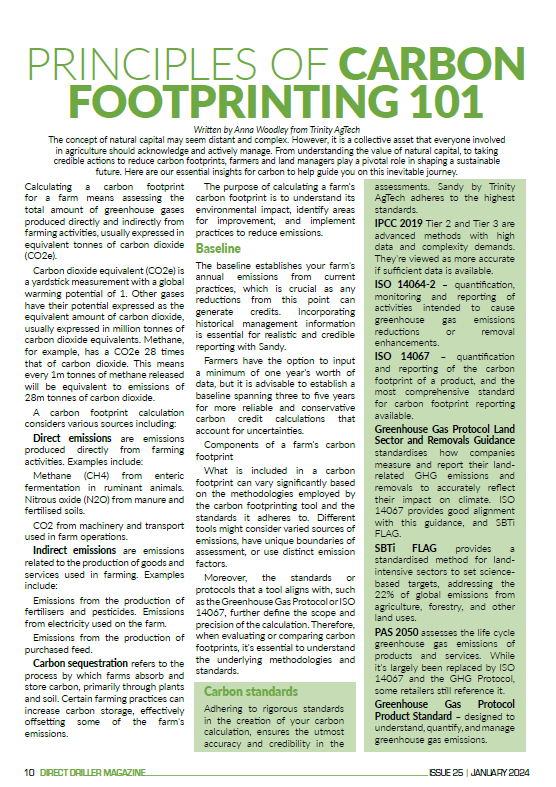
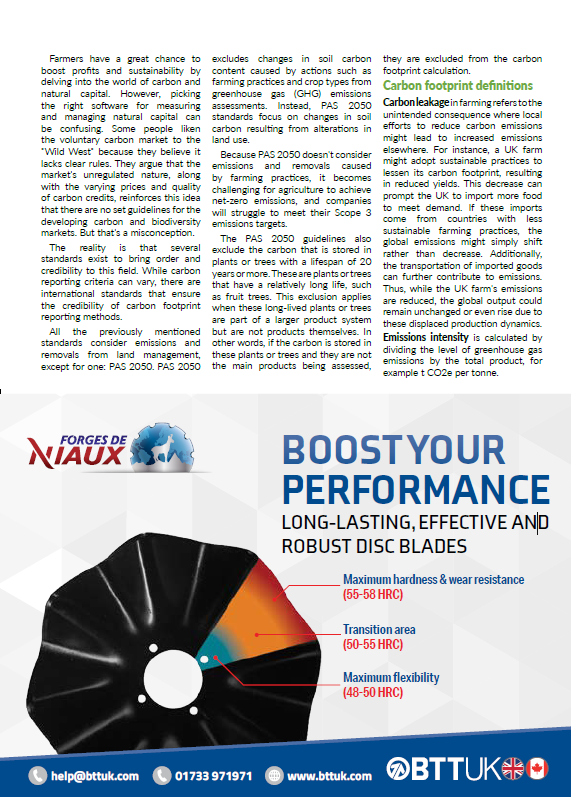


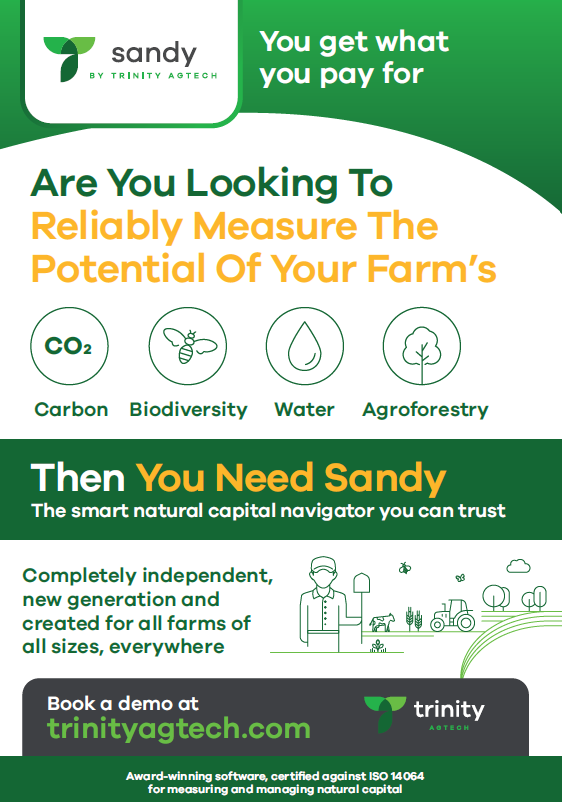
-

Farmer Focus – David White
“How much rain do you get on farm? All of it.” is a quote from an American regen farmer whose name escapes me. A comment that we can all relate to this autumn as we watched the millimetres accumulate in our rain gauges with a feeling that we personally were getting ALL of the rain. The quote of course refers to the soil organic matter, water holding potential and good structure, but the percolation rate in a good soil has again shown the ability to aid resilience and retain healthier looking crops.
No question that it’s been a difficult autumn with what seems like continuous storms blowing through, can’t think how many letters the Met Office will have got through naming them!
Here in the ‘dry’ east we had 224mm of rainfall in September/October with 167 of that falling in October. Certainly, again the less is more strategy has proved to be the most resilient and here any field that had ’stuff’ growing in it has remained relatively dry and drillable. I put ‘stuff’ as it didn’t need to be an expensively seeded catch crop, as volunteer oats provided the perfect entry for winter beans.
I’ve been lucky enough to travel extensively of late, not only through East Anglia, the Home Counties and up to Yorkshire but we also drove over 1100 miles on the recent BASE UK trip to France. We did a big loop down the east, across to the Loire region, and back up to the top side of Paris for our final visits. The clear lesson learnt was that any soil that had been moved sat very sad and wet, often with wash-outs on slopes and anything ‘alive’ and unmoved walked OK. Poor headlands clearly show no respect for the Brexit separation of the UK from Europe and is a common feature.

There is of course a limit to what good structure and kind topography can cope with and my low fields do have wet holes and some standing water. These fields will have been meadows back in the 1970s when mixed farms were regarded as inefficient and the push for ‘big’ production dictated that they were ploughed up. Ooh what a bonanza we had cashing in on decades worth of carbon being released. Also,
how strange now that I’m looking at payments that support arable reversion and capital grants for fencing to return them to their former use, what goes around… I’m quite looking forward to being a livestock farmer again even if in the early days being more livestock host than owner. Clearly this trend also has no respect for Brexit with us seeing some great grazing practises in France with livestock taking over arable fields.Bandwagon or mindset change?
We must remind ourselves livestock integration is one of the 5 Regen Ag principals and whilst many farmers now encouraged by SFI payments may dabble with throwing a few strange seeds around their farms to qualify for one or another payment acronyms, they will barely be ‘conservation grade’ never mind regen. We’ve recently seen the Red Tractor grab for further farming domination with their surprise outflanking move to impose the Green Commitment Module and grab good practice for the supply chain to capitalise on. Too many middle men see it (regen) as being on trend, something they want to be associated with to grab an easy pound (or carbon kg) or for customer kudos, without A) understanding it or B) being happy to reward those really making a difference to their farms and their soils.
This has highlighted the fact that some kind of definition of what regen ag is, is maybe needed. Lack of understanding and the fact that every new sheet of paper is blank means that we are at risk of more new wheels being invented than Raleigh ever made. This definition/demonstration of change should be no more difficult than adopting the 5 principals.
On top for that you will have to take some risk, try something new, see and measure simply the farm improvement brought by practice change. Share your experience with others so we can learn together. Work with local schools and community so they have opportunity to get on farm, understand the difference and create customer demand.
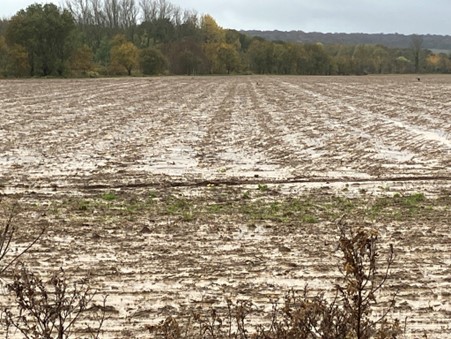
Fortunately, I’m working with 2 organisations that do understand the difference and are actively working to promote the benefits and bring financial value back to the farmer. Choose your partners carefully and not let regen ag become just another meaningless slogan.
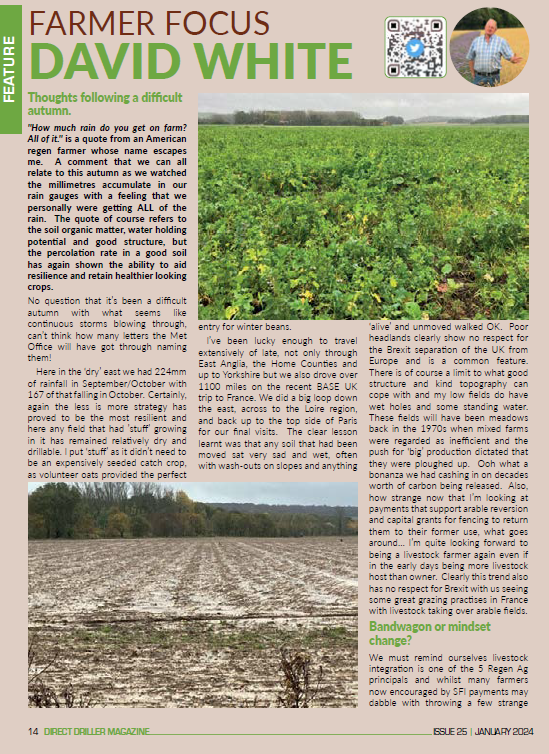
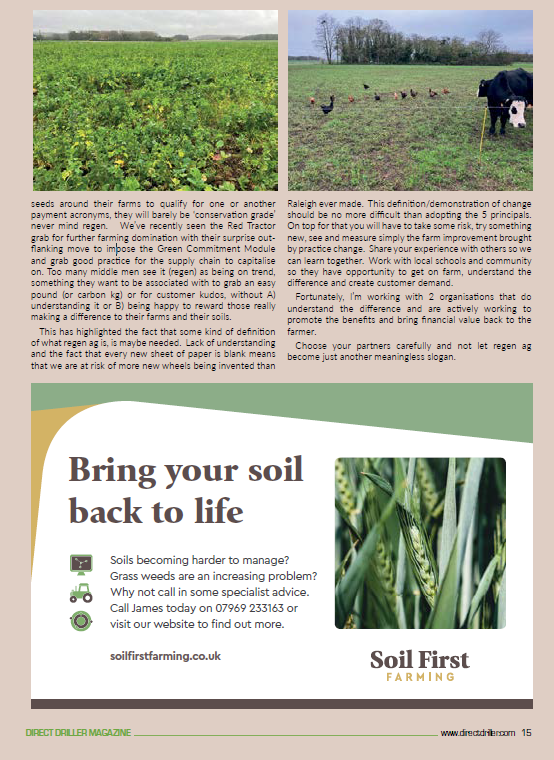
-

Distinguished Soil Health Pioneers to Head up BASE-UK Conference – 7th and 8th Feb 2024
Two world-renowned soil health and cover crop experts will be speaking at the BASE-UK conference in February 2024, the farmer organisation has announced.
Brazilian cover crop guru Dr Ademir Calegari, who has over 30 years of experience with no-till across farms of all sizes in South America and beyond is speaking on the first day of the conference as part of a line-up which has both UK and overseas participants, including farmers sharing their learnings.
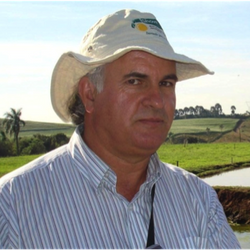
Ademir-Calegari He is also recognised as having mentored the French regenerative agriculture expert Frédéric Thomas, who spoke at last year’s conference and continues to support and inspire BASE-UK members.
Ademir’s distinguished work on cover crops, no-till and crop rotation and their importance to sustainable agriculture will be the basis of his talk. Credited with accelerating the no-till revolution in South America, Ademir’s belief that feeding the soil to feed the crop is expected to be a major theme of his presentation.
As Edwin Taylor, chairman of BASE-UK points out, having Ademir at the conference will give farmers the chance to broaden their knowledge and improve their understanding of how to get the most from their farming system.
“We are thrilled that Ademir will be with us at our conference and very much look forward to hearing what he has to say, so that we can build on what we are doing.”
Also speaking is US-based Jay Fuhrer, the founder of the soil health movement and mentor to many of the early adopters, including Gabe Brown. He learnt his knowledge about cover cropping from Ademir Calegari, and is taking part on the second day of the conference.
With over 40 years of experience in helping farms to build healthy soil and improve soil function, Jay is often associated with the rainfall simulator, which shows the impact of rain events on differently managed soils.
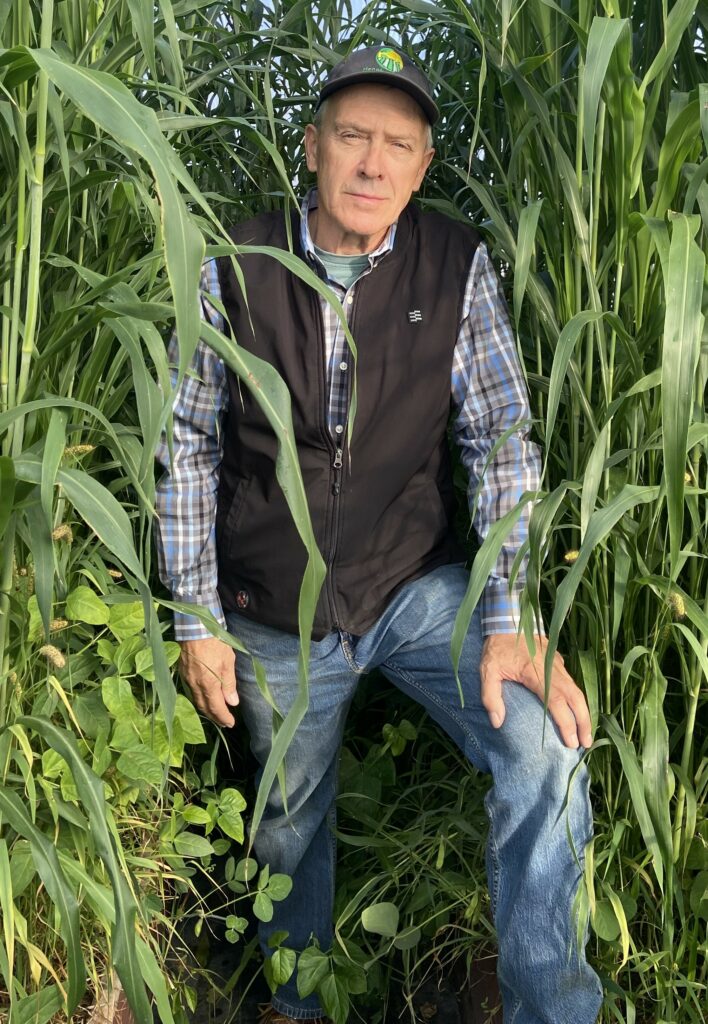
Jay Fuhrer Now based at Menoken Farm in North Dakota, Jay continues to put his soil health principles into practice.
His view is that these principles are universal – but stresses that how farmers get there and how fast they go is up to them.
His extensive knowledge of how no-till, cover crops and grazing management can benefit soil health and improve the water cycle is in greater demand than ever, says Edwin, who emphasises the challenges that all farming businesses face with climate change.
“This sort of expertise is exactly what we need to share,” he says. “Again, we are delighted that Jay is able to join us and we look forward to benefiting from his advice and guidance.”
Other speakers at the conference include husband and wife team Alex and Hannah Fraser – Hannah is a Nuffield Scholar who will discuss nutrient density of food. Donna Udall (soon to be known by her newly married name of Davys) will present on Biochar asking – Gimmick or Silver Bullet? BASE-UK members Toby Simpson, Ben Adams, David Purdy will also be joining the program.
There are just a few weeks left for you to book a place at our Annual Conference on Wednesday 7th and Thursday 8th February 2024 – closing date is 15th January 2024. If you would like to attend, please email rebecca@base-uk.co.uk as soon as possible. All details are available on our website www.base-uk.co.uk
SUCCESS AS BASE-UK SPONSORS MEMBERS COMMUNICATION SKILLS COURSE
At the end of September 2023, eighteen BASE-UK members attended a Communication Skills Course with Susie Emmett of Green Shoots Productions.
Sponsored by BASE-UK, the course was designed to enable them to pass on their knowledge and experience in farming and the agricultural industry. As a result, we have already seen some members presenting at farm walks, while others are speaking at the Conference. All have said how much they appreciate their newfound presentation skills.
The BASE-UK Committee is considering running this offer again in the future and will notify members when this is available.
BASE-UK MEMBERS MEETING AT THE JAMES HUTTON INSTITUTE WITH JAY FUHRER
On Monday 12th February 2024 BASE-UK is hosting an event by kind invitation from Professor Adrian Newton of the James Hutton Institute. As well as Jay Fuhrer, one of our key speakers from the Conference, the following experts from the James Hutton Institute will also be speaking:
- Roy Neilson on whether our cover crop trial shows any impact on beneficial and/or pathogenic nematodes.
- Tracy Valentine on the Grieve’s House long term tillage trial findings and some cover crop work too.
- Tim George on developments in monitoring soil health in Regen Ag systems and an update on the International Barley Hub (IBH).
Other details were still being confirmed as Direct Driller went to press.
Several of our Scottish members work with the Institute and assist with their research. Doug Christie has a close working relationship with Adrian Newton and often undertakes trial work for them.
This event will be for BASE-UK members only and has limited places. Further information will be emailed to members in due course. Speakers are subject to change.
BASE-UK is an independent, nationwide, farmer-led knowledge exchange organisation, encouraging members to make agriculture more sustainable by using conservation systems – no-till; cover cropping; integrating livestock; diversifying rotations; using less invasive, cost-effective establishments. Growing Confidence for a Decade!
HOW TO JOIN BASE-UK
Membership for BASE-UK is open to anyone with an interest in regenerative agriculture. Over 80% of our members are farmers and we pride ourselves on not dropping below this percentage of farmer members in order to retain the key farmer led knowledge within the group. If you would like to know more about us or how to join BASE-UK, please visit our website: www.base-uk.co.uk email Rebecca@base-uk.co.uk


Direct Driller @ Cereals 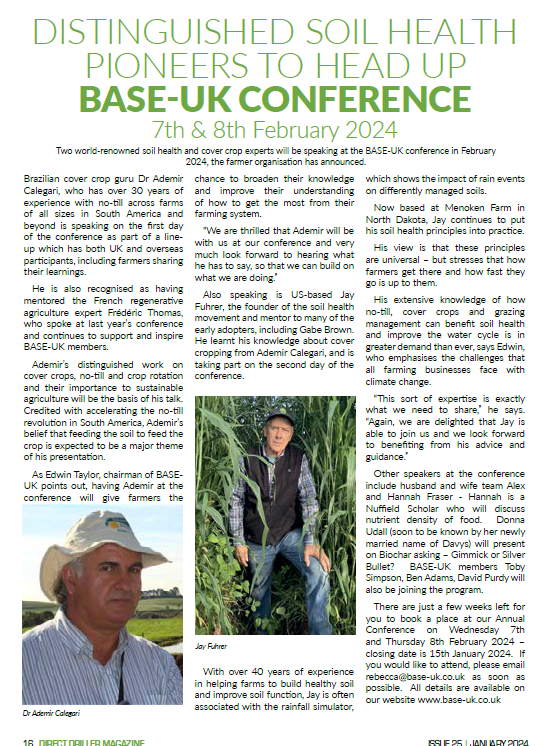
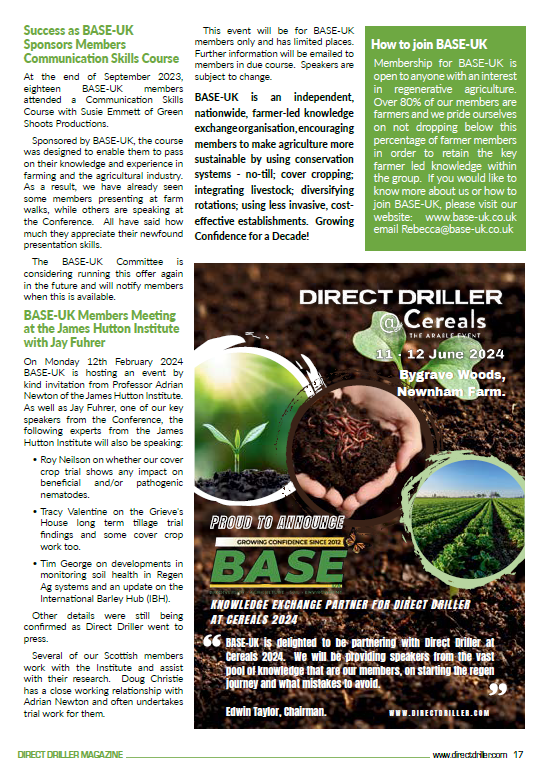
-

Who owns regen?
It is clear that the term ‘Regen ag’ is now becoming as confused and meaningless as ‘min-till’. The question of ‘what is Regen’ now happens with regular occurrence. Worryingly there now seems to be, in the UK at least, organisations who are keen to control the narrative and take ownership of the term regen for there own aims.
What is regen? What is it we trying to regenerate? The origins of the term are believed to stem for Robert Rodale who was principally referring to regenerating the soil and if we are truthfully honest to ourselves this is the fundamental aim of regen. “It’s about the soil, stupid”. More recently we have become familiar to the Gabe Brown version of 5 (now 6) principles of regen.
The regeneration of the soil brings immediate benefits to the farmer, and a wide range of other outcomes. These externalities, while mostly positive, and very welcome and necessary, are still secondary to regen’s core principle of regenerating the soil.
Does this even matter? Well, yes it does. These externalities are all adding to the confusion voiced by farmers about regen and are being used to take control of the narrative by outside forces. Then chuck in the barrage of governmental policies and agricultural philosophies and it’s no wonder that the term regen has become lost and confused. Regen has become conflated with net-zero, emerging carbon and biodiversity-net-gain markets, pressures and fears over inputs, SFI and ELM, the list is long.
The media is now awash with stories about how some farmers are cutting all inputs to become regen, with no loss of income, while others, and most of the released academic research, shows the exact opposite. What do you believe, or where do you turn?
Now the battle for control of the has begun. In recent weeks I have sat through several seminars where organisations are laying the groundwork for further interpretation of Brown’s five principles. Why would they do this if it isn’t to exact some form of control? Are we being lined up for another layer of bureaucracy, inspection and certification? Why is this even necessary, surely the guiding principles which underpin the philosophy are clear enough. Or to put it another way; It’s not organic; you can use fertilisers; you shouldn’t be employing intensive tillage every year; if you can see the soil, you’ve failed.
One organisation even mentioned the need to measure the outcomes and ignore the adherence to the principles. The only outcome should be a direct improvement in the quality and functionality of the soil, be that chemical, physical or biological. An increase in carbon storage is a useful indicator but not all soils are going to achieve that.
And what of the externalities, where do they come in? To my mind these are all separate, which all farmers should be striving for. They are all to be commended, some should even be rewarded and need to be rewarded. Regenerating soil should lead to enhanced biodiversity, after all the soil provides the life at the bottom of the terrestrial food chain. Better soil structure allows greater water infiltration rather that run-off, greater aggregate stability and soil organic matter can reduce soil loss and nutrient enrichment of water courses.
What of the wider social interaction and promotion of agriculture within the local community? Again the philosophy facilitates a story which can be told, and should be told but this is not a requirement to be regen, its simply a nice add-on.
Functioning soil can enable a phased reduction of inputs over time, although I feel the complete removal of them is not sensible or necessary. This contributes to the sustainability and net-zero we are told we must achieve but again it is because of the system, not a requirement of it. Be clear that you can enjoy the best of soil health whilst still using fertilisers and pesticides, there are plenty of examples of farmers that have done so here in the UK.
We need to ensure that the message is clear, no-one owns or defines the system or it’s outcomes, the principles of the philosophy are enough.

‘Regen is all about the soil’ 

-
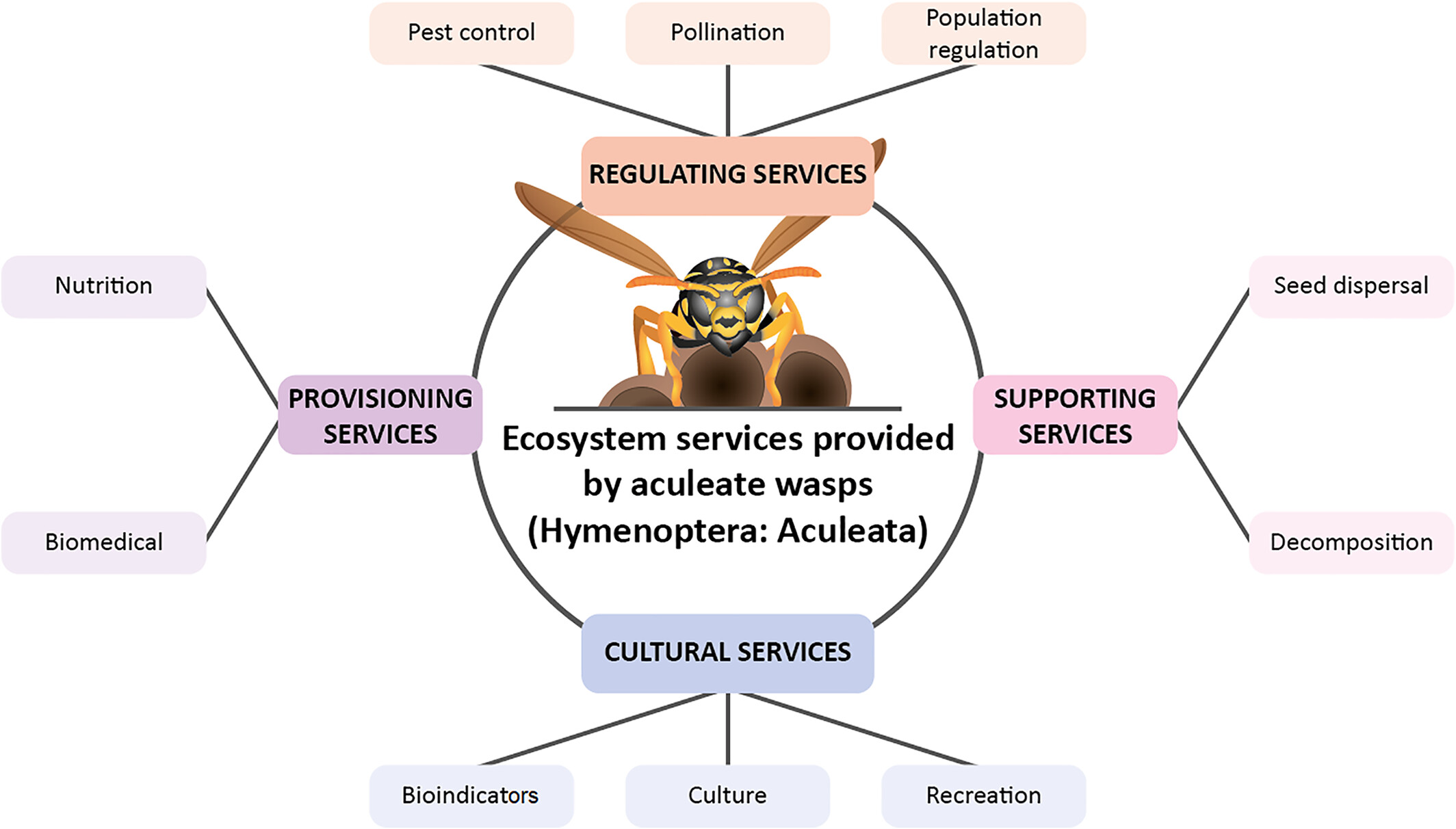
Unveiling the Hidden Heroes: The Ecosystem Services Provided by Aculeate Wasps
The natural world, spanning from individual organisms to entire ecosystems, offers a wide range of functions and benefits known as ecosystem services (ESs) that significantly contribute to human well-being. These services can be broadly categorized into four types: regulating services (e.g., ecosystem process regulation), provisioning services (e.g., material outputs from ecosystems), supporting services (e.g., maintenance of other ESs), and cultural services (e.g., educational and recreational roles of ecosystems) (MEA, 2005). Insects, a highly diverse and abundant group in the animal kingdom, play a vital role in providing various ESs, such as pollination and pest control. In particular, bees have received considerable attention for their contributions to ESs, but other insect groups, including wasps, remain understudied despite their potential significance.
Wasps are a diverse group of insects, with over 33,000 described species within the aculeate wasp suborder, excluding parasitoid wasps (Parasitica) and fig wasps. While parasitoid wasps have received attention for their role in pest regulation, the remaining aculeate wasps, both solitary and social, have been relatively neglected in research and their ES contributions are poorly understood. This oversight is concerning as aculeate wasps are globally distributed and represent a significant portion of hymenopteran species richness.
This comprehensive review focuses on shedding light on the ESs provided by aculeate wasps, including both solitary and social species. Despite their abundance and ecological significance, the services they offer have remained poorly defined and undervalued. Several factors underline the importance of studying these wasps:
- Global Distribution and Diversity: Aculeate wasps are widespread and exhibit high species richness, surpassing the combined species count of well-studied insects like bees and ants.
- Predatory Potential: While the predatory roles of aculeate wasps in regulating arthropod populations have been documented anecdotally, a comprehensive synthesis of empirical data is lacking. Understanding their impact on ecosystems is crucial for conservation efforts and harnessing their ESs.
- Pollination: Aculeate wasps are overlooked as pollinators of ecologically and economically important plants, despite playing a role in pollination networks.
- Disservices and Cultural Perception: The negative aspects of wasps, such as their aggressiveness and stinging behaviour, have dominated their ecological literature, and public perception tends to be unfavourable. Addressing these issues is vital for a more balanced understanding.
- Anthropogenic Pressures: Similar to bees, aculeate wasps face threats from agricultural practices, habitat loss, and climate change, emphasizing the need to assess their ES contributions in a changing environment.
The review identifies ten distinct ways through which aculeate wasps provide ESs, categorized into the four primary areas: regulating services (e.g., pest control through predation), supporting services (e.g., decomposition and seed dispersal), provisioning services (e.g., as a source of nutrition and biomedical compounds), and cultural services (e.g., bioindicators and their portrayal in literature and arts).
These findings highlight the potential significance of aculeate wasps in maintaining ecosystem health and their direct and indirect contributions to human well-being. The review offers a valuable resource by collating and synthesizing existing evidence, thereby providing a more comprehensive understanding of the ESs provided by this often overlooked insect group. Given the current concerns about global insect declines, recognising and conserving the services provided by aculeate wasps is essential for both ecological sustainability and human welfare.
Read the full paper here: https://onlinelibrary.wiley.com/doi/10.1111/brv.12719
-

Allerton Project
Written by Joe Stanley, Head of Sustainable Farming, at The Allerton Project
I was recently invited to speak at the North of England Farming Conference at Hexham in Northumbria, with a wide brief to cover anything forward-thinking which ticked the box for both environmental and financial sustainability. Weeks in advance I had submitted my presentation which covered a wide spectrum from agroforestry to nutrient use efficiency; SFI to IPM. But on the drive north in the wake of storms Babet and Ciaran, I couldn’t help but notice the devastation wrought on arable crops by the torrential rains – devastation, it must be said, more than matched by the state of crops across North-West Europe when I was on the continent the next week.
Upon arriving at the venue, I decided it was more practically useful to junk my planned presentation and instead rapidly throw together some of the information gleaned from 30 years of research at the Allerton Project into soil management, and how growers might build resilience into their land in the face of escalating climate extremes. I hope perhaps that some of that information is useful here.
According to Environment Agency figures dating back to 2019 (before our winters became so consistently challenging) we are though to lose some 2.9m tonnes of topsoil from England and Wales every year at a direct cost to the economy of around £180m (a mere £62/t!), while over 2m hectares of soil are thought to be at risk of erosion. Globally, 24m tonnes of topsoil are thought to be lost to erosion annually, with an area the size of Greece suffering fresh soil degradation in the same time period. It has been calculated that soil regenerates at the rough rate of one inch per 250-800 years; no doubt most of us are aware that we can lose it much faster than that. Soil is a finite resource.
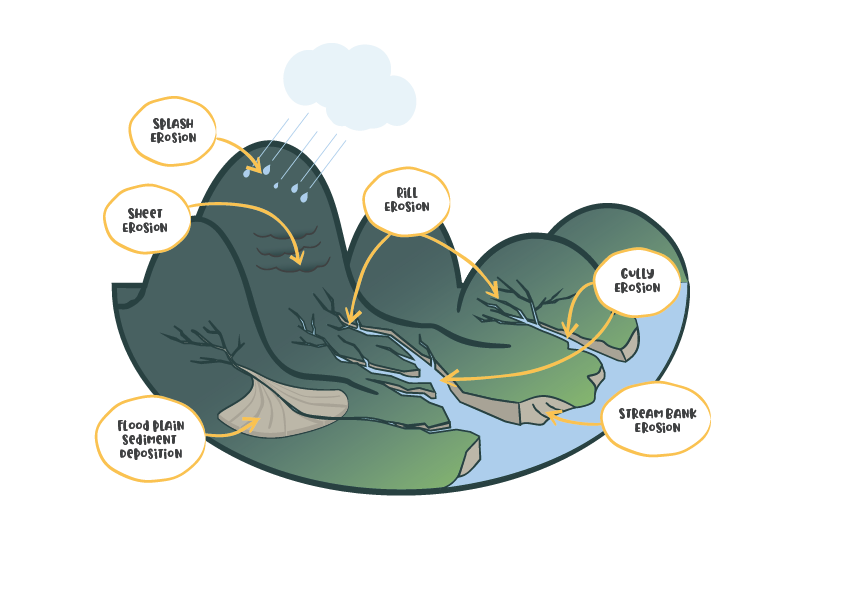
The factors which influence soil erosion are many and varied; weather, soil type and topography are largely out of our control. Yet there are things which we can influence; crop selection and rotations; cultivation type and direction; drainage; soil cover and soil health. I won’t teach the reader to suck eggs by extolling the virtues of field drainage, but needless to say it’s probably the single biggest limiting factor in the productivity of many soils as we enter our fourth decade since drainage grants were discontinued.
Rotations are becoming an increasingly important factor in the soil loss equation; having been collectively encouraged to push autumn drilling later into October and even November to deal with blackgrass, we’re now seeing all manner of problems arise from this approach. Here at the Allerton Project, we are looking at very significant crop loss from seed planted prior to Babet and Ciaran which simply rotted in the ground, while worked down ground all around us is currently flowing into the North Sea. Maize fields are a sea of ruts and mud. Rotational choice is basic, yes, but what has been acceptable and even successful in the past is decreasingly so.
Into this feeds more general arguments about land use; which areas of fields (and even farms) might be better planted with buffer strips, grass leys or trees? Modelling conducted by the Allerton Project shows that afforestation can reduce sediment (and phosphate) loss to water by an average of 75%, while utilising 20m buffer strips in an arable situation can reduce it by some 25%. However, by adopting no-till establishment, reductions of 35% can be seen on average, even in the absence of the other measures. In stacking these different approaches, very significant improvements to soil management can therefore be achieved.
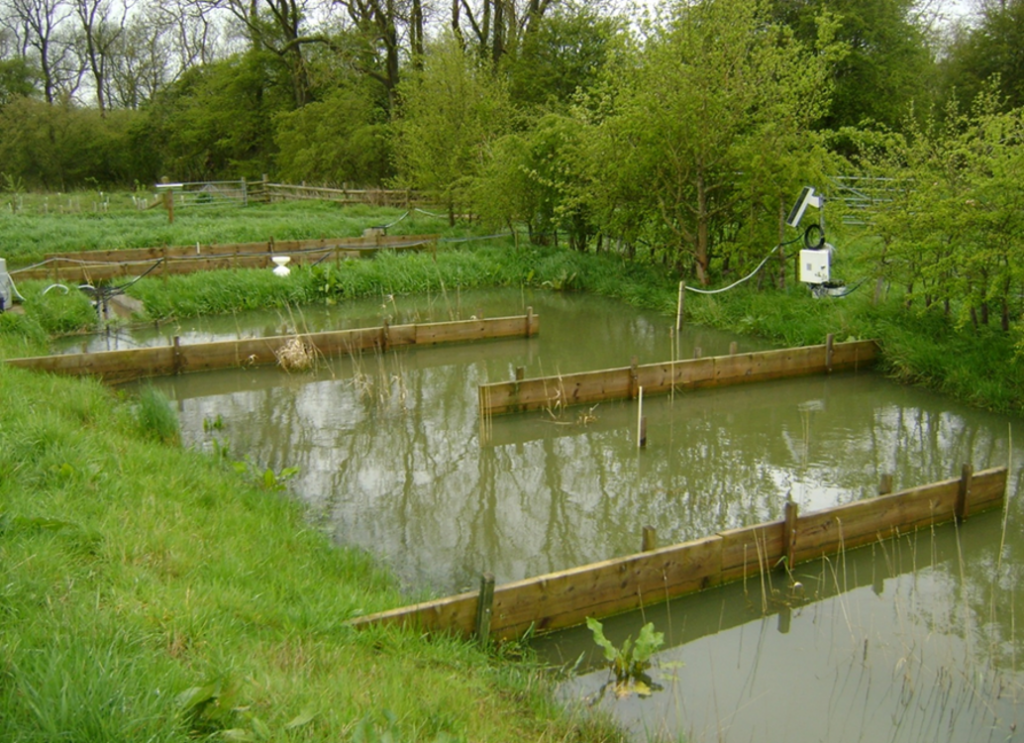
Reduced tillage is key to stopping soil movement before it starts, with the field surface remaining un-disrupted and soil particles less prone to dislodgement by rainfall and erosion by surface run off. An added benefit is the higher proportion of crop residues to be found in such systems, which add ‘soil armour’. But tramline management is also a key element of good soil management; we’ve found that some 80% of sediment and phosphate loss can be attributed to the 2% of the field which consists of tramlines.
There are many practices which can be employed to reduce tramline erosion, the most effective of which is disruption with a following tine. However, we recognise that this is not practical in a broadacre arable situation, and our data would indicate that contouring (where possible) and use of low ground pressure tyres are the next best options.
If soil does start to move, gets past buffer strips and enters a field ditch, sediment traps are a last line of defence to stop it from leaving the farm, the intention being to intercept sediment-laden water and slow it down, decreasing the energy holding soil particles in suspension and allowing them to settle on the bottom. We have conducted extensive trials with these capital items, on a range of soil types: our own heavy clay; a medium loam; a sandy loam. Over the course of three years, we measured some 70t of sediment collected on the sandy soil site; some 40t on the medium loam and a mere 1.7t on our own clay site. This demonstrates two things; heavier soils are by their nature more difficult to erode in the first place, but that sediment traps are also very site-specific: although highly effective in situations with larger, coarser and heavier soil particles, they are of very low efficacy in situations with tiny clay particles where days are required to allow them to drop out of suspension, not hours. In clay landscapes, soil must be intercepted before it leaves the field.
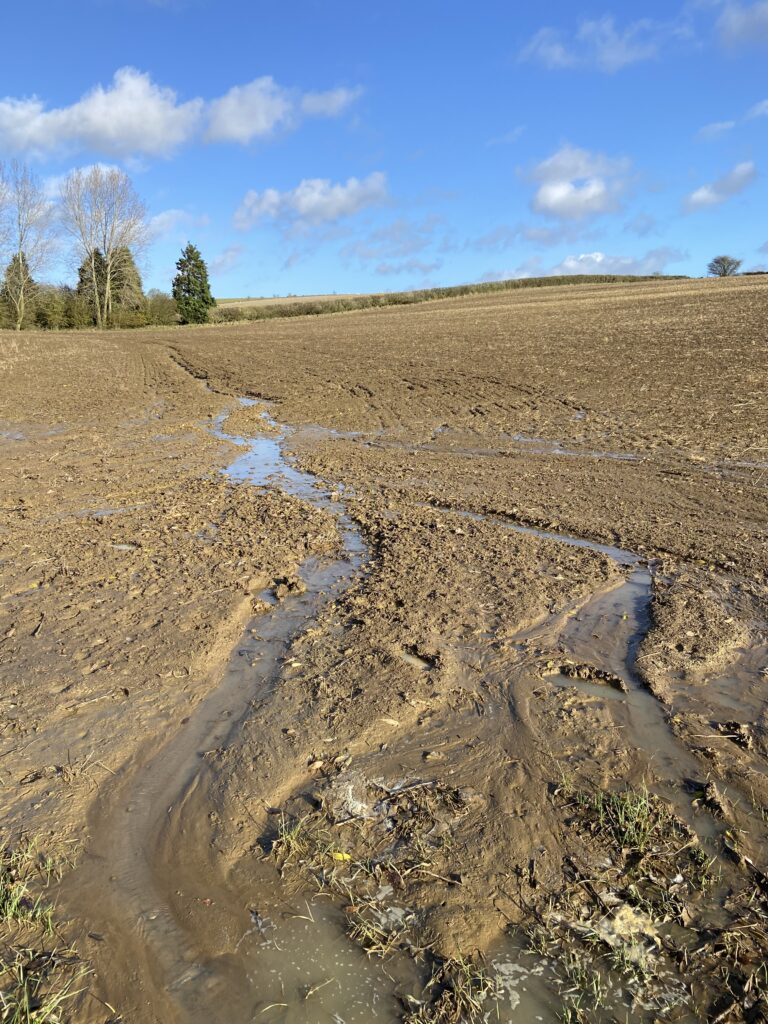
Of course, perhaps the most effective – if most difficult to achieve – means to build resilience into soils is to increase levels of organic matter. As previously related in these pages, it has taken us a decade of ‘conservation tillage’ techniques to increase some of our clay soils by 0.7% SOM; it is not a quick process. But higher levels of SOM demonstrably improve the structure of soil, and thereby its ability to allow rainfall to infiltrate. Higher OM levels also give rise to improved levels of soil biota, including earthworms, which have been shown in some situations to contribute some 80% of the infiltration capacity of cropland soils, largely through the deep vertical channels of anecic worms, too easily disrupted by tillage. And with OM holding up to 10x its own weight in water, it’s thought that increasing it by 1% in a standard mineral soil can add an additional 200t of water holding capacity per hectare to a depth of six inches. When the flooding stops and the inevitable spring drought begins, that is a very valuable resource.
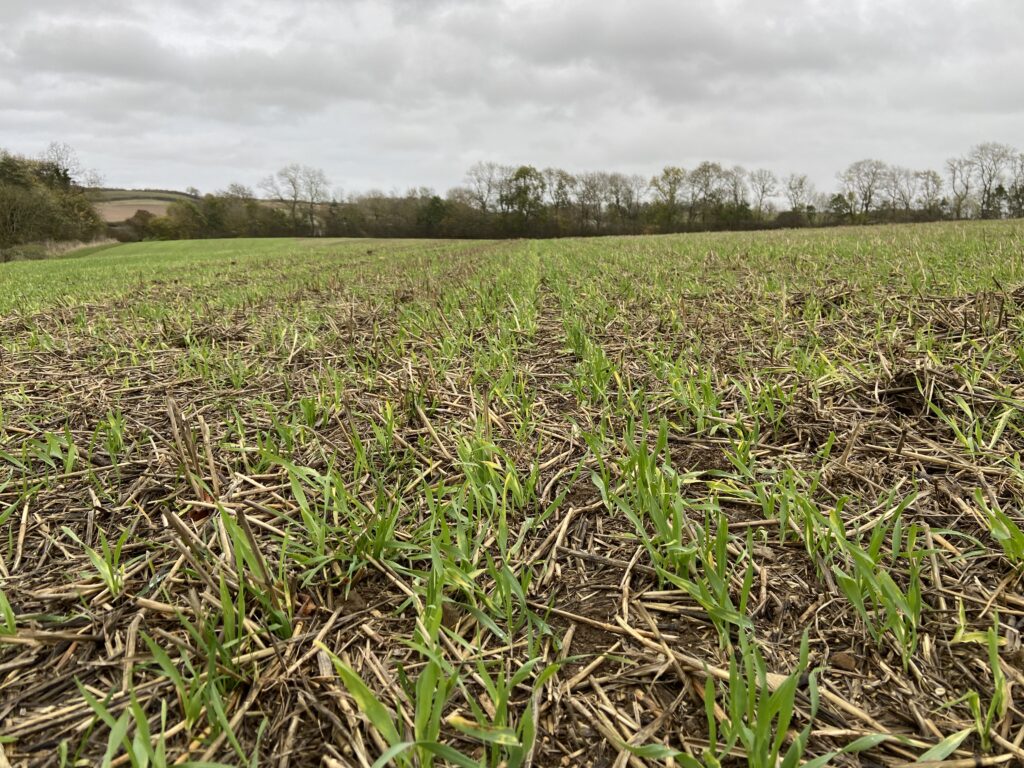
Every farm and field is different, with a wide interplay of different factors impacting on optimum soil management between them. But there are fundamental principles of good soil management which are broadly applicable in any situation. The challenge for individual farm businesses, now and in the coming years, is to harness available income streams to assess which land use and soil management techniques are best suited to their situations to safeguard the future of their most valuable asset.

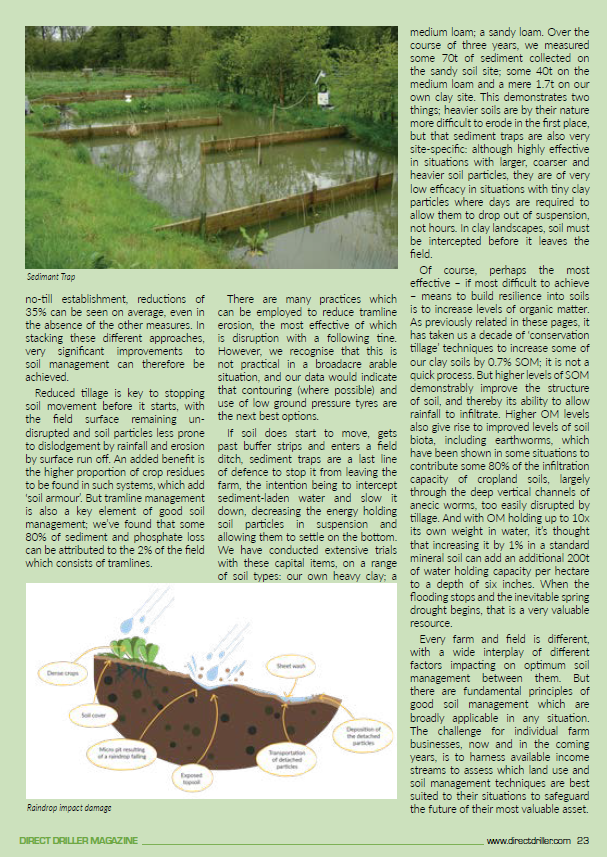
-

Farmer Focus – Andrew Jackson
Dec 2023 –
As we are all aware, this autumn has been especially wet. Although we are not a big farm and most probably, we have a drill capable of sowing twice our area, I would like to report that the principles of direct drilling and regenerative farming do work. We are all sown up (one of the only farmers in the area), and our wheat crops look very respectable. We did trial broadcasting a small seed cover crop blend pre harvest into the standing wheat crop, I thought that this strategy was worth a try because it was looking like it could turn out to be a late wet harvest. The results of the broadcasting have produced variable establishment, and I am not sure about trialling the strategy again because of the seed and contactor costs.
In my previous article I indicated that we were making a plant to create and store foliar nitrogen in thirty tonnes batches, with the ability to add in other products, such as molasses, fish hydrolysate and any nutrients which may have been shown to be deficient following Sap analysis results. Unfortunately, the project got behind schedule and will now have to be implemented next year. One thing that I did forget to mention regarding this project, was that I have been working closely with the local Catchment Sensitive officer, Julie Jackson from Anglian Water, it is through Julie that I have been able to gain a much-appreciated grant for this project from Anglian Water.
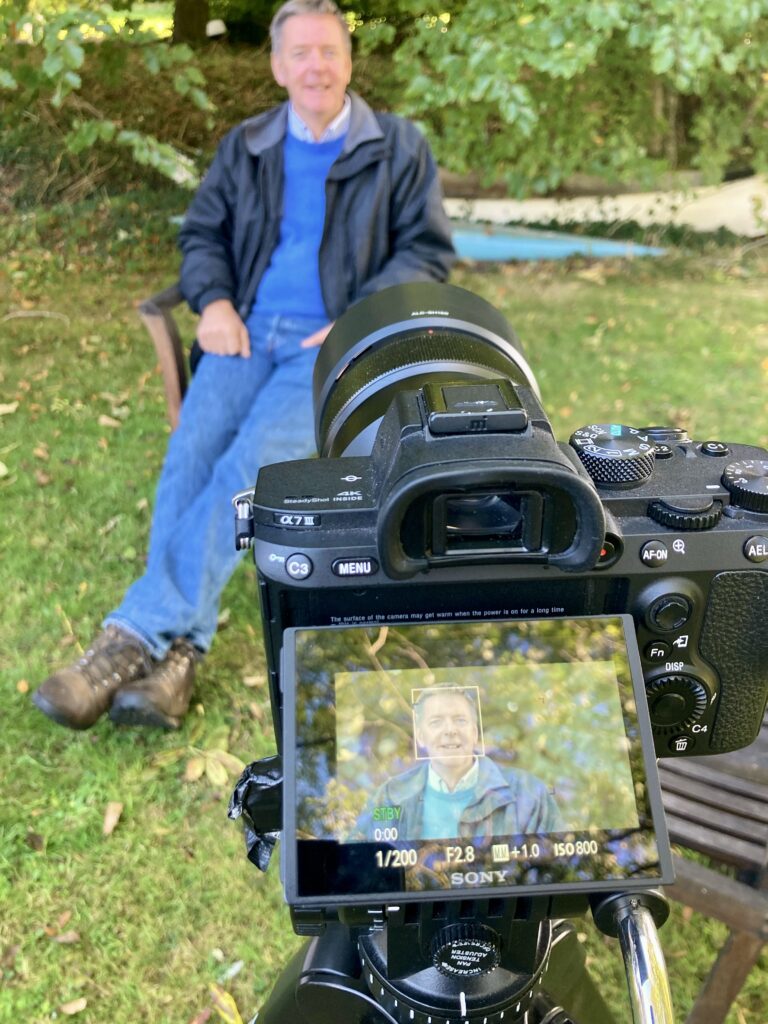
The weather throughout the growing period had its ups and downs, our crops looked very even and well. We had selected and sown a ten-way blend of soft wheats, hoping to gain a soft wheat premium. Interestingly at harvest, one farm met the soft wheat premium and the other ended up with feed quality. If I fail to gain the required soft wheat quality in future years, I may well add some carefully selected hard wheats to the blend to increase the diversity. I had hoped to reduce my reliance on fungicides by using the blend of seed, in conjunction with a reduction in total nitrogen and complimented by using the homemade foliar nitrogen, the latter did not happen, but the wheat blend has been shown to be very robust in a bad Septoria year.
We did a whole field trial with a biological product called Sycon, which was intended to replace our fungicides, the product was applied at T1, T2. The combine yield meter showed no yield difference between the Sycon applied to our cereal blend, and our normal fungicide program. Therefore, we will continue with trialling this product, its rate and timing, next year on a greater scale, hopefully with financial savings to be made along the way. We also trialled the R Leaf product with no variation on the combine yield maps.
Although the wheat crops looked well, a dull July contributed to a reduced bushel weight and the yields were a little disappointing, the last field to be harvest revealed a little surprise. It had a similar cropping history to a field next door; both were first wheats, but the surprise field had a cover crop which had been grazed by sheep about eighteen months prior to harvest and the next-door field had not been grazed. Not a big deal you would think, but the grazed field yielded 1.2 t/Ha more than the non-grazed field, I look forward to seeing if a trend reappears.
Walking over a second-year grass seed crop before harvest led to the observation that there could have been more seed heads per square metre. We had failed to graze the field in the autumn and a quick calculation with our Barenbrug fieldsmen indicated that the potential yield improvement from grazing off the grass seed, in just that one year, could have nearly funded stock fencing around the whole field. This year we have some grass seed into an OSR stubble, containing a carry-over companion crop of crimson clover, (clover seeds do not appear to be a problem as regards grass seed contamination), the yield of grass seed proved to be much greater when following the OSR and companion crop of clovers. I thought that this year I would repeat the exercise and to hopefully replicate our success, as we all know this autumn has been wet and I lost both of my newly sown grass seed crops to slugs.
I was also informed that the Danish farmers sow their grass seed at a lower seed rate and on wider rows. I asked the question as to whether I could shut off every other coulter for the grass seed and sow clover in between the grass seed rows, (I am on 16.5 cm row spacing). The conclusion was that it was worthy of a trial. I also apply this principle to our OSR and this autumn the OSR has also been sown as a blend. The inclusion of clover into crops could help with SFI companion crop eligibility and provide a grazing opportunity post-Christmas. The grazing on its own accord could reduce the weed burden, improve tillering, add nutrition, reduce fungus diseases and maybe contribute towards improving future wheat yields.
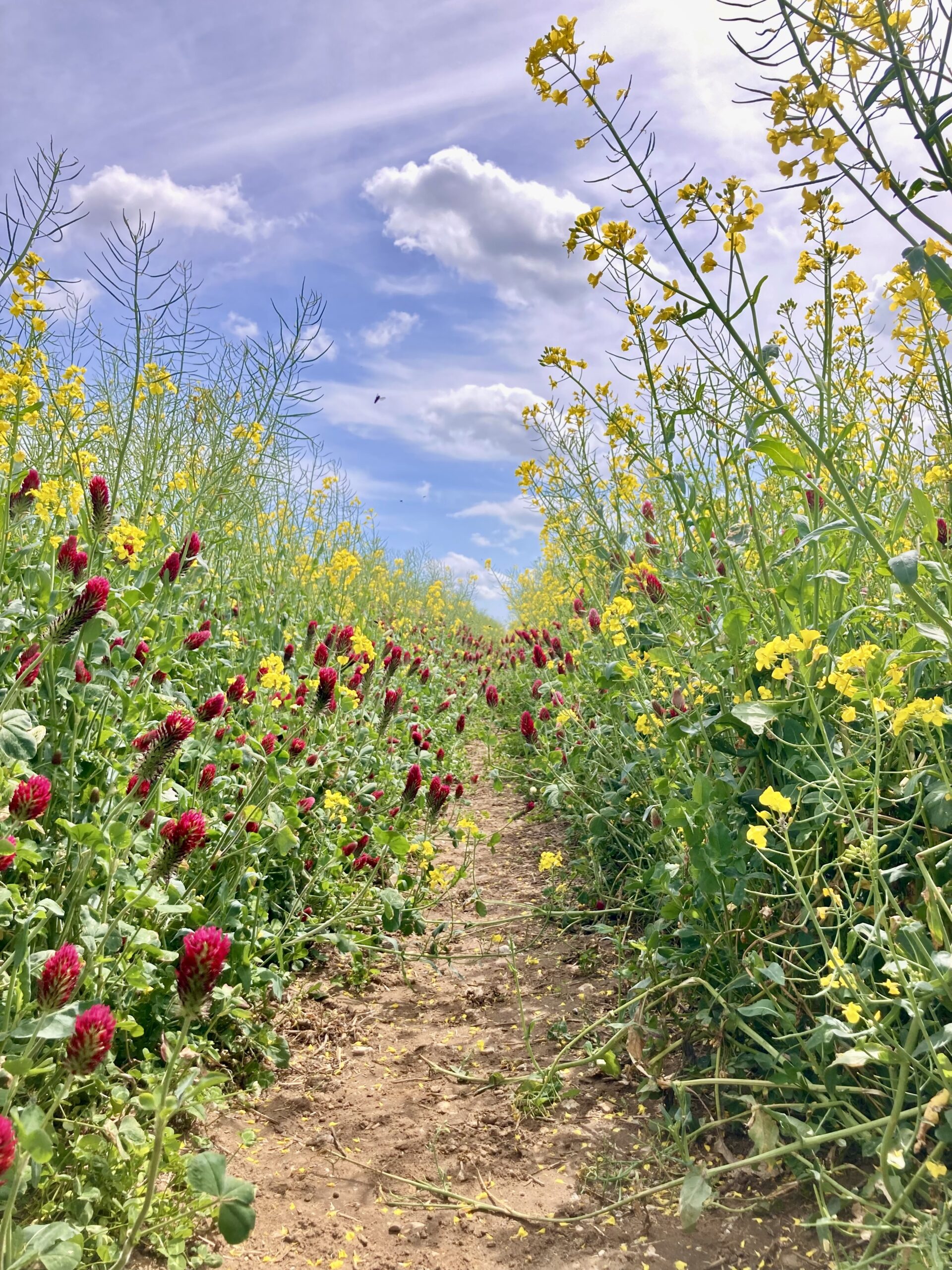
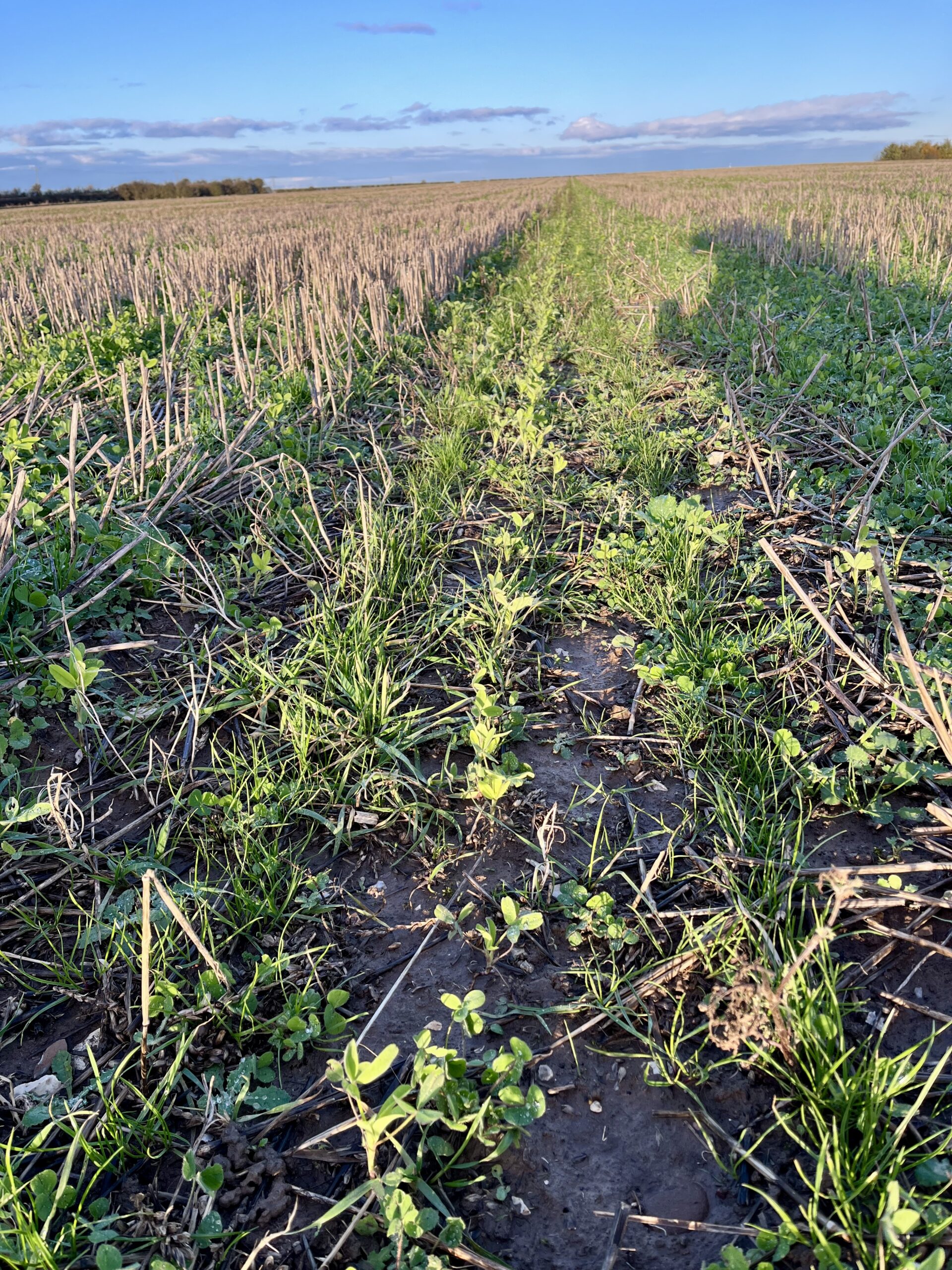
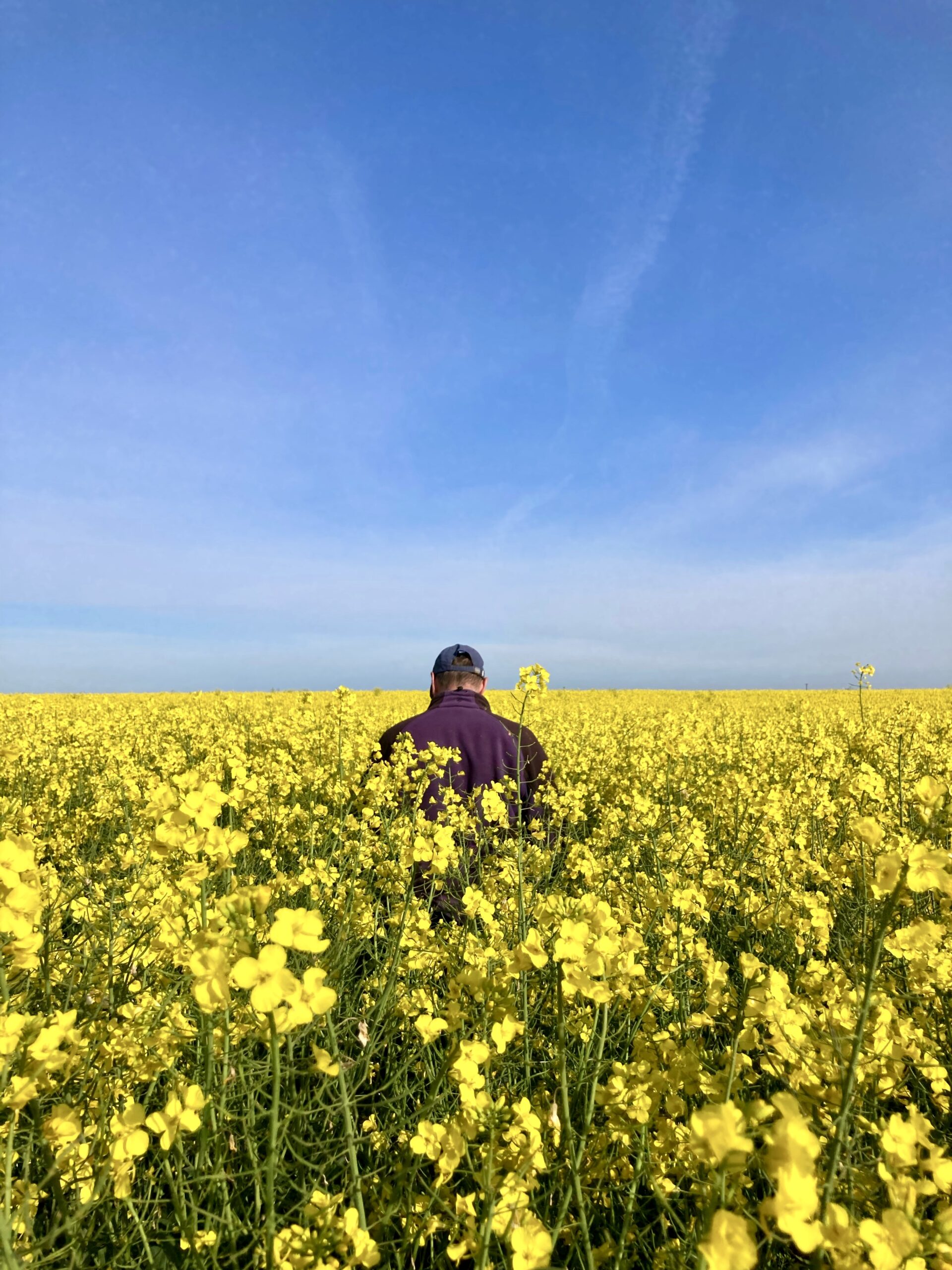

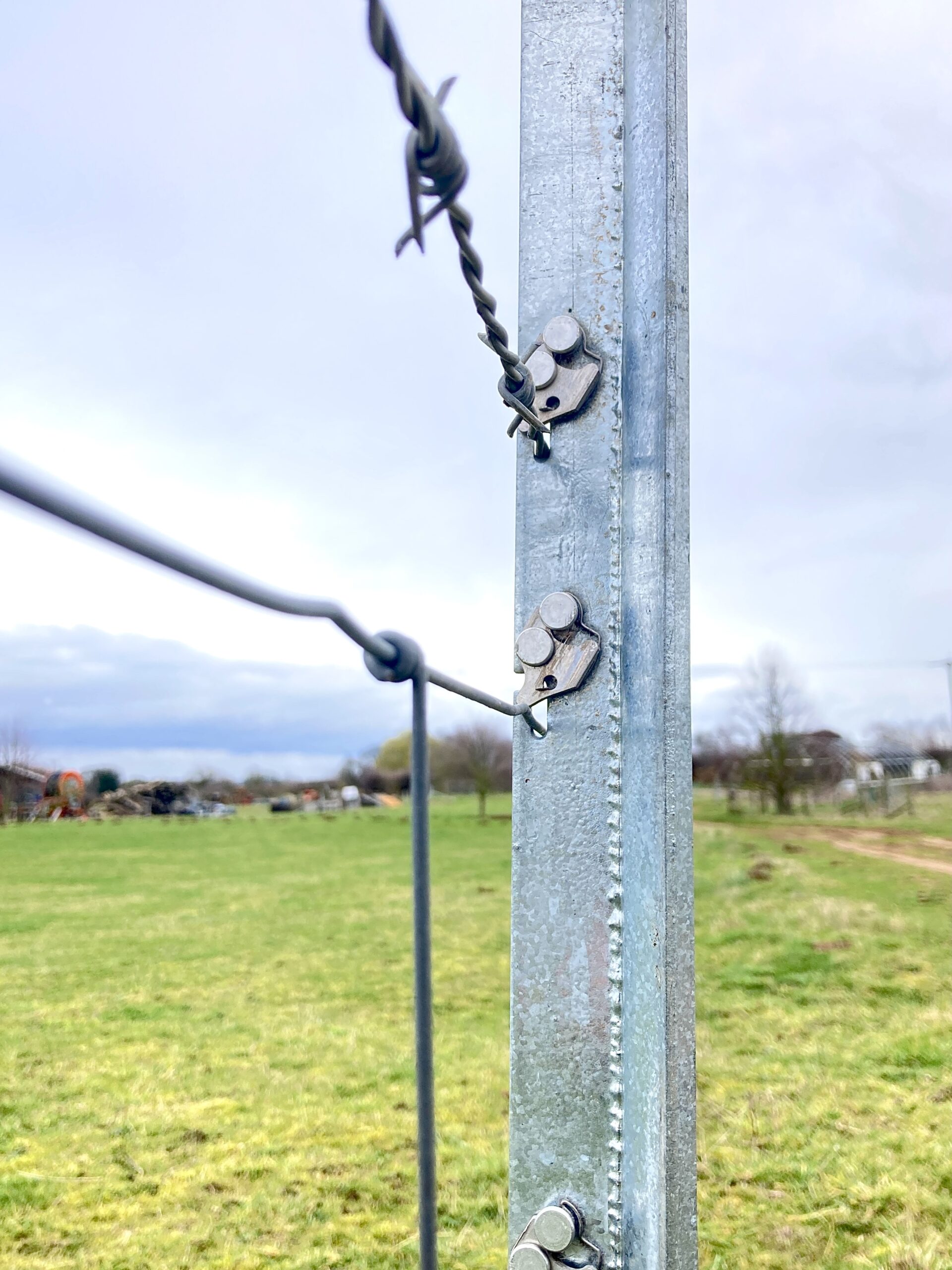
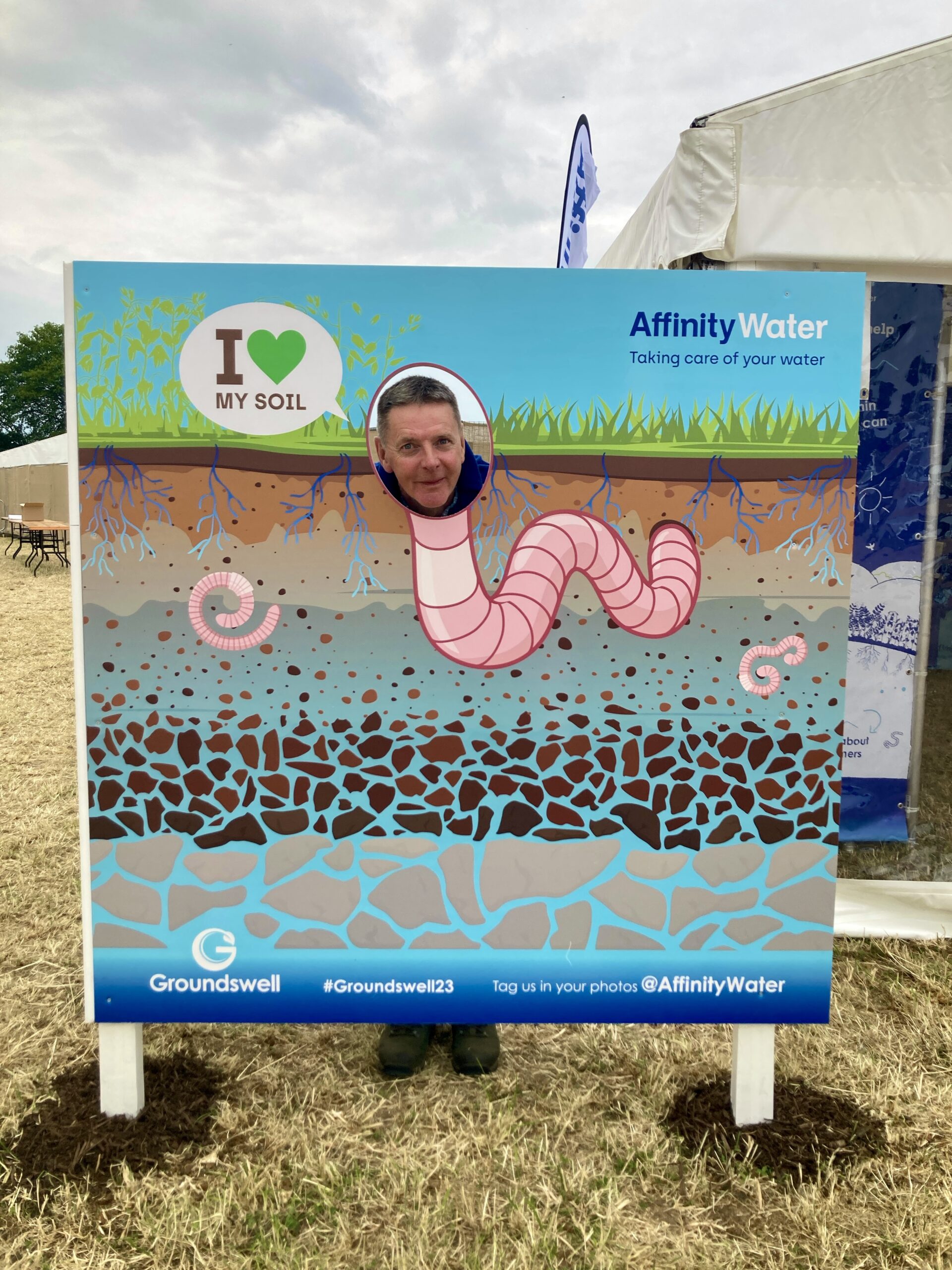
I have followed Andy Cato’s work with interest, his thoughts and operation works on similar principles integrating legumes as companions. I believe that legumes are reluctant to hand over their nitrogen unless either, grazed or mowed. At Groundswell I then saw Trevor Tappin’s inter-row mower, this is designed to mow between the wheat rows, topping both legumes and weeds. I am not sure to which growth stage the mowing will continue to be beneficial, however if this would be continued into April, then the crop could suffer damage from the tractor operating with the interrow mower.
It dawned on me that an inter row mower could well lend itself to being a self-propelled, light weight, satellite guided robot, with a row crop wheel at each corner, which could be left alone to operate in the field all night. The “Holy Grail” as Andy Cato put it when I conveyed my thoughts to him. Just to put this out there, would a type of crimper with less power requirement than a mower perform a similar job?
I have in the past mentioned forming a local regenerative cluster of like-minded farmers, this is still very much on the cards and with each meeting, I find more farmers, who are all at different stages of the “journey” who might be interested in joining such a cluster to benefit from informal knowledge transfer. However, events have overtaken my ambitions, in February I attended a Worshipful Company of Farmers Reunion which was hosted by Rob Shepherd. Amongst other interesting visits, we visited Rob’s farm, where he described the setting up of the Environmental Farmers Group (EFG). This is a concept where farmers group together to form environmental clusters which can provide a platform of scale, for trading environmental services with other industries, be it biodiversity, improving water quality, trading low carbon produce, and potentially trading carbon itself.
There were several presentations about these topics at Groundswell and I learnt that the government will be amending the Environment Act and bringing in new Greening Policies which may stimulate the type of trading that the EFG is being set up to attract. In addition, there will be a new round of government NERF funding to help the formation of regional EFG groups.
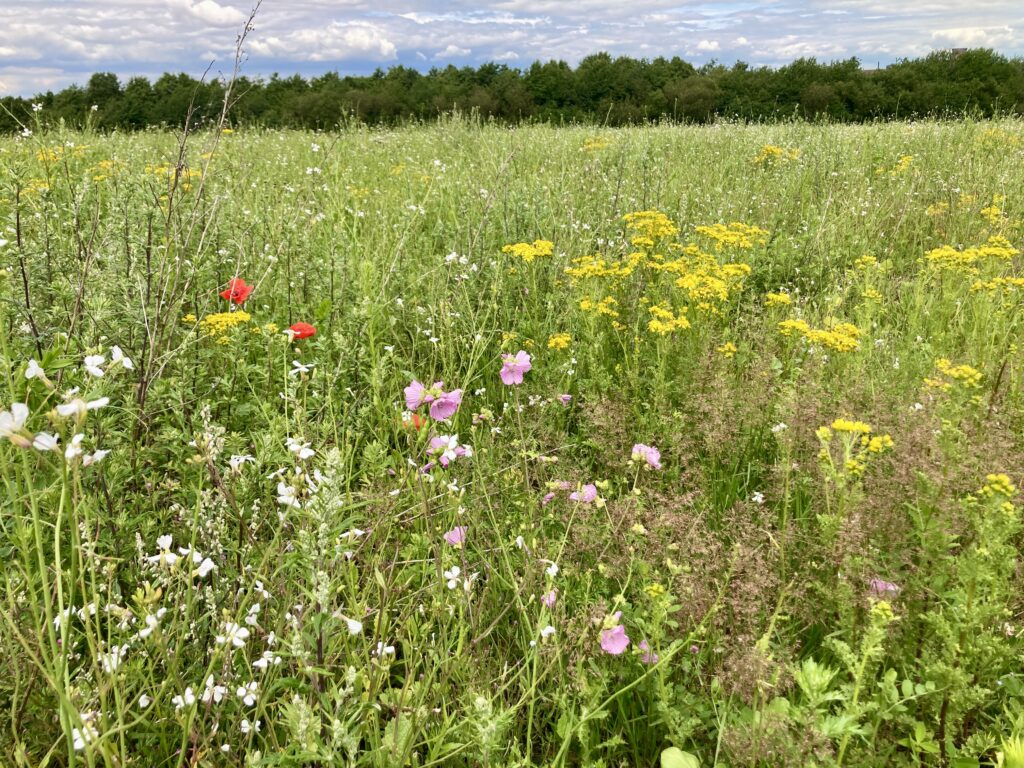
Within a couple of months of the Salisbury reunion, farmers in Northern Lincolnshire had been approached by Digby Sowerby from Natural Capital Advisory, who are helping facilitate the Hampshire EFG. Digby’s presentations were good, and we decided that there would be enough local interest to form our own regional cluster. I have now become a member of the steering committee which has the intention of gaining 40,000 Ha’s of expressions of interest, our hope is to form our own EFG cluster in Northern Lincolnshire. The target will be to be in operation early in 2024 and eventually operate with more than 100,000 Ha’s, allowing us to trade at scale with the industries on the Humber Estuary.
Over the previous two years my daughter Anna has been helping with the film “Six Inches of Soil”. The film is now complete and will have it debut in an auditorium in Cambridge on December 5th, there will be more viewing opportunities next year, at our farm, The Pink Pig Farm and John Pawsey’s Shimpling Park Farm.
As a result of participating with my daughter Anna in the forthcoming film “Six inches of Soil”, we ended up completing a second carbon calculator with the Carbon Calculator Toolkit. This produced a result which said that we were sequestering carbon. Consequently, we were encouraged to enter Soil Farmer of the Year, the results of which were announced at Groundswell. We were fortunate enough to come in the final six, something that I am proud of, we may never have entered this competition, if it had not been for the sequence of events mentioned above.
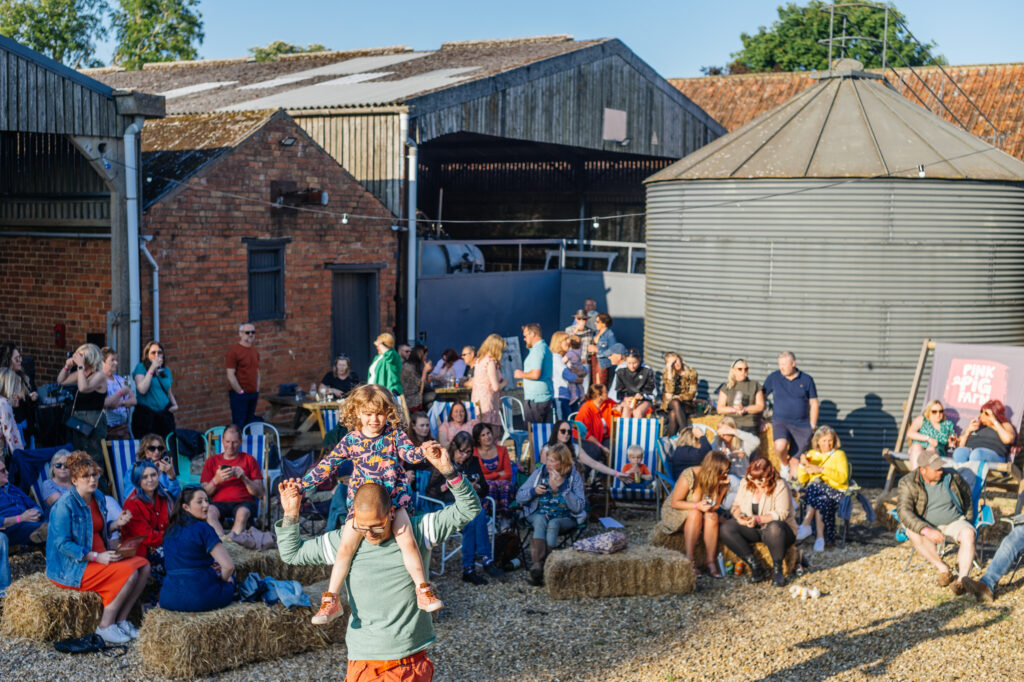
This year we came through the hottest June across the world, breaking all records and throughout the year, individual country temperature records across the globe are being smashed every week. This has been followed by an extremely wet autumn which has created many problems for the farming industry. Books that I have read inform me that one third of the carbon dioxide in the atmosphere has come from Agriculture and much of that has derived from soil organic matter levels plummeting, causing carbon to leave the soil and enter the atmosphere. Obviously, this has been going on for centuries, however the introduction of mechanisation, together with manmade nitrogen, has caused an acceleration of the global warming in the twentieth century and up to the present day.
I apologise for being an eco-warrior but one of the big drivers for me going down the regen route was the fact that I could help in a small way to change and improve the global warming situation, just like the EFG principle one farmer cannot do this alone. I believe that as a committed regenerative farmer, it is my job to prove that this type of farming can make a profit, deliver environmental benefits and above all, set an example to the farming community that the regenerative system of farming works in a sustainable way and if carried out at scale, we can all do our bit to help combat global warming. We could then proudly announce to our grandchildren that we did something to alleviate the mess that the world is accelerating into. The government may have grasped this concept, and the new SFI encourages farmers to work towards the regenerative principles.
To finish on a happier note, in May I hosted my first music and beer festival, my motivation came from fellow regen farmer Jonathan Hodgson who together with his brother Matthew have hosted several festivals. I managed to get together five bands, five real ales, two ciders and a lager. Being a bitter drinker, I underestimated the number of lager drinkers attending our festival and by seven pm I was driving to my local pub to buy another barrel of lager. The cider also ran out by 8 pm. The whole event has been a big learning curve, but we did financially break even, and I intend to host another festival next year. The only complaint was from a person who was reluctant to wait another year for the next festival. It’s not every day that you phone a close friend from a blocked lady’s toilets and ask him to join you in the middle cubicle, complete with a plunger. We discovered that the cistern was not filling, eventually, we locked the door from the inside, and I clambered over the partition into the neighbouring cubicle, I would like to add that no ladies were interrupted due to my actions.

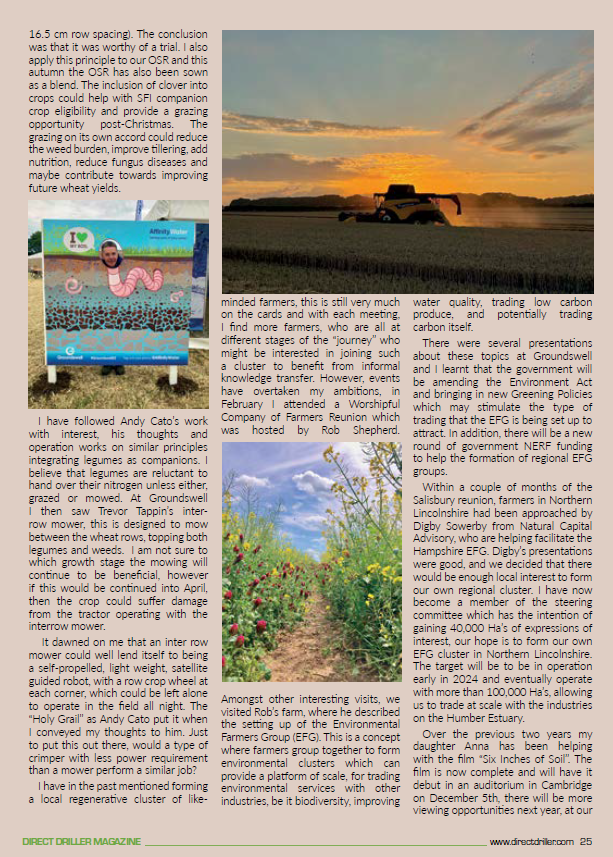
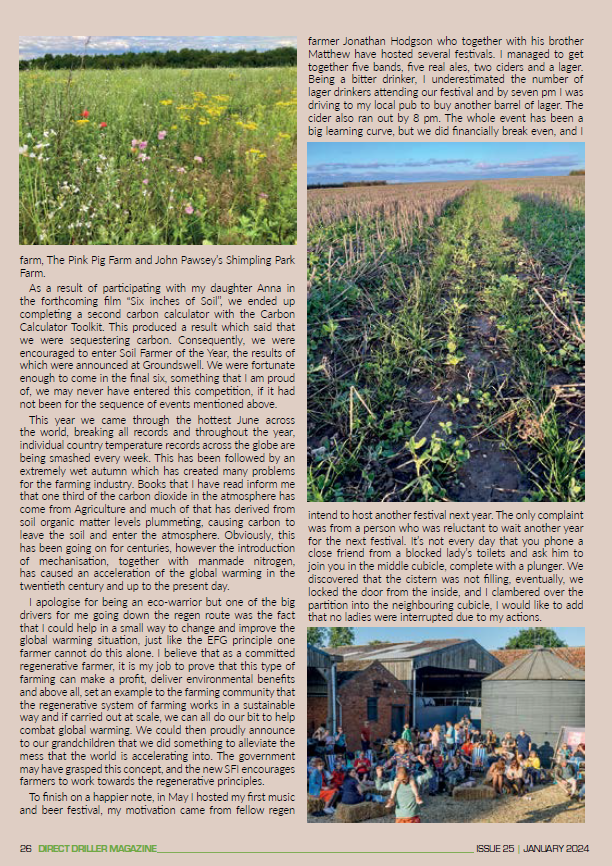
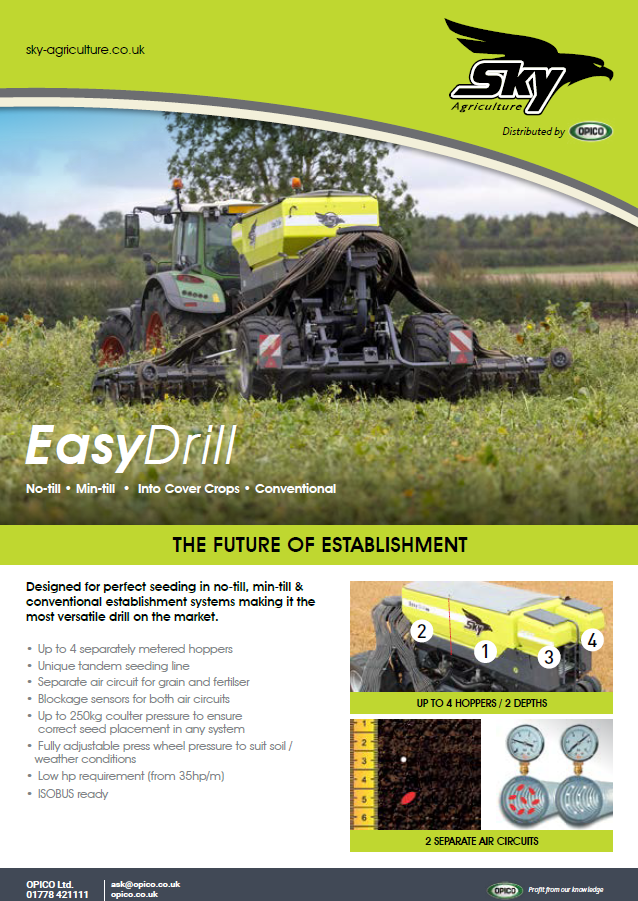
-

Seaweed in agriculture
Written by Dr David Cutress: IBERS, Aberystwyth University.
• Seaweeds have long had suggested benefits for agricultural use
• Research suggests green seaweeds to be beneficial for soil/plant amendments and red
seaweeds to have some potential for animal feeds
• To be able to include at meaningful levels, the production and supply chain of
seaweeds needs to be researched and developed furtherSeaweeds
Seaweeds are algae, specifically, they are macroalgae and despite performing many of the same functions as plants they are not plants. For this reason, you may sometimes see seaweed referred to as non-vascular plants but unlike plants, these species absorb nutrients which they use for photosynthesis directly through their cell walls. They also lack stems, roots, xylems and many other specialised plant structures. The three main groups of seaweeds are green, red and brown and their colours come from the combination of chlorophyll and other accessory photosynthetic pigments found within each species, for example, red seaweeds have phycoerythrin and phycocyanin pigments for absorbing light that reaches deeper into the ocean and the brown seaweeds have the pigment fucoxanthin. Seaweeds have long been utilised by people for many reasons including as a medicinal source with more modern research finding the specific elements within seaweeds that lead to its various functions. Some of the roles of seaweeds in general include;
• Food (healthy low calorie) • Medicine • Edible packaging
• Fertiliser • Plant biostimulants • Bioremediation
• Climate change reduction • Bioethanol • Dyes
• Explosives • Cosmetics • Gels
• Supplementary livestock feed • Bio yarnBut within agriculture, it is the highlighted roles that are of most interest.
The high level of interest in seaweeds and seaweed extracts for use in plant growth and agriculture is clear when we observe that the journal article from 1992 titled ‘Seaweed extracts in agriculture and horticulture: a review’ has been cited almost 350 times in subsequent papers. But before these scientific perspectives, the benefits of seaweeds were suggested throughout common historic practices of coastal farming communities. This included the grazing of harvested seaweed for livestock as a supplementary food source and the utilisation of beach-cast seaweed as manure and fertiliser for the land, as far back as Roman times. As well as native macroalgae species vital to freshwater and marine ecosystems there is a significant impact surrounding invasive algae. As human activity impacts waterways and marine systems this often causes eutrophication where the overabundance of nutrients leads to increased algal growth and invasion of non-native species. These increased levels of algae require collection and removal for ecosystems to return to normal and the utilisation of this ‘waste’ could allow some environmentally focused circularity. Though of course, this circularity is finite if agriculture and other water pollution sources are targeted for reduction and removal in the long run.
Direct fertiliser and land application
Generally, where seaweeds are applied to the land they are applied whole, finely chopped, powdered or in aqueous extract forms.
Benefits
Seaweed (or its extracts) incorporated as a soil supplement or fertiliser is said to have a range of potential uses within arable and horticultural systems. It can effectively be a carbon-neutral fertiliser additive similar to other green manures. Whilst seaweeds are known for being lower
in nitrogen (N) and phosphorus (P) they do tend to be higher in potassium (K). Seaweeds directly add plant rate limiting elements into soils but they can also function as plant biostimulants as they contain hormones that trigger increased growth and nutrient uptake efficiencies in plants. Auxins, cytokinins, gibberelins, abscisic acid and ethylene are all found in seaweeds and they can act upon plant growth, ageing, cell division, germination, and stress management. Whilst there is a lack of meta-analyses of the impacts of different macroalgae application effects on crop yields and nutrient requirements, multiple studies suggest beneficial impacts.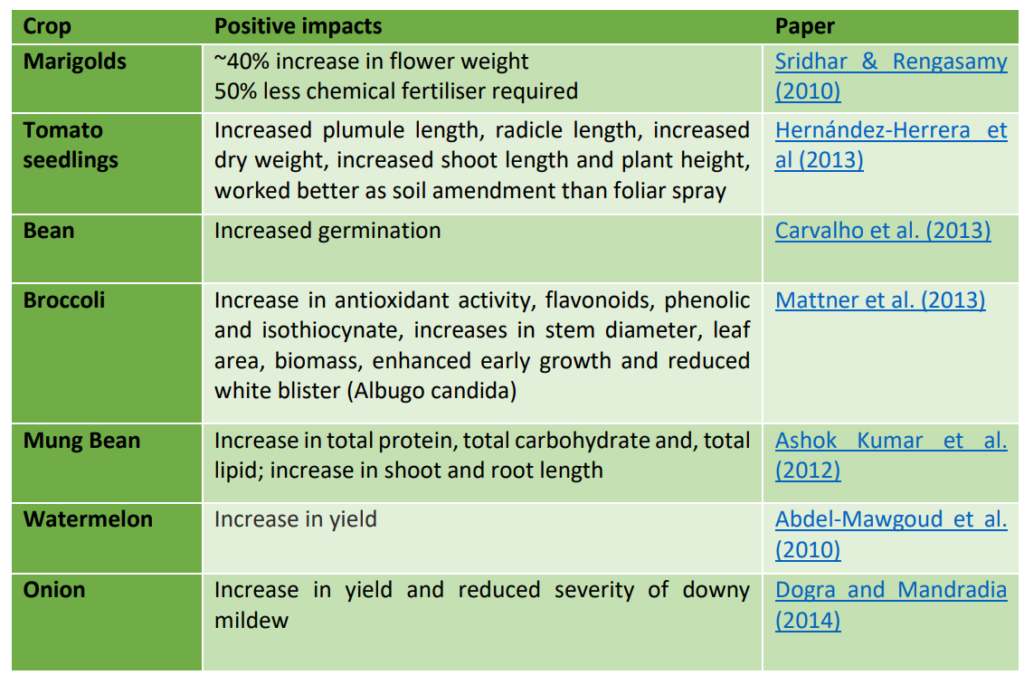
Across the three groups of seaweed, research suggests that green macroalgae have the most promise for soil supplementation as they contain components that can promote the removal of detrimental soil and plant fungi and pathogens (such as moulds and mildews) and drive increased plant defence. They have also been shown to have potential roles in preventing the damage from plant nematode species on crops which could act as a unique organic replacement to soil-applied nematicides.
Seaweed and seaweed products including biochar are known to have a neutral to alkaline pH which through direct application to soils can act to amend soil pH as a liming agent. Other outcomes causing this liming function seen within seaweed trials have been associated with
their levels of sodium (Na+ ) as well as high calcium (Ca) and alginate levels, which combined, are involved in the seaweed’s ability to bioaccumulate heavy metals. This removal of metals can impact pH by removing access to particles from soils which would normally cause increased acidity. Application of seaweed to contaminated degraded lands could also help with the removal of heavy metals such as aluminium (Al) thereby blocking/lowering the ability of Al to bind to plant limiting nutrients like phosphorus. This could in certain systems further help to reduce fertiliser requirements.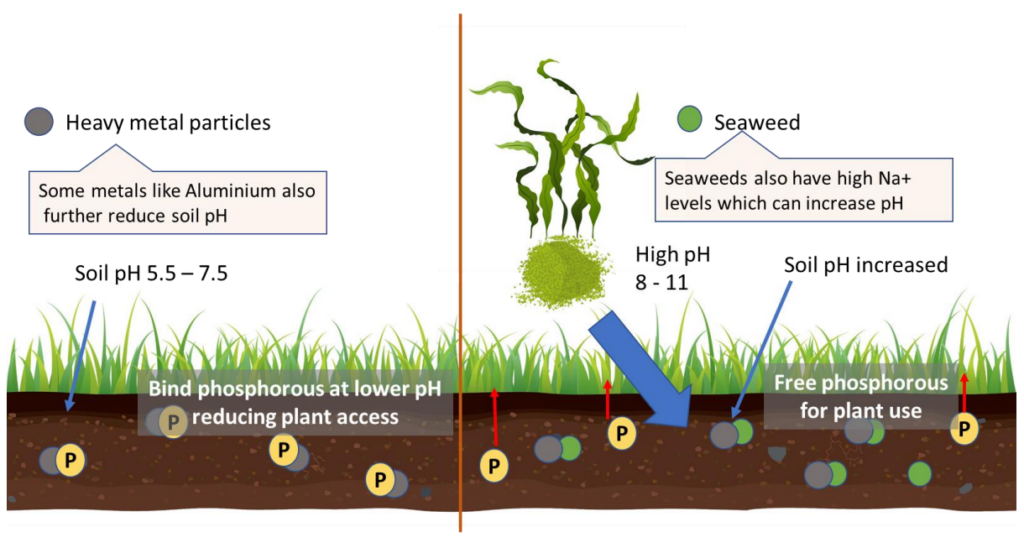
Furthermore, one of the properties of commercial seaweed additives that is often quoted is that their alginates have structural impacts on soils, forming complexes that help to absorb water improving water retention, increasing aeration and soil pore functionality and generally improving soil structure. This links with the interest surrounding hydrogel application on soils for unique slow-releasing fertiliser benefits along with improved moisture levels around plants in soils.
Barriers to use
Seaweed biomass needs more supply chain and market considerations in a lot of instances with direct site-based production and subsequent use ensuring that the material does not ferment and degrade, leading to it becoming just another form of waste that can have detrimental impacts including the release of detrimental gasses such as hydrogen sulphide. One method that can prevent this nutrient wastage and stabilise the beneficial aspects of seaweeds is to use composting. In one set of experiments using green seaweeds composted with sugarcane wastes re-applied to subsequent sugarcane growth, it was found that high seaweed composts led to four times higher aboveground biomass than commercial composts lacking seaweed. Even in studies where insignificant impacts on yield and weight of biomass occurred, it was still noted that benefits in the levels of micro and macro elements (such as boron, iron, copper, zinc, calcium, sulphur and potassium) were seen within the plant biomass harvested.
Sulphur compounds in high levels in some seaweeds may act in opposition to the liming ability when added to soils if anaerobic conditions are prominent (soils aren’t aerated) as this can lead to microbial oxidation of sulphur to sulphates.
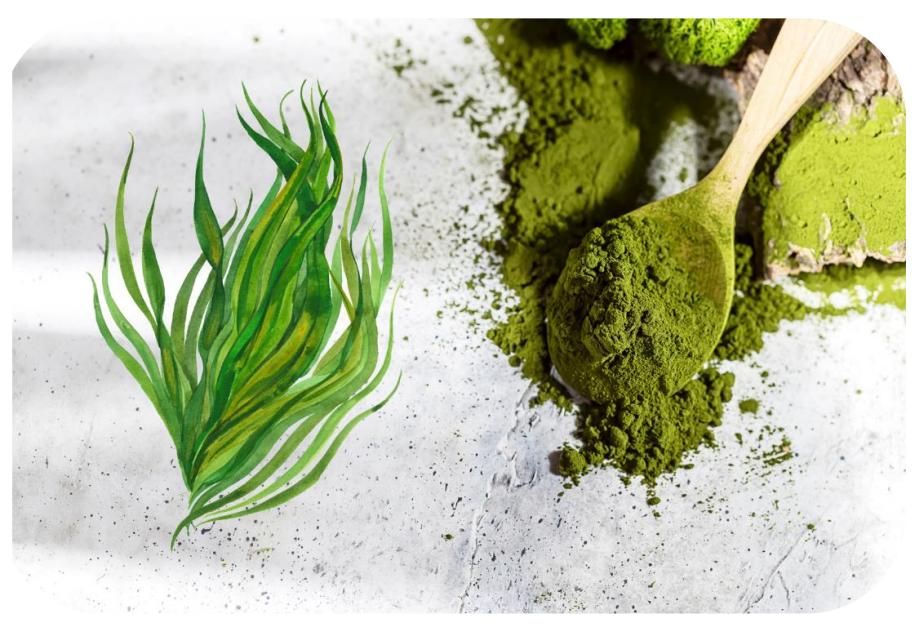
Feed for methane reduction
The other area where seaweeds have received a great deal of attention within agriculture is their suggested roles in livestock feed, with much research and media coverage focusing on their suggested environmental impacts.
Benefits
Seaweeds can be high in protein (up to 47% weight in some cases) whilst others have beneficial omega-fatty acid levels. This protein level aspect makes them desirable for consideration as an alternative protein source for livestock. When this is combined with the presence of naturally occurring compounds in seaweeds which impact the production of methane it is easy to see the interest. Seaweeds contain bromoform which acts to inhibit the final step in methane formation due to organisms in the rumen, and this is thought to be the main mechanism of action. Red seaweed species are known to have higher bromoform and similarly functional bromochloromethane levels. Across studies methane reductions of up to 100% (over short study timeframes) and 98% (over longer 90-day timeframes) have been observed, whilst other studies have noted far less reduction or even, in a few cases, some minor increase in methane level in the short term. These environmental impacts of seaweed as feed are of high interest for future net-zero strategies and as such we are likely to see more research to try and untangle these conflicting results in the future through large-scale trials.
Alongside methane impacts other reported feed effects have included live weight gain improvements and dry matter ingestion reductions.
Barriers to use
As noted above in the benefits of seaweed for fertiliser and soil application, seaweeds are very good at accumulating heavy metals, this is true in aquatic environments before harvest also. For this reason, testing and sourcing of seaweeds for livestock ingestion may need considerations to ensure any rations do not lead to impactful levels of adverse metals making their way into the animal’s body. Similarly, iodine toxicity for livestock as well as its incorporation into meat and milk may also be a barrier of consideration for the use of seaweed in feeds. High levels of iodine in seaweeds have been noted in one experiment to lead to milk produced with iodine levels as high as 3 mg/L which would make the safe tolerable limit of milk for adults around 300 ml a day and for children 1 litre of milk would contain over 15 times the suggested tolerable level. Whilst this is just one study it is enough to indicate that more research may be required.
Another possible barrier to use in livestock is the indication that there is a low level of palatability with seaweed inclusion in feed leading to reduced feed intake issues. Whilst many studies have shown inclusion rates up to 20% in sheep trialsthe average inclusion rate (across 10+ studies) was 12.8% (but ranged as low as 0.006%). This could be an area where specific extracted compounds from seaweed fare better than the whole product itself.
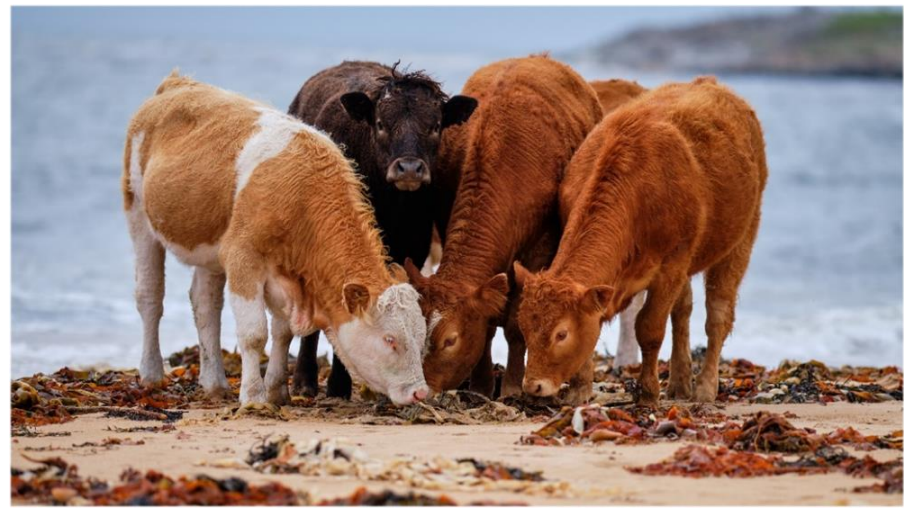
Other seaweed considerations
A big consideration surrounding seaweed utilisation is its potential value as a replacement for environmentally damaging fossil fuels. Seaweeds offer an interesting option for biomass growth for biofuel production for a few different reasons. Firstly, similar to plant-based biofuel options, seaweeds would be essentially carbon neutral. They also have promising biomass output levels and cost-effectiveness in their growth, but importantly they don’t impact land use change and don’t compete directly with any agricultural land application. This means that there can be no argument that it would be better to farm something else in place of seaweed due to the food vs fuel argument. This role could, however, be in direct competition for the supply of macroalgae for agricultural applications, unless excess was produced or methods were improved to separate the agriculturally important compounds from the biofuel beneficial biomass in an environmentally and cost-effective way. Furthermore, making seaweed incorporation feasible on a large scale would require direct seaweed farming across Europe to avoid import issues associated. Several publications have noted that there would likely be impacts on biodiversity associated with seaweed farming at such scales, though, as yet the true nature of impacts is unknown with some studies showing limited impacts and others showing a reduction in fish species biodiversity due to disturbances. This would require much more targeted experimentation before large-scale supplies could be achieved safely.
Artificial growth and farming of seaweed is a growing area of aquaculture with figures suggesting it accounts for ≥27% of total marine aquaculture production. Despite this, it is clear that much more research and development is needed on what species to farm/culture and how best to do this in the UK to have the level of resources for larger-scale incorporation into agriculture. Currently, the vast majority of seaweed farming occurs in Asia making export and import factors a huge consideration.
The prospects of seaweed farming are high as these systems of farming don’t compete with arable land or freshwater aquaculture and their growth has been linked with carbon mitigation strategies. Seaweed removal for use in agriculture could serve other environmental and economic benefits. One way this might benefit is that large-scale beach-cast of seaweeds are often associated with negative implications for tourism due to the appearance and smell during fermentation.
As such having mechanisms to collect this seaweed for beneficial agricultural purposes or any other beneficial purposes could go towards boosting the local economies of coastal regions. The compounds found within seaweeds are already discussed for their direct roles in pathogen control and biocidal activities. But another area of interest is in chemically altering these compounds to have improved effects, with much research suggesting interesting antimicrobial roles following modification. These could ultimately play roles in improving livestock treatment options and reducing the impact of antimicrobial resistances which continue to be of concern to the industry.
Summary
Seaweed’s and macroalgae’s agricultural use could have a role in circularity, particularly in coastal regions or where farming practices increase eutrophication of nearby water sources and this leads to increased waterway macroalgal growth. Rather than allowing this to impact ecosystems, harvesting it for application back onto agricultural soils or feeds could be beneficial. For soil application, consideration of seaweed supply chains needs evaluating to ensure the logistics and cost (economic and environmental) vs value benefits of the application are fully understood. Furthermore, seaweed appears to work better in healthier soils where strategies are in place to reduce the levels of anaerobic microbial activity. This suggests it would work well in combination with sustainable practices such as cover cropping and silvoarable farming. Macroalgae for livestock feed on the other hand have potential as an alternative protein source with some interesting environmental impacts that need further evaluation in large-scale trials. Green seaweed species show promise for soil application whilst red seaweed species show more promise for livestock use avoiding competition between these two products.

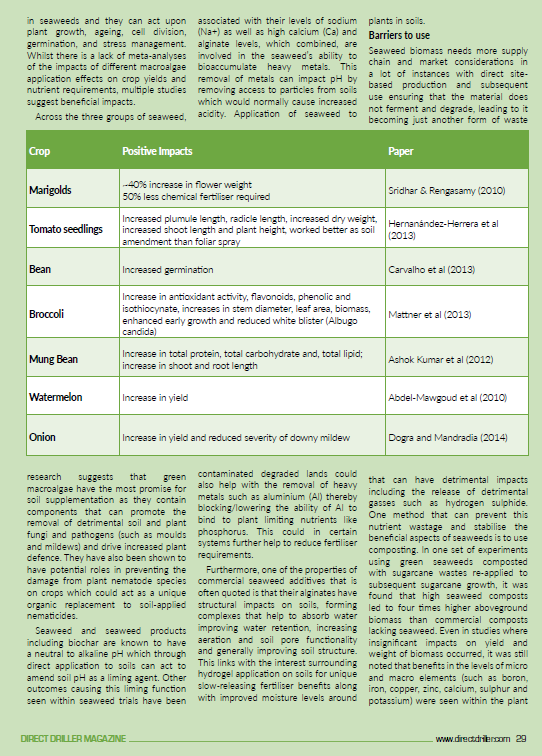
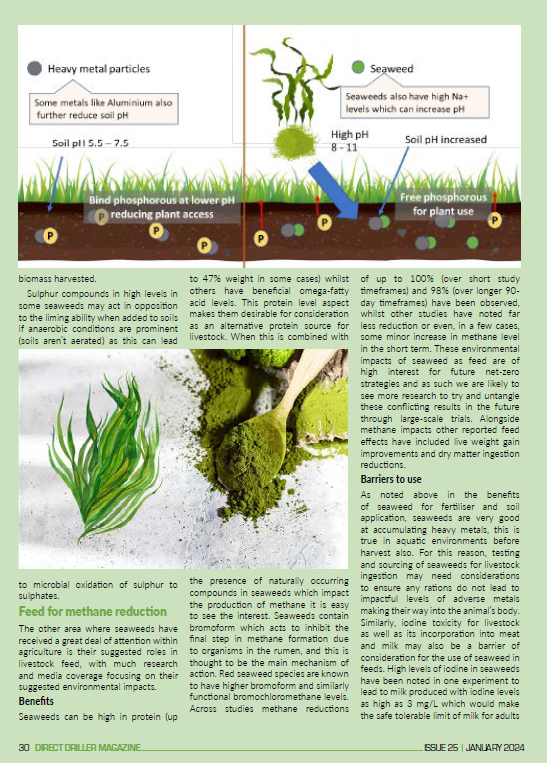
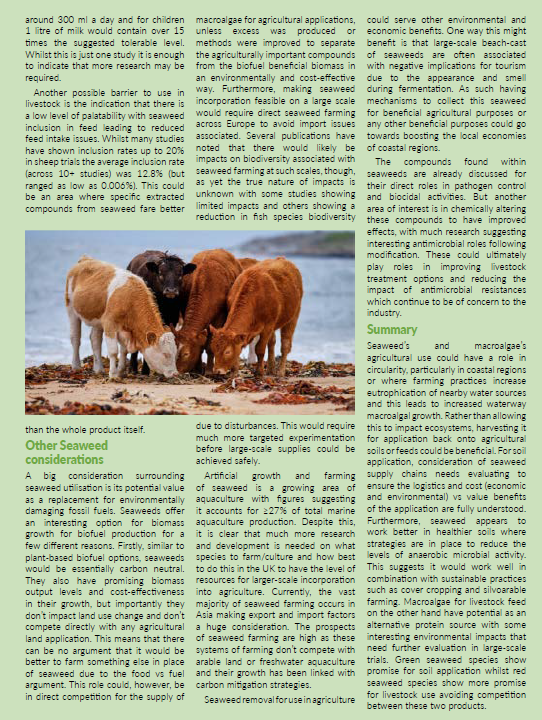
-
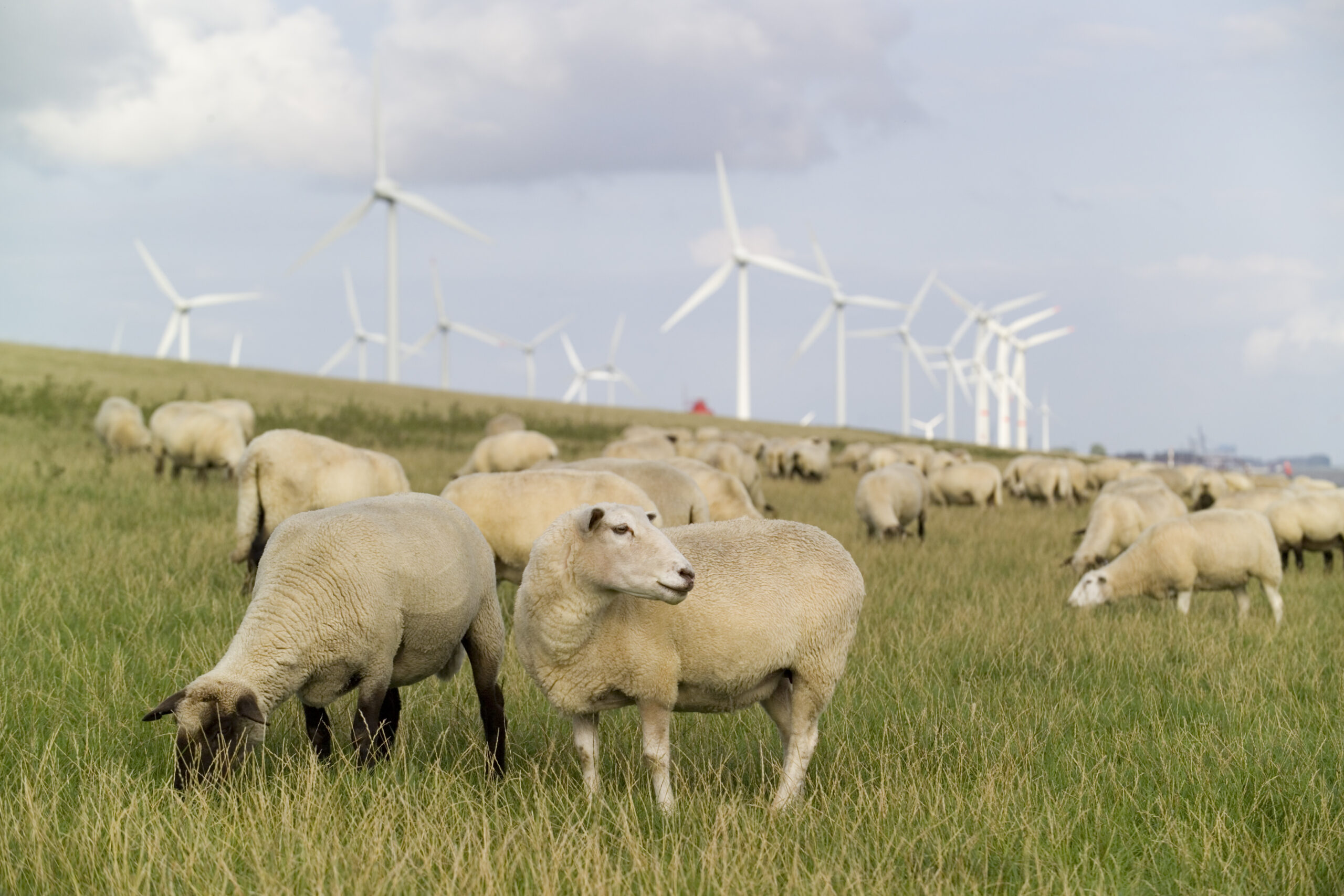
Is it time to make the most of the Sustainable Farming Incentive?
Knight Frank’s Mark Topliff writes why the Sustainable Farming Incentive (SFI) is now worth considering and consultant Andrew Martin provides an example of how arable land can make the most of the scheme.
When the SFI was launched in 2022, it was generally met with a lukewarm reception by farmers and environmental organisations. English Basic Payment Scheme (BPS) payments are working towards their potential cessation by 2027, and most farmers are seeking other sources to fill or mitigate the drop in income. Defra has made changes to the SFI that has made it a more attractive option to explore and help fill the income shortfall.
Why is SFI 2023 worth engaging with?
So, there are several reasons why the 2023 offer is now worth considering.
- More flexibility – the pick and mix structure allow land managers to select the actions that may fit in with existing practice and rotation or are easy to adjust to and incorporate changes.
- Higher payment rates – since the start of SFI the payment rates have been criticised, but they have now been increased, and some rates made the same across land types and schemes.
- Tenant-friendly agreements – you don’t need the permission of your landlord to apply for an agreement if you’re a tenant farmer, and tenants can have an SFI agreement even if they are on a shorter, rolling tenancy contract.
- Stacking of options – it’s possible to combine with other schemes’ options such as Countryside Stewardship and Environmental Stewardship.
- Management payment – payment of £20 per hectare, up to 50ha in total, for your time managing the scheme.
- Simple application – A simple online application process and a rolling application window.
- Paid quarterly – more frequent payments which help with cashflows.
- You don’t lose out – Defra has shown that previous applicants that joined prior to any changes will also benefit from the improved offer.
Defra has also promised further options to be rolled out in 2024 possibly including actions involving agroforestry and water body buffering.
Using the SFI on arable farms
But what does this mean for an arable farm? Andrew Martin of Knight Frank’s Agri-consultancy team explores how the SFI actions can be combined to maximise payments, using an example 100 ha block of arable land.
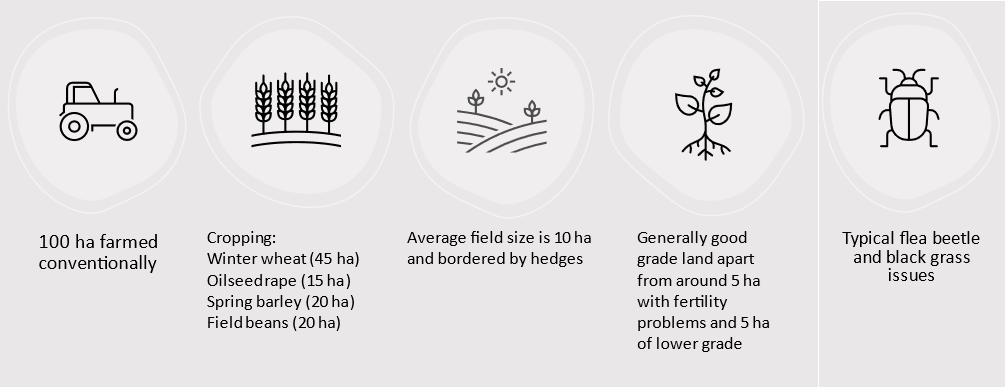
Arable land example
Possible actions that could be selected in this 100 ha example
Action Brief description Reason selected Area included (ha) Payment received/year (£) SAM1 Soil assessment and plan If not already being done as part of crop assurance, then a reasonably straight forward payment that could have greater benefit 100 675 SAM2 Cover crop Spring barley’s inclusion in the rotation provides an opportunity to have an over winter cover crop 18 2,322 IPM1 Assess integrated pest management and plan If not already being done as part of crop assurance, then a reasonably straight forward payment that could have greater benefit 100 989 IPM4 No insecticide used To be used with the spring barley and field beans which requires little insecticide use 36 1,620 AHL2 Winter bird food Problems with OSR on this farm could mean the break crop is replaced by this rotational action instead 13.25 9,699 AHL3 Grassy field corners and blocks Many fields have areas that are unproductive or difficult to harvest 1 590 AHL4 4m grass buffer strip Field edges can be the least productive areas 5 2,225 NUM1 Assess nutrient management and plan Once set up, a relatively straight forward action to carry out each year 100 589 NUM3 Legume fallow To help improve the fertility 5 2,965 Subtotal 21,704 Hedgerows HRW1 Assess and record condition Relatively straight forward action 12,650m 380 HRW2 Manage hedgerows Payment for an action that would be carried out anyway 12,650m 1,265 Subtotal 23,349 Including SFI management payment at £20 for the first 50 hectares Total income 24,349 For this 100 ha block of arable land, the options in this example would return an income of £23,349 or £233/ha. This is comparable to the Basic Payment Scheme payment (BPS) pre-tapering, but before any costs involved in the implementation of any of the SFI actions.
The non-rotational areas that take the low fertility and productive areas out of production (see table below) would return an average guaranteed income of £528/ha/year.
Amended crop rotation and areas across the 100 ha block
Rotational areas Winter wheat Winter bird food Spring barley Field beans 39.75 ha 13.25 ha 18 ha 18 ha Non rotational areas Legume fallow Grassy corners 4m buffer margins 5 ha 1 ha 5 ha *note that the legume fallow option can be used rotationally but in this example, it is used to improve the fertility of the 5 ha parcel.
Typically, the average net margin across a crop rotation similar to that in the example, would be in the region of £200-£250/ha/year before rent and finance costs.
When SFI establishment and maintenance costs are deducted, the fallow and grassy area margins are likely to be similar if not better than compared to the crops, when spread over the lifetime of the SFI agreement.
Andrew explains that: “The range of actions selected in this example could easily be applied to other situations. But the key to this selection is that it could fit in with the existing system and take out or improve the unproductive areas.”
“Even though in this arable scenario the SFI payments won’t cover the complete loss of the BPS, they will reasonably offset it and certainly more than was offered in the 2022 SFI standards,” adds Andrew.
Conclusion
SFI 2023 has improved its offer and flexibility over its initial launch in 2022. It certainly isn’t a perfect scheme, and it will evolve further in the next couple of years. But when considering SFI alone, it can now bring a reasonable income to arable and lowland livestock farms. However, it does require some careful thought to get the best mix of actions and maximise the income potential. True, there are probably many actions that would be a light touch on most farms but making some considered changes to your farming system may further increase the SFI income and potentially benefit your farm’s economic and physical performance.
Andrew Martin can be contacted at andrew.martin@knightfrank.com. Further insight and information on Knight Frank’s rural services can be found at www.knightfrank.com/rural-matters

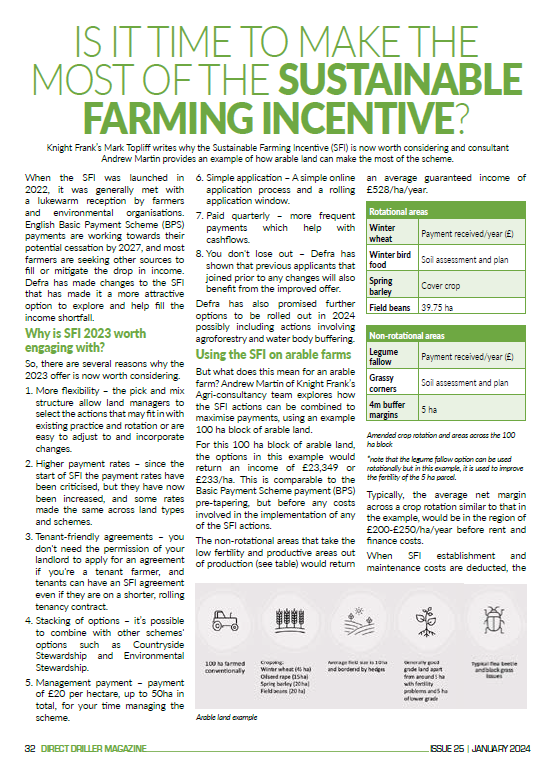
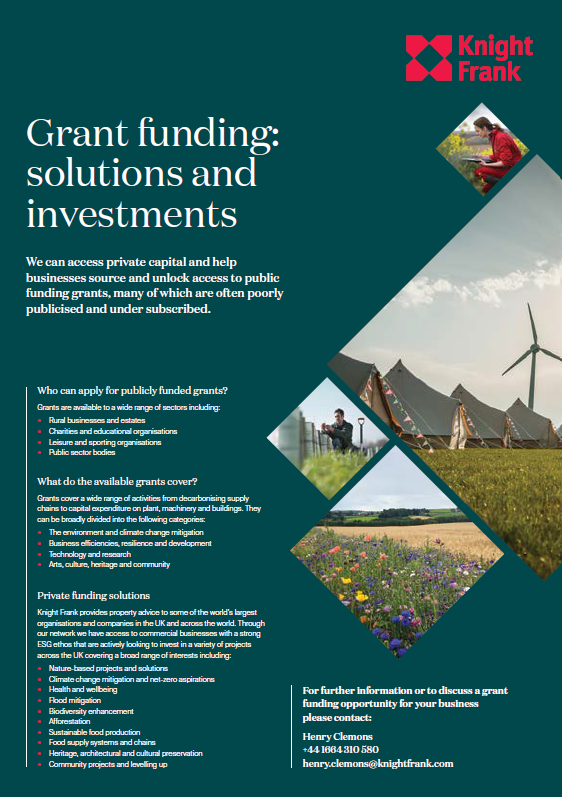

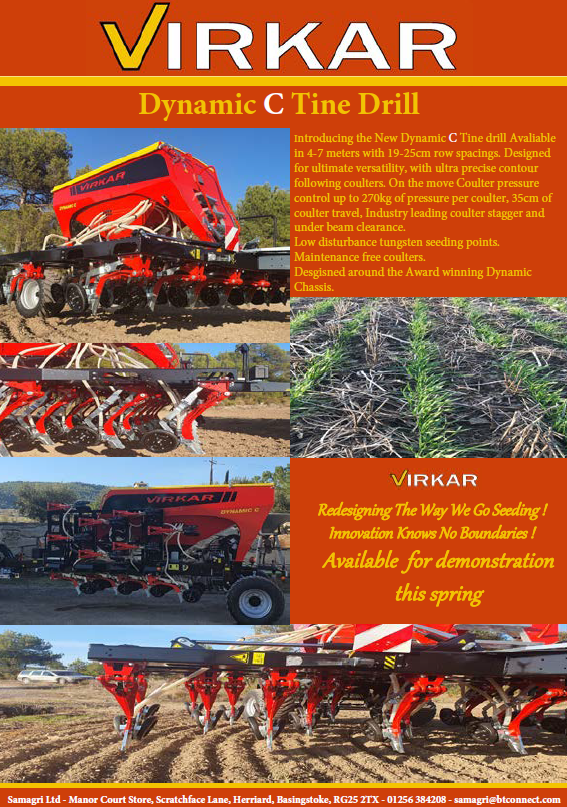
-

Organic and regenerative together at CropTec Show
Written by Jerry Alford from the Soil Association
For Soil Association Certification, hosting the Regen Zone at this year’s CropTec Show was an opportunity to meet many of the farming community who are embracing regenerative farming and highlight similarities and the benefits farmers can learn from each other.
Regenerative agriculture is an exciting grassroots movement, which is energising a whole new generation of farmers who are keen to be part of the solution to the nature and climate crises. For many existing organic farmers there is a slight feeling of déjà vu with echoes of the organic movement from 70 years ago. There are strong similarities between the principles of regenerative – increasing diversity, ground cover, minimising inputs and protecting soil – and the practices common in organic.
So, what separates organic from regenerative? Ultimately, we think they have the same North Star. It’s soil-first farming – which is why we hosted CropTec’s Regen Zone. There is much more that unites us than separates us, but a key difference is how we perceive each other, and how consumers and supply chains perceive us.
Organic is a farming system with a legally binding definition, based around a soil first attitude and, as an internationally recognised practice, is based on sound science and decades of experience. For a non-organic farmer who believes in the principles of regenerative, they might see those organic standards and regulations as restrictive and prohibitive. For those within the organic movement, these same standards and regulations are seen as a floor not a ceiling, and a useful tool to help differentiate themselves in the market. But even at the entry level, organic takes a systems-based approach that works within natural cycles – defining organic just by its standards ignores the whole farm system which makes it possible. And organic enables both farmer and consumer to be clear about the standards that the farming system has been working to.
For example, organic farmers must find natural ways to build soil fertility and manage pests and diseases because they’re not allowed to fall back on short-cuts such as artificial fertilisers or routine use of antibiotics to maintain soil and animal health respectively. The standards are a baseline – they ensure there is a consistency to what someone can expect, as a minimum, when they see something is certified organic. In reality, many organic farms and businesses will naturally go above and beyond these baseline standards.
There are areas of differences, agrochemicals and artificial fertilisers are used by some regenerative farmers but are not permitted in organic systems. And minimising cultivations is a priority for regen, but not always easy in an organic context. But we’ve always known that no farming system is perfect, and one of the positives being seen today is the willingness of both groups of farmers to learn from each other. Living mulches, cover crops, composting, intercropping and increasingly diverse rotations are becoming common in both forms of farming, and are no longer used to define the farming system.
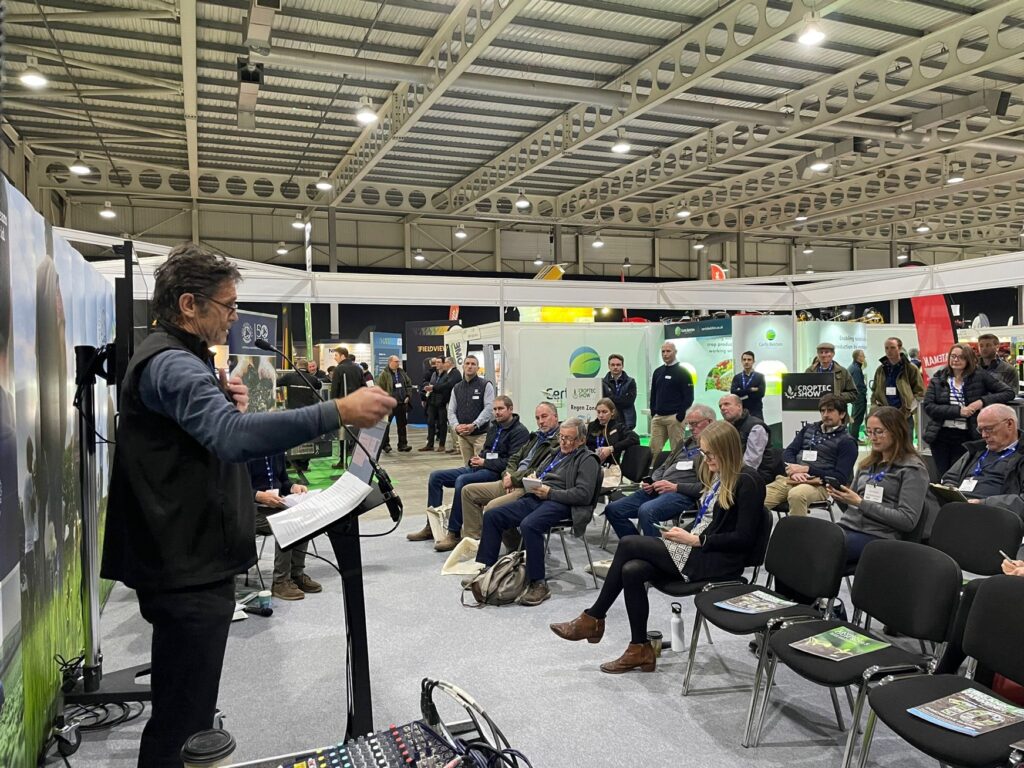
And we shouldn’t seek to rush into a definition. By more simply being guidance, rather than rules, the five regenerative principles allow flexibility both within innovation and in farming systems. Not everyone has the desire to introduce livestock into their systems and not all regenerative farmers soil allows them to direct drill every year, but the general trend is to move farming in a more nature and soil friendly direction.
For the Soil Association’s team of farming advisors, working with farmers who share a vision of soil-first farming is a great opportunity for increasing the knowledge base in organic whilst highlighting what we have learnt about farming without recourse to artificial inputs. Working with regenerative farmers isn’t a means of developing a certification process, but a way of influencing and using the years of experience of success and failure to support the regenerative movement to continue its direction of travel. We are no longer being asked “how do you expect to grow crops without fertilisers and sprays” but “how can I?” – and that makes the regenerative movement an exciting time for all farming, organic or not.
Jerry Alford – Arable and Soils Advisor in the Soil Association’s Farming Team which provides advice on nature-friendly farming to any farmer.
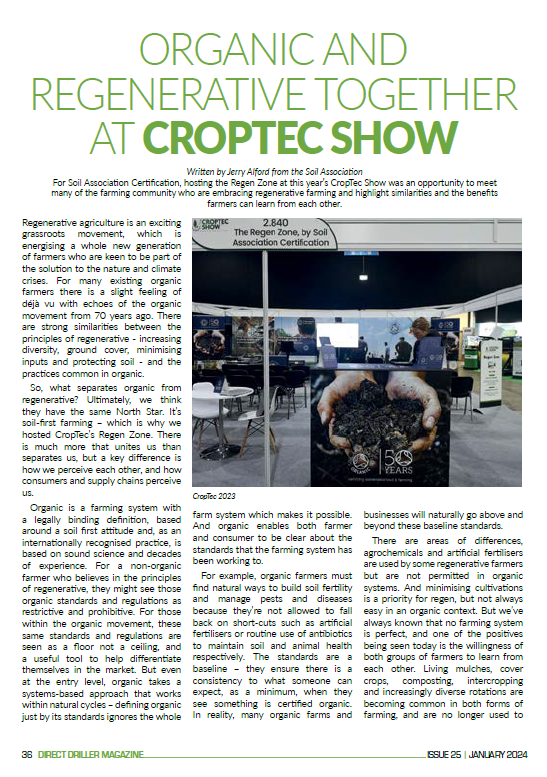
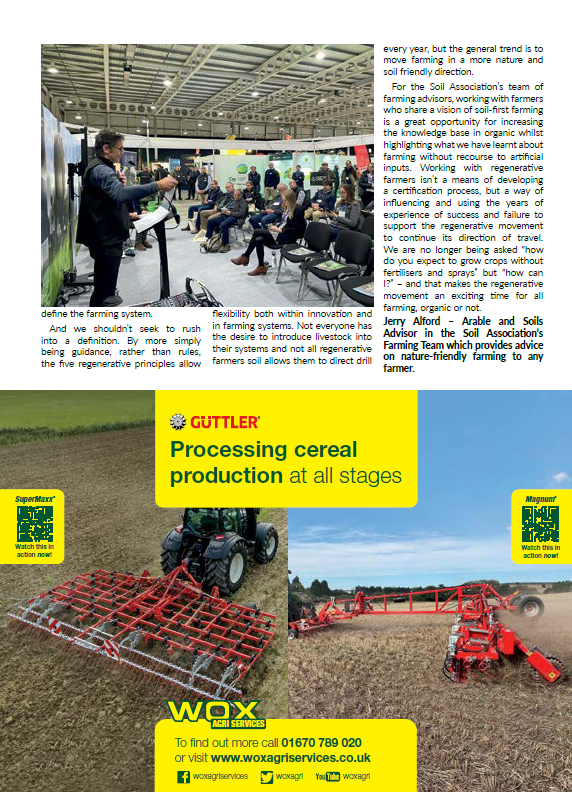
-
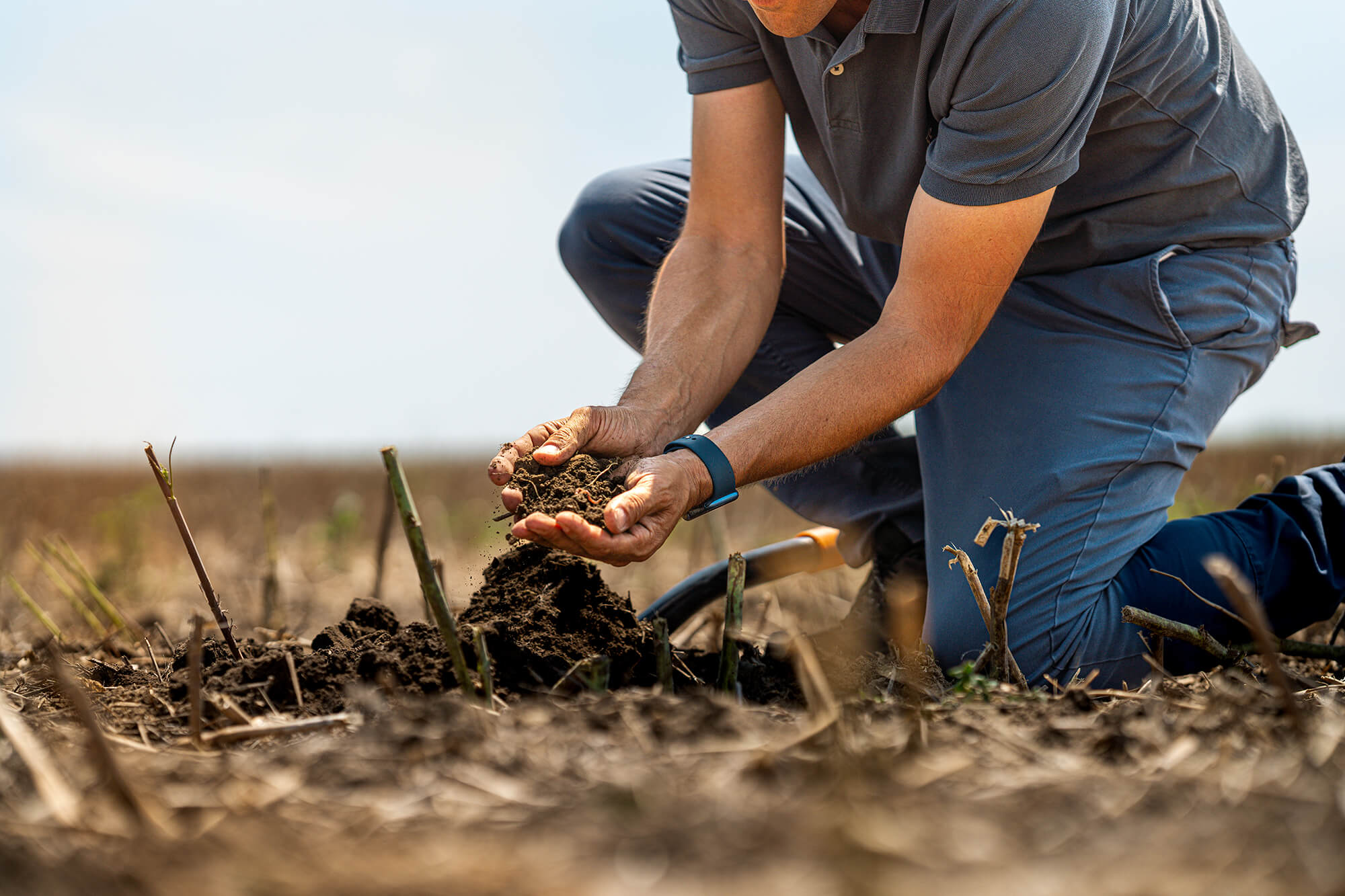
Understanding carbon emissions and the voluntary carbon market: A farmer’s guide to a sustainable future
Written by Thomas Gent, UK Market Lead, Agreena
As farmers, you’re not just growers of the crops that provide food for us all; you’re stewards of the land. In today’s evolving agricultural landscape, it’s crucial that farmers understand how sustainable farming practices help reduce agriculture’s impact on the environment and how this understanding can be translated into financial gains.
To help achieve this understanding, farmers need to familiarise themselves with the concept of carbon emissions, particularly Scope 1, Scope 2 and Scope 3 emissions, and see where their business fits within these scopes, the grain supply chain and the importance of participating in the voluntary carbon market (VCM) in order to clearly see the value of their farming practices.
Scope 1, 2 and 3 emissions: What are they?
It’s essential to grasp the concept of carbon emissions scopes so that farmers understand the role they can play in carbon trading via the VCM and the impact this can have on grain supply chains.
Scope 1 emissions: Direct emissions that originate from sources owned or controlled by your farm. For farmers, Scope 1 emissions can include emissions from tractors, on farm machinery and other equipment, as well as emissions from enteric fermentation in livestock.
Scope 2 emissions: Indirect emissions associated with the consumption of purchased electricity, heat or steam. For many farmers, this primarily involves energy use on the farm, such as electricity for irrigation or heating.
Scope 3 emissions: Indirect emissions that occur as a result of farming activities but are beyond farmers’ direct control. They can include emissions from the production of fertilisers, pesticides and fuel used in transportation of your products to market.
Scope 3 is of significant interest to farmers because they sit within the Scope 3 emissions of the food supply chain. As these companies set ambitious targets for reducing emissions, they’ll have an increasing interest in the activities taking place on farms, leading to both pressure on farmers to reduce emissions while at the same time presenting opportunities for farmers to deliver climate friendly products.
The agricultural sector plays a significant role in greenhouse gas emissions, particularly methane (CH4) from livestock and nitrous oxide (N2O) from fertiliser use. Understanding the carbon emissions associated with farming practices, including within Scope 1, 2 and 3, is crucial to not only mitigate their impact on the environment, but to enable farmers to explore new income opportunities.
The VCM: A sustainable opportunity
The VCM is where individuals and organisations voluntarily compensate for their carbon emissions by investing in projects that reduce or sequester carbon, allowing market participants to take action against climate change and for the planet to move towards net zero.
How the voluntary carbon market can benefit farmers and impact grain supply chains:
Carbon credits for sustainable farming: By adopting sustainable farming practices that reduce carbon emissions, farmers can generate carbon credits which reflect the amount of carbon dioxide equivalent (CO2e) emissions reduced or sequestered.
Revenue generation: Farmers can sell these carbon credits in the VCM. Companies and individuals buy these credits to compensate for their own unavoidable emissions, making farmers a valuable player in the fight against climate change.
Enhanced grain supply chains: As consumers and companies increasingly prioritise sustainability, organisations within grain supply chains are looking to demonstrate that they’re reducing their carbon footprint. By participating in the VCM, farmers can position themselves as sustainable suppliers, attracting buyers willing to pay more for climate-friendly farmed products.
How to get started
Assess your farm’s carbon emissions: A recognised carbon calculator will help you determine your baseline and will also identify emissions within Scopes 1, 2, and 3 and allow you to pinpoint areas for improvement.
Implement sustainable practices: Adopt more sustainable farming practices that reduce emissions and increase carbon sequestration. This might include no-till or reduced-till farming, cover cropping and efficient energy use.
Monitor and measure: Using a carbon calculator, continuously monitor and measure the impact of your sustainable farming practices on your carbon emissions. This data is essential for accurately quantifying and verifying your carbon credits.
Decide how to market your sustainable impact: There are many options available to you to decide how to use your new carbon credits. You can keep the credits for as long as you wish, you may trade them yourself or via a broker on the VCM, or you can trade them within the supply chain.
Carbon farming made simple:
The easiest way to follow all of these steps to an auditable and verified standard is to join a carbon programme like AgreenaCarbon. Within a carbon programme, you’ll have the opportunity to gain an understanding of the value of your efforts on the farm. This will give you the opportunity to trade your carbon either within the supply chain or via the VCM.
Joining a carbon programme keeps you in the driving seat of your transition and allows you to understand the value your carbon has on your farm. Good carbon programmes should support and incentivise the use of more soil health-focused farming practices.
The future of farming: Sustainability and profitability
The crossover between farming and carbon accounting is going to become increasingly important. Farmers’ customers are setting ambitious climate goals that will affect what they buy and value. It’s essential that farmers remain in control of this valuable asset and utilise it to finance their transition to a net zero future. The agricultural sector is transforming, offering opportunities for farmers to both contribute to a greener planet and enhance their income.
By understanding and managing Scope 1, 2 and 3 emissions and participating in the VCM, farmers can use this new revenue stream to move towards their own net zero goals and therefore bring value to their products – not only to make their farming practices more sustainable, but also to increase profitability through higher grain prices and new income streams.
The future of farming lies in sustainability. Those farmers who embrace carbon trading, reduce carbon emissions and engage with the VCM will not only play a pivotal role in combating climate change, but also secure a more prosperous and sustainable future for their farming business.


-
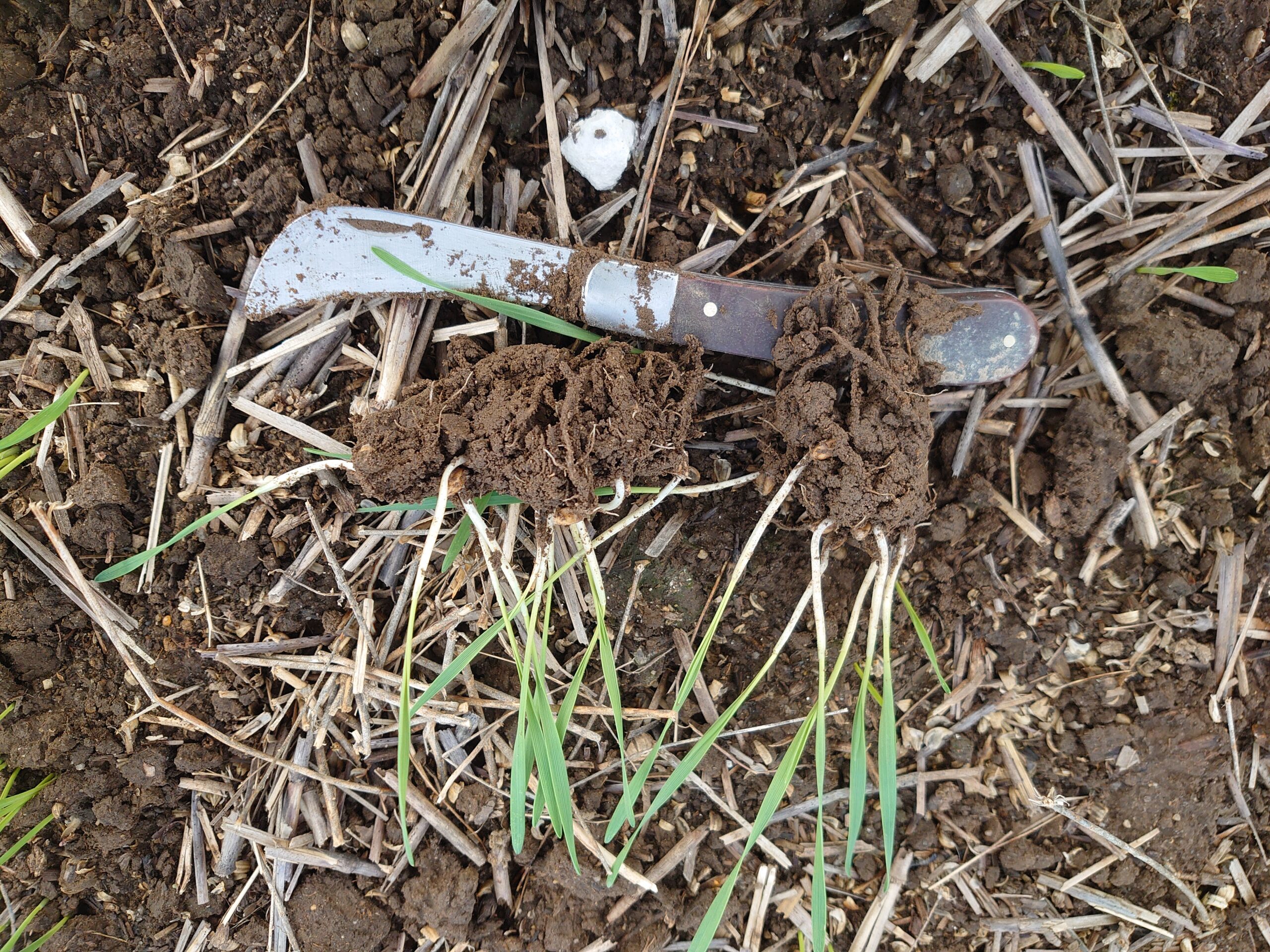
Farmer Focus – Andy Howard
Dec 2023
Like all farmers I am an eternal optimist and have decided to roll the dice again with another year of cropping. Things will be better next year? Hopefully! This autumn I think we have been lucky down in Kent. I didn’t start raining until the 12th of October and the soils were very dry and so have taken the rain well. Since then, we have had nearly 300mm of rain by the end of November, not ideal but the crops got established well and their heads above ground before the ground got too wet. We haven’t planted 10ha of Winter Beans, but these 2 fields can wait until the spring.
Our soils this year have not emerged from the latest wet year in good health. On the heaviest land, when I was going around with a spade after harvest the top 20cms had slumped. Roots were going through this layer, but I decided the soil needed some remedial action. I borrowed a neighbour’s LDS and subsoiled 90ha of our farm. After having done very little subsoiling in the past, I probably did more in 1 year than the previous 20. I do wonder with the weather patterns being more extreme and the rain being more intense that this may become more “normal”. We do have a couple of wheat fields that were herbage seed until harvest 2022 before going to winter beans, these fields are showing more yellowing than others and I think this could be due to the higher trafficking from the herbage seed leading to poorer soil structure, even though these fields yielded 5t/ha of winter beans.
Our cover crops look well, the cover crop species of the year seems to be linseed. Linseed seems to be the dominant species for some reason. One idea, I think is because slugs don’t particularly like eating it. The slug pressure seemed to be high in our cover crops this year and where the slug pelleter on the back of the drill stopped working for a few runs, linseed is about the only plant species to have survived. Anyone who tells me we should keep cover crop mixes simple and just plant a couple of species, I think are bonkers or don’t know what they are talking about! We seem to get a different stand every year even when planting a similar mix, a broad mix spreads your risk.
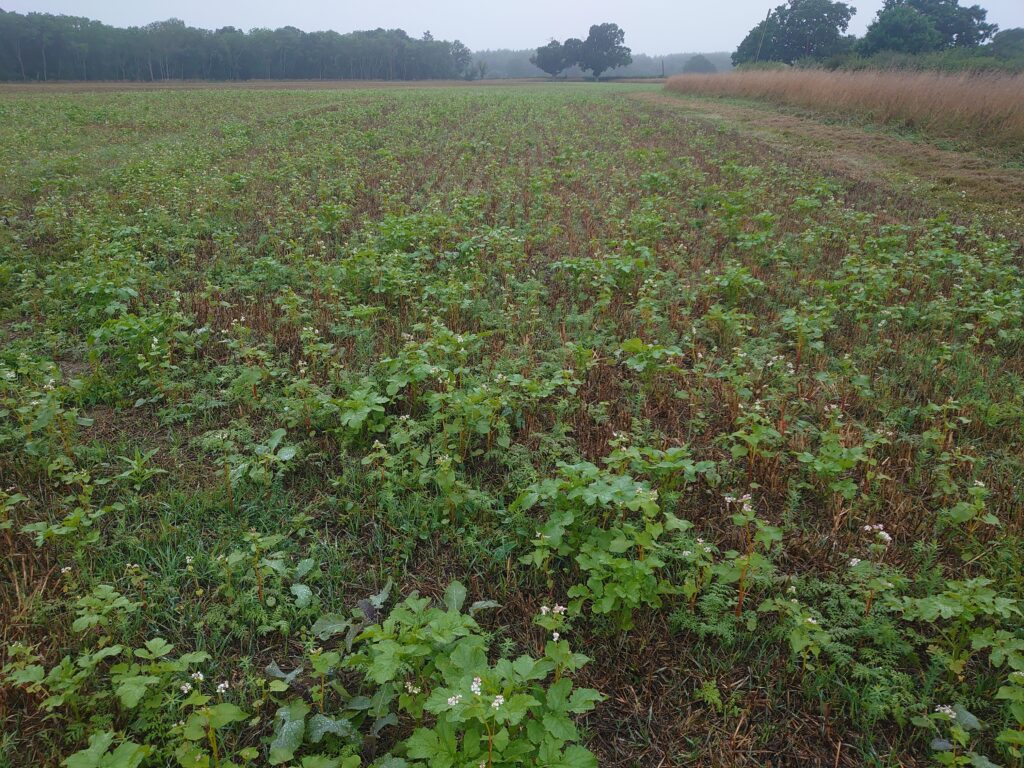
Catch Crop Recently in the farming press there was an article talking about how spraying silica onto the previous crop and then saving the seed reduces the slug grazing when the saved seed is planted. I think we have seen this in action as all our farm saved seed probably didn’t need any slug pellets, where we didn’t pellet the wheat, it looks as good as where we did. All our cover crop seed was bought in.
We tried to plant a lot of catch crops this summer but unfortunately our old Autocast system tried to set our combine alight. All the wiring melted but fortunately I saw the smoke and turned everything off pronto. There wasn’t time to fix it to make it safe so the rest of the catch crops didn’t get planted (see picture). I am coming to the conclusion that Autocasting is better than using an Outcast a few weeks before harvest. If there is enough moisture a few weeks before harvest, you really need to apply slug pellets with the seed, otherwise you just have to sit and watch them chew through the emerging crop. The problem with spreading pellets that near harvest, is that some may get stuck in the wheat ears and end up in the grain lump, so I avoid doing it. With Autocast you can spread with the seed or soon after harvest.
We have numerous trials going on this year. With Kings Crops we have planted plots for companion crops in Wheat and Beans with the SFI in mind. With Wheat we have planted Winter Vetch, Winter Peas, Avalon beans and a mixture of all 3. They all look well. With the Winter Beans we have planted Winter Oats and Winter Vetch (see picture). Even though the Propyzamide has knocked the oats they are still all there. The establishment of the companions this year gives me confidence to apply for SFI with the cover crop and companion crop options. Unfortunately, ATM the computer is saying NO! Any field with an option from our existing Mid-Tier scheme seems to upset the SFI algorithms.

Bean, Oat and Vetch This autumn we have planted a trial examining the effects of compost extract on the growth of wheat. Alongside Kent Wildlife Trust and Reading University we applied to The Co-Op for grant funding, and we were successful. The idea is to investigate over 2 season whether compost extract can help reduce the reliance on Nitrogen fertiliser. An initial check on the effect on rooting 10 days after planting seemed to show a marked difference (see pic – no extract left, extract right). A more in-depth check at the end of November seemed to show little difference, also plant establishment counts between the plots at a first look seemed to show little difference. My gut feeling is the extract will show positive effects in an adverse growing season, this autumn so far on this field has been fairly kind, what happens in the spring will be interesting.
Finally, we have been awarded follow-on funding for our N2 Vision Project that finished 18 months ago. Along with our project partners we will trial the robotic platform along with an algorithm for sensing Nitrogen content of wheat over the next growing season, to refine/develop the system to get it closer to a commercial reality. All in all, plenty to keep me busy over the next year!!


-

Soil health takes centre stage at direct drilling demo
Around 100 farmers from across East Anglia attended a recent demonstration day in Suffolk, where drills from leading manufacturers were put through their paces in a variety of establishment situations.
The event at Street Farm on Ampton Hall Estate, near Bury St Edmunds, was organised by leading agronomy firm Farmacy, and kindly hosted by Strutt & Parker (Farms) Ltd and the Turner family. It provided a stage to discuss the attributes of different machines in a range of situations, from bare stubble to green cover crops. The demonstration also centred on the importance of understanding soil properties to ensure any cultivation, drill, or management strategy was ‘fit for purpose’.
“The trial is not about finding out which drill is the best, it’s to show some of the areas that we as agronomists and farmers need to be thinking about,” said Farmacy agronomist, John Chamberlain.
“With more and more growers looking at, or now practicing, direct drilling, minimal tillage, low disturbance cultivations, cover crops and the like, there are so many permutations when it comes to establishing a crop. Drill technology is also advancing at quite a pace, and buying a new machine is a considerable investment, so we want to explore all of this in more detail to better understand what will – and won’t – work in different field situations.”
Six drills, six plots
The demonstration centred around a field-scale trial where each of the six drills (see box) was tasked to direct-sow KWS Serafino winter rye into six different seedbeds, which included:
- Bare rye stubble
- Low disturbance subsoil (Sumo LDS) and disc (Horsch Joker)
- Low disturbance subsoil only (Sumo LDS)
- Standing cover cover crop (MaxiCatchCrop – buckwheat, white mustard, berseem clover)
- Mown & sprayed off cover crop (MaxiCatchCrop)
- Ploughed and pressed
Mr Chamberlain said plots would be monitored throughout the season, with plant counts and other assessments conducted over the autumn and winter, before being harvested for forage next year to supply a local biogas plant.
Winter rye was specifically selected for the demonstration due to its sensitivity to drilling depth and pre-emergence herbicides, which should help to highlight any variations in drill performance, he noted.

Making soils work for you
Alongside the drill demonstration, growers also had the opportunity to look beneath the surface of the sandy loam soil at the farm, where Hutchinsons head of soils, Ian Robertson, highlighted the importance of understanding soil chemistry to make soils function better for both crops and machinery.
“A lot of soil structure is driven by chemistry, so understanding that is key to getting your soil working effectively,” he said.
That was clearly illustrated by Terramap high definition soil analysis of the demonstration area (‘Keepers Field’), which explained why one part of the field had historically been harder to work than the rest.
“We initially thought it might be because of higher clay content in that area, but Terramap showed that while there were some small variations, the difference in workability was actually more due to the calcium to magnesium ratio,” Hutchinsons digital services specialist, James Lane explained.
“There was a much higher magnesium content in the bottom corner of the field, which was making soil in that area tighter, stickier and harder to work.”
The same area also recorded higher organic matter, but because the Ca:Mg ratio was out of balance, this had little impact on improving workability. Understanding those interactions meant targeted management measures could be put into place, he added.

Soil chemistry played a major role in the availability and cycling of nutrients too, Mr Robertson continued.
High pH soils, as in Keepers Field for example, were at greater risk of phosphate becoming locked-up in the soil, therefore in such situations, it was more effective to use small amounts of placement fertiliser with seed at drilling, rather than a broadcast surface application. All of the drills in the demonstration had the capacity to apply seed and microgranular compounds where required, with versatile hopper and metering systems.
Cover crop benefits
Another area Mr Robertson urged growers to focus on was the use of cover crops to improve soil conditions and “feed” the microbial activity needed to cycle nutrients effectively.
“Every soil has a ‘deep freeze’ of nutrients, and if we get it working well, soil will cycle those more efficiently and into an available form that plants can use.
“Microbial activity is one of the biggest factors influencing nutrient cycling, so it is vital we feed that activity and ‘pull’ nutrients out of the deep freeze by providing green cover throughout the year. It’s about getting soils to cycle nutrients better, not putting more on.”
Analysis of the MaxiCatchCrop that was sown in Keepers Field after this harvest and terminated in the first week of September, revealed that even though it had only been in the ground for a few weeks, the mix had made a significant contribution to nutrient cycling.
Some 17 t/ha of fresh weight had been put on, which contained 77 kg/ha of nitrogen, 946 kg/ha of carbon, and valuable amounts of other macro and micro nutrients. For nitrogen alone, assuming around one-third of that total was available to the following crop, in monetary terms it was worth around £30/ha, which was a valuable saving, especially on lighter land where nutrient retention from applied fertilisers could be more challenging, Mr Robertson said.

“The carbon benefit from the cover crop is also important. We only measured the above ground biomass, but don’t forget about all of the sugars, carbohydrates and lipids cycling beneath the surface to feed microbial activity.”
The diverse root growth of mixed species cover crops was also a valuable tool for improving soil structure, especially on the high sand content soil, which could be at risk of becoming “tight” in a direct drilling situation.
When examining the soil profile, Mr Robertson noted a clearly defined surface layer of darker soil, high in organic matter within the top 30 cm, however beneath that, soil was less friable, drier, lighter in appearance, and lacked the same organic matter and worm activity as the upper layer (see image).
“Ideally, we don’t want to see distinct joints between layers of the soil; it should be more of a murky transition as roots and worms help penetrate layers and mix material around. The best way to manage soils in this way is to put as many living roots in there as possible.”
Additionally, roots helped to manage water throughout the profile, as living plants pulled water up from depth, and additional organic matter benefitted water retention – something that was particularly important on lighter, sandier soils, he added.
The six drills on show at the Farmacy demonstration included:
- Horsch Avatar 6-16SD
- Horsch Sprinter 6ST
- Horizon DSX 60-20
- Mzuri Pro-Til 4T
- John Deere 750A ProSeries Opener
- Vaderstad Proceed (original prototype)


-

Relentless rain creates significant challenges
This year’s numerous challenges continued into autumn on the Claydon family’s arable farm in Suffolk, writes Jeff Claydon, who invented the Opti-Till® direct strip seeding system.
Date: 27 November 2023.
What a difference a year makes! I started my last article for Direct Driller, written on 29 August, by suggesting that further agronomic, meteorological, political and economic headwinds would likely continue to test our resolve in the months ahead. They have certainly done that! Between New Year’s Day and when we finished harvest, a stop-go affair which promised much but was ultimately unexceptional, the total rainfall amounted to 436mm. The year-to-date figure has now reached 840mm!
What a contrast this autumn had been compared to last, when it was so dry post-harvest that getting weed seeds and volunteers to chit in the hard, parched soils was difficult. Because of this, and in common with many farms throughout the country regardless of the establishment system used, we saw more grassweeds in standing crops, requiring intensive stubble management.

Fortunately, meaningful rain after the combine had done its job created the ideal conditions for our Claydon Straw Harrow, an implement I often compare with a telescopic handler; you don’t see the need for one until you have one, then you wonder how you ever managed without it.
We went to work with the Straw Harrow immediately behind the combine and in the following weeks carried out five or six passes across the farm. That knocked the stuffing out of weeds and volunteers, as well as severely limiting the life of any slugs in the chopped straw. On 12 October glyphosate was applied to kill the remaining green material, but almost immediately the heavens opened, dropping 60mm of rain.
The first winter wheat went in on 15 October, albeit under slightly damp conditions, and over the next three days we established 75 per cent of the planned area using our 6m Claydon Evolution M6 drill. Particularly good progress was made until the door of opportunity was slammed rudely in our face by heavy rain on the night of 18 October. Over the next three days 93mm fell, followed by an average of 10mm every day for the remainder of the month. A further 60mm during the first three days of November simply compounded the problem. It just goes to show that however much you plan Mother Nature always has the last word.
So much rain falling in a short period made the application of post-emergence herbicides more difficult on our very heavy Hanslope series soils, but at least we were able to do it. The task was only possible because the firm, supportive soil structure left behind the Claydon drill allowed our self-propelled sprayer to travel virtually unhindered. However, it remains to be seen whether product efficacy has been impaired.
BUOYANT ATMOSPHERE AT AGRITECHNICA

The busy Claydon stand at Agritechnica 2023 Agritechnica 2023 in Hanover, Germany from 12 to 18 November was the first since 2019, the planned 2021 event having been cancelled due to ongoing Covid-19 restrictions. Attracting over 470,000 visitors, this mind-boggling display of agricultural technology has to be experienced to be believed.

Slug pellets were not used last autumn because the weather was extremely dry. That turned out to be a mistake, so this season Jeff applied them at drilling, with excellent results. There is significant cost involved in exhibiting at the world’s biggest agricultural show, from stand space, stand builders, catering, hotel, to travel and subsistence costs for all the Claydon team, but the investment is certainly worth it in terms of sales, contacts made and market awareness. With my eldest son Oliver at the wheel of his hybrid vehicle we headed to Hanover in an environmentally friendly fashion. Driving from Suffolk to the Channel Tunnel we couldn’t help but notice that the whole of southern England looked wet and drab, a theme which would continue in Europe.
Travelling through France, Belgium and Germany things didn’t get much better. Wherever we went 25 per cent of the land appeared to be waterlogged, the emerging crops barely visible above flooded land which resembled paddy fields. Those images left us thinking that this could have severe implications in terms of crop yields and prices in the months ahead. Feed wheat is currently circa £180 per tonne and oilseed rape £360/t, suggesting that no-one is seriously considering how much less farmers across much of Northern Europe might be harvesting in 2024.
Claydon was one of the few British companies exhibiting at Agritechnica and because, collectively, our staff speak many languages we were able to talk to most visitors in their native tongue. Amongst them were some from Bulgaria where, ironically, the weather had been remarkably dry.
The show was buzzing and over seven days the Claydon team welcomed happy customers from all corners of the world, many of whom have been using our Opti-Till® system for many years to successfully establish the widest range of crops quickly and efficiently in all types of terrain, soils and conditions.
Agritechnica 2023 featured a massive choice of equipment dedicated to the apparently simple task of establishing arable crops and it would be possible to spend a vast amount to do that. But why would you, especially at a time when combinable crops prices are significantly below where they should be to support a thriving farming industry?
Avoiding the complexity, excessive weight, high capital cost and substantial on-going running costs of many other methods, Opti-Till® delivers excellent results, very cost-effectively. Numerous customers to our stand at Agritechnica advised us that they are operating Claydon drills for €3 to €4/ha in wearing metal costs and that is much, much lower than many other systems.

The Claydon Straw Harrow again proved its worth this autumn as five or six passes eliminated most volunteers and weeds before glyphosate was applied two weeks before drilling. Given its proven benefits and low operating costs the Straw Harrow represents excellent value, and generally all that’s needed is to follow it with a Claydon drill, which also has extremely low running costs. The advantages of Opti-Till® obviously resonated with those wanting a simple, practical approach. We took hundreds of enquiries from farmers in 34 countries, many of whom are looking to change the way they establish their crops, for a host of reasons.
One of the key themes at Agritechnica was in-crop weeding, particularly inter-row hoeing. I recall being very sceptical when, a decade or so ago, my cousin David suggested that we should consider developing an inter-row hoe for use in strip seeded cereal crops. The reduction in herbicides availability and effectiveness are just two reasons behind the success of the Claydon Terra-Blade which we developed. A simple, low-cost implement, it is highly effective at removing weeds between the rows in cereal crops up to and including Growth Stage 31.

Weeds, such as blackgrass, are easily removed at the cotyledon stage using the Straw Harrow. I was amazed to see the range of equipment available in this sector but taken aback by the high price tags and complexity of some of it, largely reflecting customer demand for it to be self-steering. Claydon have developed and comprehensively evaluated self-steering inter-row hoes and we appreciate that they may have advantages in certain situations. However, we discounted any commercial development because their much greater complexity means that such products would be much more expensive, cost more to maintain and possibly be less reliable.
Claydon’s goal is to produce simple, effective, cost-efficient equipment which will reliably fulfil its intended purpose for many years. These attributes are becoming increasingly important as farming businesses look to keep machinery for longer to amortise the increasing capital cost over a longer period.
Having used a manually steered 6m Claydon TerraBlade to hoe thousands of hectares of cereals on our own farm over the years I can vouch for the fact that it does the job efficiently, effectively and reliably, with none of the drawbacks of far more costly and complex alternatives. However, there are some customers who would like to see guided self-steering hoes, so our engineers will be looking to offer this option going forward for those prepared to invest the extra cost.
EXPERIMENTING WITH DRILLING TIMINGS
On the return journey from Hanover to Suffolk the countryside was still as wet as it had been when we left. Therefore, it was with some trepidation that on my first day back home I drove around the farm to look at our crops.

As an experiment, some oilseed rape was drilled in mid-September to see whether it would avoid the flea beetle, but in mid-November some damage was evident and the crop significantly less advanced. Having been incredibly nervous about sowing oilseed rape immediately after harvest following painful experiences with cabbage stem flea beetle damage in recent years, I was pleased to see most of it looking extremely well; let’s hope it stays that way!
Cabbage stem flea beetle has caused a small amount of damage, but nothing excessive at present, so we will continue to monitor that situation closely. In the meantime, grassweeds have been taken out with Centurion Max and we await some dry weather to apply Kerb®. Hopefully, the crop will be much cleaner this season, although with oilseed rape currently £360/t it is not particularly viable from a financial standpoint. But what’s the alternative as there are no outstanding contenders out there at present?

Winter wheat being sown with the farm’s 6m Claydon Evolution drill just before heavy rain fell in mid-October. As an experiment we drilled an area of oilseed rape in mid-September hoping that it would avoid flea beetle attack, but the jury is still out on whether that approach will work. Some damage is evident, it is way behind that which was sown in August and looks very vulnerable.
Another interesting experiment we are trialling is in the Bio sector. There are so many companies experimenting with Bio products and many on offer, from some offering microbes to improve soil health, etc. We are currently using a natural product that encourages the biome in the soil, providing many health benefits, improving fertility, friability and the ability of the soil to withstand the weather events which we are experiencing. After our first-year trial in 2023 it looks promising, so we will continue to evaluate it in 2024.

The Claydon farm continues to experiment with strips of cover crops to assess whether they provide any benefits. This season, largely because wet weather curtailed autumn drilling, we will be growing more spring oats than ever before, but the crop is also significantly less risky than oilseed rape. In preparation we have Straw Harrowed stubbles up to six times to take out germinating volunteers and weeds at the cotyledon stage and any green material will be sprayed off before Christmas. This is important because over-wintering blackgrass seems to have a toxic effect on the soil and subsequently a detrimental effect on crop performance. The land will be left to rest over the winter, then another dose of glyphosate will go on in the spring just before drilling.
Catchy weather at harvest meant that field operations inevitably caused some surface compaction, although this was minimal by most standards due to the supportive nature of our direct drilled soils. Importantly, the leading tines on our 6m Claydon Evo drill remove this ahead of the seeding tines, so seed goes into ideal conditions and grows rapidly.

The few small areas of the Claydon farm where excessive moisture held crops back will benefit from additional drains in the spring. Winter wheat established in October before the onset of relentless rain looks good and is significantly more advanced than where we experimented with slightly deeper drilling to avoid the emerging crop potentially being affected by pre-emergence herbicides. Did we make the wrong decision in doing that and will we need to reconsider whether that approach was correct? Time will tell.
Most of our land is well drained, but I am pleased we took the opportunity presented by ideal weather in early October to mole 40 hectares where water had been slow to get away. That, combined with the effect of the Claydon drill’s leading tines, has been enormously beneficial in terms of allowing water to move from the surface down to the laterals. Exceptional rainfall since then has highlighted a few small areas elsewhere where excessive moisture is holding crops back, so we will attend to those next year and have already booked our drainage contractor for the spring.
In my next report I will let you know how our autumn-sown crops are faring following the winter and outline our plans for spring drilling.
The Claydon website (claydondrill.com) galleries contain numerous videos on soil health and resilience, as well as showing the Claydon Opti-Till® System being used to establish all types of crops, in all situations, both in the UK and overseas. You can also keep up with the latest posts, photographs, and videos from Claydon and its customers through the Claydon Facebook page www.facebook.com/Claydondrill




-

High-performance prebiotics
Nutrigeo L® and K1® at the heart of a scientific publication
Written by Mark Shaw from Gaiago
Nutrigeo L® and K1®, two soil biostimulants marketed by the company Gaïago, have shown, under controlled conditions, an agronomic interest for growing corn in loamy soil. The results of these trials are detailed in an article published on October 24, 2023 in the international scientific journal Journal of Soil Science and Plant Nutrition[1].
The BIOMES (Biomechanisms for Soil Life and Plant Nutrition) joint research and innovation chair between GAIAGO and UniLaSalle – which aims to deepen understanding of the interaction mechanisms of microorganisms, soils and plants – has published the first scientific article showing the effects of two soil biostimulants, Nutrigeo L® and K1®.
The article, entitled “Prebiotics: A Solution for Improving Plant Growth, Soil Health, and Carbon Sequestration?” and written by Dr. Abdel-Rahman ALAHMAD, was published on October 24, 2023.
An observation protocol for short- and medium-term effects on soil and plants
The two soil biostimulants, K1® and NUTRIGEO L®, were evaluated for their effects on loamy soil under controlled conditions on corn crops, in comparison with untreated soil. Analyses were carried out at two harvest dates: three weeks and ten weeks after product application and straw burial. Root growth and development of above-ground maize parts were monitored in this study. The variables studied in the soil samples included bacterial and fungal populations, as well as enzymatic activities in the carbon, nitrogen, sulfur and phosphorus cycles, changes in organic matter and mycorrhization of plant roots.
NUTRIGEO, a partner for fungi and soil organic carbon
Nutrigeo L® confirmed its positive effect on corn growth. In this modality, root weight increased by 30% and above-ground weight by 20%. In particular, Nutrigeo L® increased the abundance of “beneficial” soil microorganisms, including saprophytic and mycorrhizal fungi, which act to decompose organic matter and absorb nutrients.
In the NUTRIGEO L® modality, there was an observed increase in CEC, glomalin content and the quantity of carbon associated with fine soil particles at ten weeks (by 8.4% for organic carbon and 8.9% for total carbon). This experiment confirms the action of the NUTRIGEO L® prebiotic in initiating dynamics favorable to soil carbon storage at ten weeks.
K1, the universal decomposer of organic matter
For its part, K1® has also increased the abundance of fungi and bacteria considered beneficial, with action focused on the decomposition of organic molecules of varying complexity, illustrated by a greater metabolic diversity of the soil bacterial community and a higher level of enzymatic activity. This decomposition is coupled with an increase in electrical conductivity, CEC and certain nutrients such as assimilable phosphorus.
As with the NUTRIGEO L® modality, the K1® modality produced greater growth in the crops tested.
Continuation of the BIOMES Research and Innovation Chair’s work on soil fertility
This pioneering work is one of the first to establish the positive short- and medium-term effects of prebiotics on soil fertility, microbial communities, plant development and the initiation of dynamics and processes conducive to carbon storage.
The BIOMES Chair continues to deepen knowledge on these topics, with future publications in the pipeline.
A mode of action defined under controlled conditions with benefits already observed in the field
GEP – Good Experimental Practices – trials have also been carried out by independent technical centers in the field. These studies were carried out in different French and European regions, under different soil and climate conditions, and on different crops, in order to come up with recommendations for use and obtain approval as a soil conditioner with biostimulant effects on soil and plant.
At the same time, in 2020, Gaïago, in partnership with over 80 French retailers, launched an operation called “La Terre Par Dessus Tout” (The Soil Above All). A total of 1,681 farms across France participated, representing 2003 plots and some 20,000 hectares of farmland. Different soil and climate conditions were incorporated into the demonstration. Observations, based on easy-to-implement, reliable and duplicable indicators of soil structure and organic matter decomposition, validated the effectiveness of NUTRIGEO L® in agricultural distribution, with visual benefits in almost 9 out of 10 cases.
The results obtained by the scientists of the BIOMES research chair have confirmed and illustrated the mode of action of NUTRIGEO L® under controlled conditions, and complemented the results already observed in plots through the national soil fertility operation.
In addition, this prebiotic is the main lever of the Gaïago Carbon program, which enables farmers to accelerate the revitalization of their soils thanks to the income generated by carbon credits. More than 26,000 hectares of 650 farmers in Europe are involved in this program.
[1] Journal with an impact factor of 3.9; ranked in the top quartile of scientific journals in terms of influence in its category.


-

Clemson/Michelin study impact of tyre pressure on soil compaction in South Carolina
Written by Denise Attaway from Clemson University, South Carolina
Clemson and Michelin researchers are studying to determine if low-pressure tires can help increase yields in cotton and peanut rotations.
“We know the researchers at Clemson University will make every effort to determine what data and information is going to best serve our regional farmers. Their proven track record and history in the agricultural world make Clemson one of the academic leaders in this type of real-world research.”
Martin Crouch, agriculture account executive, Michelin Agriculture
Soil compaction is a major problem that affects plant growth and development, resulting in yield losses of up to 50% on some localized, high-traffic areas of South Carolina farms, such as end-rows.
Some Clemson University and Michelin North America, Inc. researchers believe low-pressure tires can reduce soil compaction to help increase crop yields for South Carolina farmers.

Kendall Kirk Kendall Kirk, Clemson Cooperative Extension Service precision agriculture engineer and director of the Clemson University Center for Agricultural Technology (CU-CAT) and Dan Anco, Clemson Extension peanut specialist, are working with Martin Crouch, Michelin Agriculture account executive and Steve Rosen, Michelin Agriculture field engineer, to determine if low-pressure tires can help increase yields in cotton and peanut rotations.
“Cotton and peanuts are two of the major crops grown in South Carolina,” Kirk said. “The overall goal of this study is to learn whether there is an economic benefit to implementing low-pressure tire technologies in a cotton-peanut production system.”
Soil compaction is caused by continuous wheel or foot traffic that squeezes air from between soil particles causing the soil to become hard, resulting in a decrease of water reaching plants’ roots. Information from the National Institute for Food and Agriculture shows most sandy soils in South Carolina have a compacted zone known as a “hardpan” that roots can’t penetrate.
Hardpan is usually found at a depth of 10 to 16 inches and can be 2 to 8 inches thick. This prohibits roots from reaching water and nutrients found in deeper soil.
A Clemson study shows hardpan can reduce crop yields by as much as 50% and make plants more susceptible to drought stress.
Typically, compaction and effects of compaction are more prevalent on end-rows or turn-rows, where machines turn around at the end of a pass, but some degree of compaction occurs everywhere that ground traffic occurs in a field. A reduction in tire pressure reduces soil compaction because the tire footprint or flat plate area – the portion of the tire that touches the surface – increases as the tire is deflated. Because the weight supported by the tire is unchanged and the area over which it distributes this weight is increased, pressure exerted on the soil is reduced.
For this study, researchers are looking at the effects of planting tractors and harvest machinery equipped with Michelin’s Ultraflex VF (Very High Flexion) tire technology on yield and related variables in different soil types. At 40 tons loaded, modern cotton pickers are among the heaviest field machines used in major row crop production. The Ultraflex technology is designed to operate at low pressures and adapt to changes in pressure without affecting tire structure.

Martin Crouch “Clemson is conducting these tests in South Carolina, which will provide region-specific information for farmers,” Crouch said. “We know Clemson researchers will determine what information is best for the region’s farmers. Their proven track record and history in the agricultural world make Clemson one of the academic leaders in this type of real-world research.
“If you want to learn from the leader in cellphone technology, you go to Apple and if you want to learn from the leader in agriculture you go to Clemson.”
A similar study was conducted on wheat by researchers at Harper Adams University in the United Kingdom. Researchers found a 4% increase in yields when machinery equipped with Michelin Ultraflex (IF/VF) radial tires was used, as compared to machinery using standard radial tires. A 2015 study by researchers at the University of Illinois at Urbana-Champaign on corn and soybeans found a 4.3% yield gain using Michelin Ultraflex radial tires versus standard radial tires.
“If similar yield benefits are found in South Carolina cotton and peanut crops, revenue benefits could be as much as $30 to $45 per acre,” Kirk said.
Michelin Ultraflex radial tires are designed to operate at lower air pressures as compared to standard radial tires. This technology also can be coupled with a Central Tire Inflation System, or CTIS, which equipment operators use to control tire pressure from the cab, such as when changing between field and road travel.

Steve Rosen “Operators can decrease tire pressure when they enter a field,” Rosen said. “Using lower tire pressure in fields increases the tire’s footprint to reduce ground pressures in the field, helping improve soil aeration, water infiltration and allowing for better root distribution.”
The CTIS is compatible with most agricultural machinery.
This first year of a three-year study is a “team effort,” Kirk said. In addition to Kirk and Anco, CU-CAT specialists, and the Michelin representatives, others helping with this research include trades specialists who work at the Edisto REC Tim Still and Kim Still, the South Carolina Peanut and Cotton boards and cooperating farmers.
“This project is unique in that it has buy-in and support from people in various sectors of agriculture,” Kirk said. “It is a model for the type of collaborations we seek to establish through Clemson’s Center for Agricultural Technology.”

Clemson University and Michelin researchers are working to determine the effects of low-pressure tires on soil compaction in South Carolina. Pictured are (from left): Steve Rosen and Martin Crouch from Michelin, and Kendall Kirk and Ben Fogle from Clemson. Harper Adams University research suggests running low pressure tyres can boost farmers’ yields
Published 27 April 2021

Photography credit: Jonathan Gill, Mechatronics and UAS Researcher at Harper Adams University. An in-depth international study into the impact of traffic and tillage on soil compaction has found agricultural machinery running low pressure tyres could boost farmers’ yields by four per cent.
The study by Harper Adams University academics used one site at its campus in Newport as well as another site in the USA in conjunction with the University of Illinois, working with tractors fitted with low pressure Michelin tyres.
Senior Lecturer in Soil and Water Management at Harper Adams University, Dr Paula Misiewicz, said: “Agricultural vehicles have got heavier and heavier over recent years and the impact that has on the soil can be severe. The aim of our investigation has been to find ways of alleviating compaction.”
The study in Illinois was conducted over three years, using 290 hp tractors with Michelin Ultraflex Technology low pressure tyres and standard pressure tyres running in two fields.
Dr Misiewicz added: “The results we saw in Illinois showed quite clearly that Michelin Ultraflex Technology tyres can help farmers to significantly reduce compaction and, in the process, boost their yields by 4 per cent in comparison to standard tyres.”
The study on the Harper Adams campus – which ran for nine years – also compared the two Michelin standard and Ultraflex tyre set ups combined with controlled traffic farming together with zero tillage, shallow tillage and deep tillage techniques.
“While there were some benefits of using low pressure Ultraflex Technology tyres in all three systems over the nine years, it was with the deep tillage techniques where it really stood out. Here again we recorded around a 4 per cent yield improvement in comparison to conventional farm tyres,” said Dr Misiewicz
Visiting Professor at Harper Adams University, Professor Richard Goodwin, added: “Whilst that improvement might seem small, when you think of it globally, it goes a very long way to help feed the world. Many people are worried about the sustainability of the human race, and if we could get these results for many different crops, it would make a huge impact in sustainability.



-

What is the Best Way to Measure Soil Carbon Stocks? A Guide to Choosing a Project Developer for Soil Carbon Revenues
By Dr. Harry Kamilaris
Introduction
Soil’s capacity to remove atmospheric CO2 and increase stored organic carbon is bringing new commercial opportunities for farmers. However, the market and regulatory landscape is still evolving and different Carbon Project Developers (CPDs) – companies who partner with farmers to create and sell carbon credits – have adopted a variety of different methodologies. The accurate measurement of soil carbon stocks is vital. For farmers, choosing to work with a CPD that will offer the best, long-term income is vital to making the most of this opportunity.
There are two main parts to the role of the CPD. First, they need to support farmers’ choice of farming practices to build soil carbon stocks. Second, they need to quantify and verify the increase in soil carbon stock – as reliably as possible. This second part is critical to securing carbon buyers – willing to pay for soil carbon removals – and for the agricultural sector to be recognised for delivering real and substantiated climate benefits.Success hinges on selecting the right CPD: one who not only understands your needs but who has also mastered the specialism of soil carbon MRV – Monitoring, Reporting, and Verification.
In this guide, we explain the essential components of reliable, transparent and future-proofed MRV, equipping farmers to ask the right questions and make informed decisions in their journey into monetising soil carbon restoration.What is Soil Carbon MRV?
Soil carbon MRV is the backbone of any credible carbon project. It involves robust measurement of the amount of organic carbon in farmed soils at the start of your contract, and then verifies the change in quantities of soil carbon stocks at the end. This is used to validate carbon credits that have been issued and paid for over the course of the project. It also provides a guide to the farming practices that are likely to yield the most carbon benefit. As you explore potential partnerships, it’s crucial to select a CPD who can demonstrate a fit-for-purpose and comprehensive MRV process that will stand the test of time. This ensures that your carbon credits will be respected and valued by the market as it evolves and offer the best income opportunities from buyers looking for high quality credits they can trust.

CarbonForce, Loch Tummel Key Considerations for Farmers
- Activity vs outcome-based payments: Some CPDs remunerate famers for making practice changes (e.g., use of cover-crops) while others make payments based on the soil carbon outcome. In both cases, the CPD still needs to provide robust evidence to validate the carbon benefit being sold to carbon buyers, for your income to be reliable.
- Scientific Rigor and Accuracy: Ensure the developer uses accepted science-based methods to measure soil carbon. This can be direct use of primary data or modelled estimates; both must be demonstrated to give reliable results when measuring change in carbon stocks over time.
- Protocol Alignment: CPDs should adhere to credible MRV protocols. Comprehensive MRV protocols are published by independent registries; to improve integrity, CPDs can align with these to ensure their work meets recognised carbon market standards.
- Transparency and Trust: Look for a developer who values transparency in their processes and communications, especially with carbon buyers. Clear, honest interaction helps you to understand your options and helps carbon buyers have confidence the credits they pay for from your land.
- Farmer-Friendly Approach: The ideal developer understands farming realities and tailors their approach accordingly. The service should be designed with practicality in mind, making the process accessible and manageable for farmers.
Activity vs outcome-based payments
Payments based on ‘farm activities’ are popular among Carbon Project Developers. It is often easier to validate implementation of farming practices (e.g., farm visits can check cover crops have been planted) than it is to measure the change in carbon in the soil (the outcome). In the near-term it may also be lower risk to farmers because payments do not require proof that a soil carbon benefit has been achieved. However, long-term this approach may be hard to maintain as carbon reporting and carbon markets become more structured and standards are established to avoid greenwashing. An approach that can clearly show measured change, or a well evidenced estimate, may be a safer option over the long term. Remember, once you have made a start with a chosen project developer, it may be hard to switch to a new scheme that requires a practice change to be introduced to qualify for credits.
Scientific Rigor and Accuracy in Measuring Soil Carbon Stocks
Measuring carbon stocks with rigor and accuracy requires expertise that often sits outside the CPD organisation. Using an independent service like Agricarbon, designed explicitly for the purpose of validating carbon credits, brings trust and value to the carbon buyer, and security of income to the farmer. The use of direct measurement (analysing actual soil samples) is fundamental, even where a modelled estimate is used to allocate carbon payments. ‘Ground-truth data’ from direct measurement is needed to set the start point and to calibrate models to give a realistic estimate. All credible MRV protocols, from independent carbon registries, require direct measurement at the start of a project and again at least every 5 years, to verify that benefits claimed and paid for are real.
The methodology should include a logical sampling design: the number of samples required and how they are allocated across the measured area. This should include a statistical assessment of whether the sample number will be sufficient to detect change in carbon stocks over the project timeframe and a valid approach to distributing samples to represent the whole measured area. For example, random allocation is a common and recognised approach, while more directed sampling (covering some areas and not others) is being developed by remote sensing companies and should be based on robust evidence (from ground truth data).
Sample collection and analysis should follow detailed standard operating procedures to ensure consistency and quality. Analysis should include measurement of Soil Organic Carbon (%) and Bulk Density (how much soil there is in each field) so that the carbon stock – total tonnes of carbon – can be calculated with confidence.
Agricarbon provides all aspects of the direct measurement process, from sampling design through sample collection, processing and analysis, and calculation of carbon stocks. By focusing exclusively on this vital part of the process, Agricarbon brings independence, deep expertise and consistency to measuring soil carbon to underpin trust in the credits issued and sold by Carbon Project Developers. This, in turn, assures farmers more reliable and higher value carbon farming projects.
Protocol AlignmentAll CPDs should be able to show you their MRV protocol (detailed instructions and requirements for robust Monitoring, Reporting, and Verification of carbon benefits). These can produced by the CPD, but reputable protocols are published by international registries such as VERRA (VM0042 protocol), CAR (Soil Enrichment Protocol) and Gold Standard. A developer aligned with these public protocols demonstrates their commitment to upholding standards in carbon credits and will ultimately have the widest access to carbon buyers. However, actual validation by these registries is costly so many smaller or newer CPDs will align, but not register, their projects. Agricarbon’s methods have been designed explicitly to comply with the main public protocols and allow CPDs to get ‘Measurement’ right for every project. As projects increase in size, formal registration will become increasingly important to ensure the integrity of credits and protect the income to farmers and the reputation of the agricultural sector.
Transparency and TrustTransparency in processes and communications is a cornerstone of the relationship between farmers and Carbon Project Developers. A developer who values transparency will keep you informed about the methodologies used, the progress of your project, and the carbon benefit of changes you implement on the ground. A developer using consistent methods of direct measurement across numerous projects will also build insights into farming practice impacts on soil carbon stocks and, in future, be able to guide your decisions about the environmental and commercial value of carbon farming approaches.
Farmer-Friendly ApproachCreating carbon credits is a complex and technical processes. Do not underestimate the work that a project developer must put into getting this right! They also need to translate this into something accessible and manageable for farmers. The breadth of knowledge within a good project developer spans agronomy, climate science, green finance, carbon reporting and carbon markets. Additionally, they must understand the farming context to ensure the project fits seamlessly into regular operations and doesn’t affect production. Agricarbon takes the Measurement part of that process and ensures the farmer has to do nothing more than open the farm gate. We usually integrate with the CPD’s process, and our data goes directly into their reporting.

ASCA Machine Empowering Farmers with the Right Questions
When evaluating CPDs, farmers should feel empowered to ask specific questions to explore the expertise the CPD brings to each project. Questions could include:
- Who buys the carbon credits I generate and what validation do you give them?
- What MRV protocols will you follow and how do they align with internationally recognised standards for the wider carbon market (e.g. VERRA, CAR)?
- Who provides the measurement expertise to ensure robust carbon data underpins my project?
Opening the Gate to Agricarbon
As you consider venturing into soil carbon credits, remember that your choice of CPD will make all the difference. Choosing a developer who is working with Agricarbon means that they are dedicated to your success in the carbon market, grounding your project in the best practice most valued by carbon buyers.We also work directly with farmers and landowners who are empowering themselves by establishing a baseline of their soil carbon stocks today. An independently sourced baseline from Agricarbon can support a farm business’s own net zero ambitions or provide evidence of current soil carbon stocks before making a decision to enter any form of carbon market scheme.
If you’d like to know how to measure your soil carbon stocks. Contact Dr. Harry Kamilaris at hkamilaris@agricarbon.co.uk and begin your journey with Agricarbon.



-

Farmer Focus – David Aglen
Dec 2023
So it’s back down to earth with a bump this year. We have had a run of favourable summers that have helped us succeed with our direct drilling and progress with cover cropping across the farm. Essentially the harvests have been earlier and drier, allowing timely straw baling and cover crop establishment. However, we were back to our more usual harvest timings for 2023, this is more like the conditions we faced when we first ventured down the no-till route. Variable would be the best description of the outcomes then.
We have learnt a lot over the years and, with more appropriate technology and experience, we seem to have upped our game. I think our soil structure has improved to the extent that we can sow sooner after any wet weather, successfully. That said, 12 months ago we were looking at plenty of early sown winter cereals and cover crops with huge canopies being eaten by our newly resident sheep flock. This year we have very little early sown cereals, and the cover crops are not quite as large. Despite this we are still seeing big benefits. During the particularly wet October (I must confess we got off relatively lightly, compared to others further north, with only 250mm for the month). Yes, we did have plenty water running out of gateways, but the vast majority of this was running clear, still the odd bit after potatoes that left a lot to be desired, to remind us of what we are missing by not cultivating the whole place.
I briefly mentioned our livestock partners, Sheepleep, a livestock business run by Alex Johnston and Rosie Hetherington, a few months back. The deal is that we pay them an annual fee to manage our cattle and grazing in line with our requirements. The benefit to us is a dedicated livestock team and year round access to sheep, but more important is their mindset regarding mob grazing and building a ‘cheap to operate’ cattle enterprise. An example being that we now mostly walk the cattle around the farm instead of using a trailer and tractor. This has saved a lot of time and money in just 16 months. We even cross the dual carriageway with the much appreciated help from the police who close the road for us for a few minutes. It takes about 2 minutes for 150 cows and calves to cross, instead of a whole day to move them by trailer.

2022 no-till winter oat crop Sheepleep get access to 1200ha to graze and develop their sheep flock in return for a grazing fee. They benefit by having a portion of their income known for the year and having continuous access to a large block of land for their business to operate from. The opportunities for young people to build a business from nothing within agriculture seem to be slim, mostly related to land access issues and plenty established farmers willing to pay more to access what little does come available.
So currently we have 1100 ewes being tupped as they move rapidly across the cover crops in 2 separate mobs. The aim is to keep the ewes on as high a plain of nutrition as possible for the 19 days the tups are working. They are leaving about a third of the cover crop uneaten. Forcing the ewes to clean up more might reduce the lambing percentage, a risk not worth taking. The ewes will most likely go back over these crops later in the winter to clean up when they can be made to work harder for their feed. Benefits from an arable perspective include the retention of a living root system in the soil for a few more weeks of the year, as well as leaving some extra ground cover for a bit longer, after all we have most of the winter to come yet and with that, plenty precipitation I suspect.
We experimented with some hairy vetch in a few cover crops last winter. I was not convinced that this would survive the winter frosts. I need not have worried. We have added more into some covers this winter to aid diversity for both the soil and the grazing stock. Some of these crops will be cut for silage in May ahead of the kale crop establishment in the same fields. I am hoping the vetch will add something extra to the silage too.

2023 no-till Winter oat crop In the constant drive to increase diversity, it was decided we would graze sheep and cattle together this summer. The cows had other ideas. The grass was quite long when this started. The first problem was having to strim grass to get the 3 electric wires set up for the sheep. Then we discovered that the cows pay no attention to the orange electric wire, they are used to a white one, and proceeded to walk right through it. We ended up with sheep and cows all over the field along with the wire that was supposed to contain them. The experiment was given up after a couple days, back to the drawing board for this. Could technology help here with electric collars? Maybe, if they ever become cheap enough.
Despite the very wet October, the cattle made very little mess as they moved round the grazing platform. We had built up large covers that were able to carry the cows and hold them out of the soil on all but the wettest of days. Only a few of the paddocks were left looking a little dirty – they represent only a very small part of the grazing platform and will recover. Perhaps we will have to rest them longer through the spring next year for this. This is just one of the many benefits we are seeing as we adapt the rest periods of the grass to the growth rate. The longer rest period from July onwards allows a thatch to be built up, whilst still producing plenty grazing for the cows. I dread to think what the grazing fields would have looked like if we were still set stocking.
The cows moved onto the kale in November with calves still at foot. This is a little earlier than we would like. This decision was made to allow all the kale to be eaten up in good time giving us the option of timely establishment of the following spring cereals. Last spring, we held stock on the kale longer than ideal to eat it all up. This was to the considerable detriment to the spring oats that followed. We were too greedy with the cows. This is just one of the compromises we currently face in our system. Keeping livestock cheaply whilst not out staying their welcome on the arable part of the rotation. ‘Grow less kale’ some would say, and were I braver, I would agree. I feel anything gained over a year or two might well be wiped out several times over when we do get a winter where we need plenty extra feed. When this occurs, usually everyone is short, so buying in could prove costly in an emergency.

The humble spud or the dreaded spud – Potatoes previous crop 2023 Calves will not be weaned until mid-February. The cows will do the heavy lifting, greatly reducing the challenges on the outwintered calves. By weaning time, the days are longer, and the sun is starting to feel warm again. The stress from weaning shouldn’t be so great as the calves are a lot older than many wean. Calving is due to start on 10th April, and, for the first time will be outside, by design. We had better enjoy the quieter winter months now. With spring work hopefully getting going in February, calving, lambing, and turning fattening stock back onto grass in April, we will need to have our wits about us. February is less than 9 weeks away!
I was lucky enough to join the BASE UK trip to France in November. We spent 3 days visiting farms within a 3hr radius of Paris by car. A lot was learned, the knowledge they have of cover crop and extracting the most from them is huge. I can highly recommend this trip to all, as well as BASE UK membership, should the opportunity come around again. The knowledge transfer ability of peer-to-peer learning is huge. It was good to see livestock being seen as part of the cover crop recycling task over there too.


-

Drill Manufacturer – Mzuri
Introducing Mzuri’s Latest Innovation: The Pro-Til iGen Linkage Direct Drill, Making Mzuri Seeding Technology More Accessible than Ever
Mzuri, a renowned name in agricultural machinery, proudly introduces its latest innovation – the Pro-Til iGen linkage machine. This new model is strategically designed to provide a cost-effective alternative to the manufacturers premium range all while maintaining the high standards of Mzuri technology that users have come to trust.
Quality without Compromise
The Pro-Til iGen stands out with its commitment to quality, a hallmark of Mzuri products. The manufacturer is proud to present this latest range which demonstrates a wide range of innovative features, not usually associated with machines in this price range.
Impressive Features
One of the standout features of the Pro-Til iGen is its large 2,200-litre seed tank, pressurized for efficient metering and conveying of seed accurately, even at high forward speeds. This design ensures minimal downtime and an impressive overall output, providing farmers with a reliable and productive seeding solution.

The Pro-Til iGen 300 fitted with independent spring loaded coulters with individual depth wheels. Proven Mzuri Technology
Staying true to the Mzuri Technology blueprint for consistent crop establishment, the Pro-Til iGen features a leading tine, dual reconsolidation and independent coulters. Unique to this machine, the Pro-Til iGen features a full-width packer that ensures accurate depth control, producing a uniform, level seedbed reconsolidated against air pockets.
Seed Delivery Options
Seed is delivered into reconsolidated zones through two optional coulter configurations. Independent spring-loaded coulters, each equipped with its own depth wheel, offer precise seed placement and reconsolidation of the seeding zone. For a simpler format, users can configure the Pro-Til iGen with two rows of spring tines.
A double harrow bar follows to provide a uniform field finish ideally suited to pre-emergence chemistry application.
Versatile Wearing Metal
The Pro-Til iGen’s leading point is compatible with a range of wings, providing flexibility for different degrees of soil disturbance based on field conditions. With a replaceable front point, the leading tine is fitted with a large tungsten carbide tip extending the wearing metal’s life expectancy.
Optional Extras for Enhanced Performance
Optional extras for the Pro-Til iGen include an additional tank for microfertiliser or chemistry application, marker arms, seed monitoring, and pre-emergence markers.

The Pro-Til iGen is a linkage direct drill built on proven Mzuri Technology Accessible Seeding Technology
With the Pro-Til iGen, Mzuri makes its cutting-edge seeding technology more accessible than ever, offering operators a cost effective mounted solution to achieving Mzuri’s trademark consistent and even germination.








